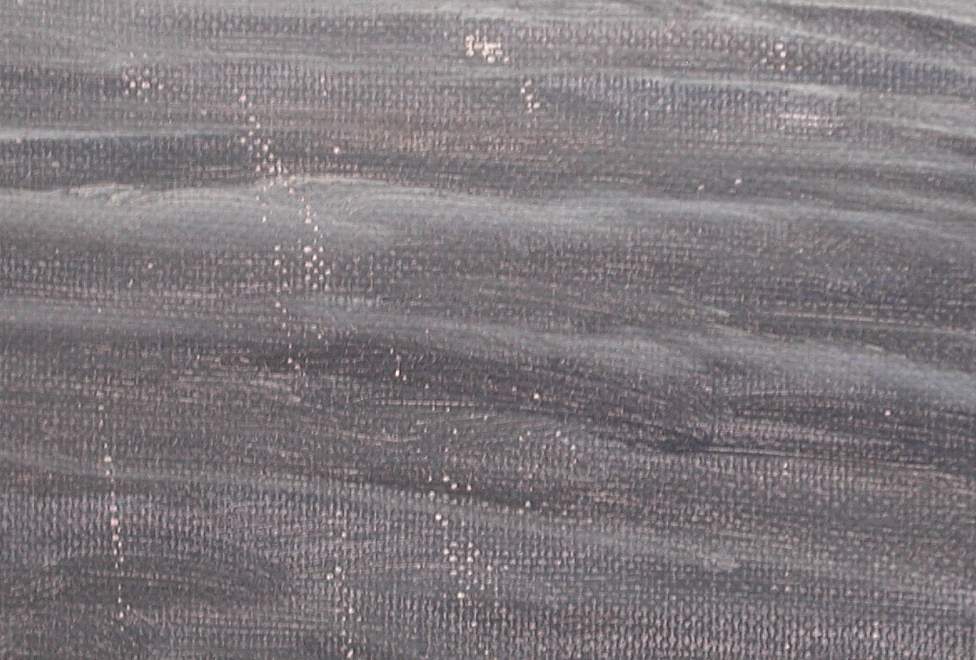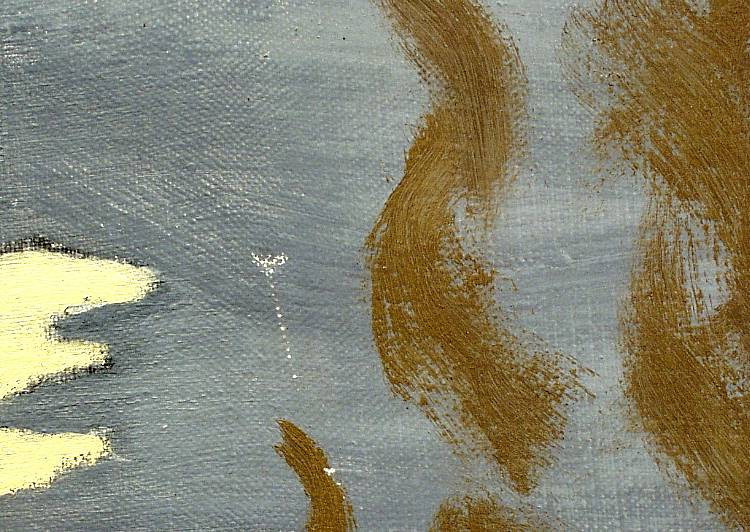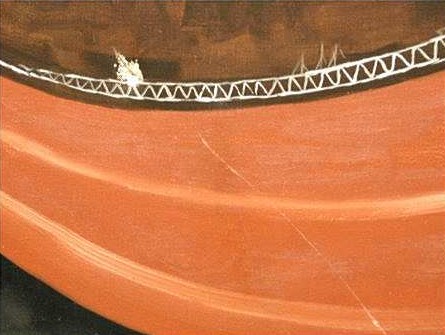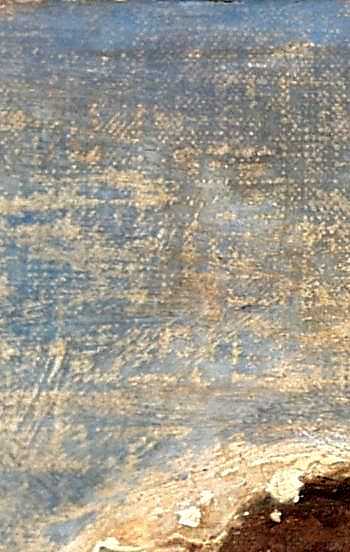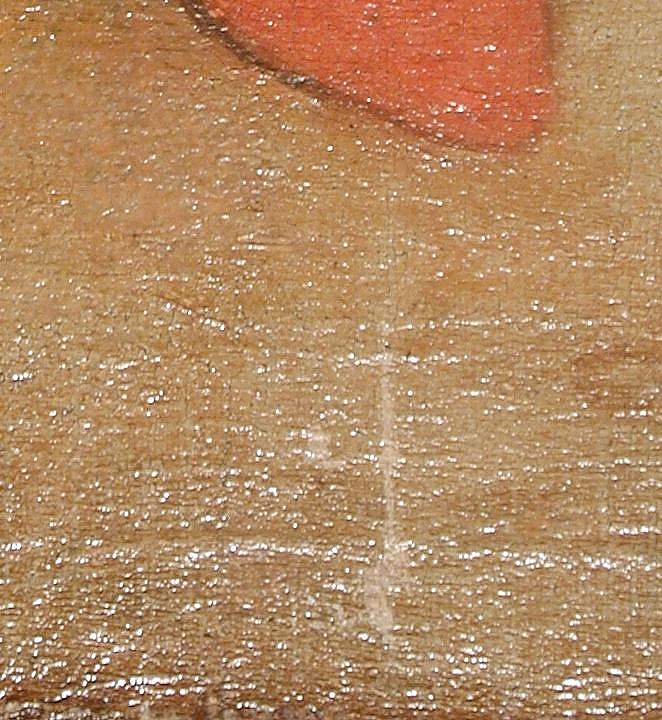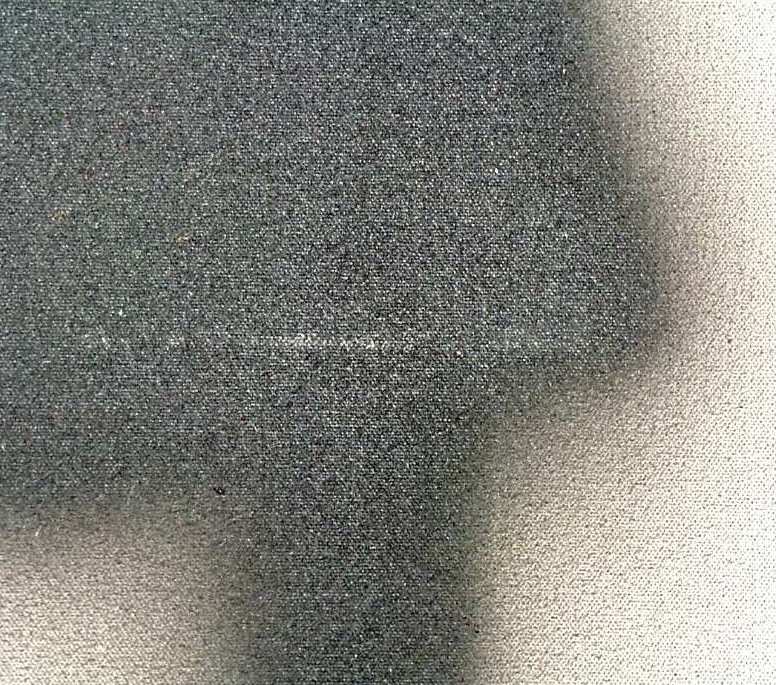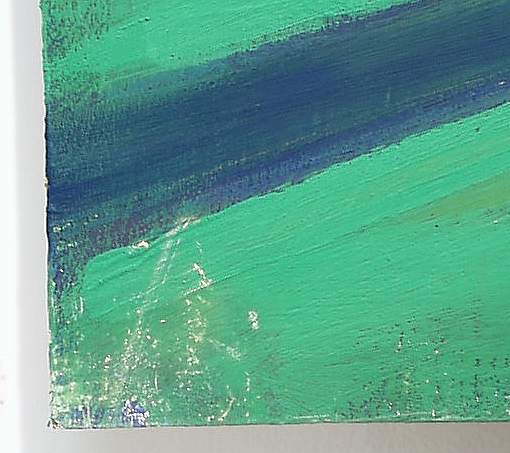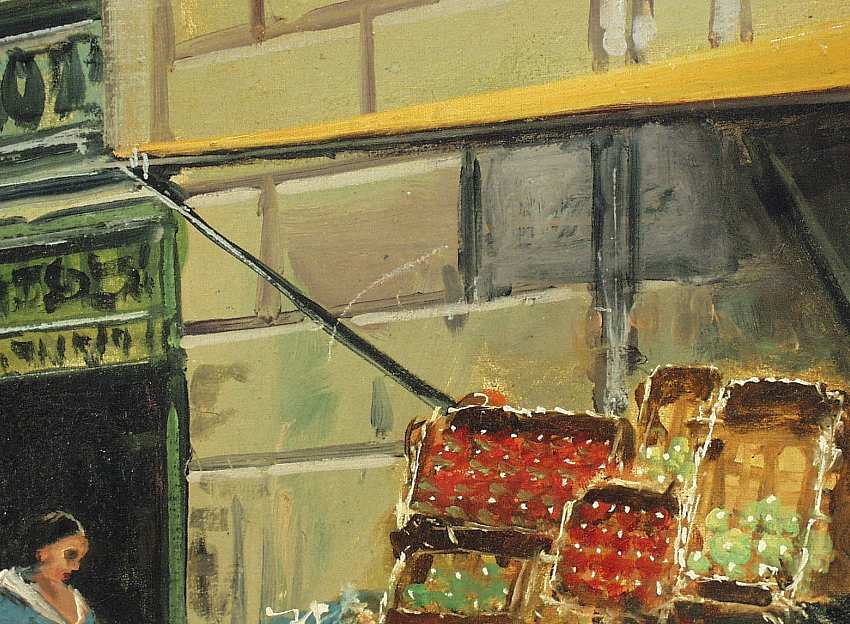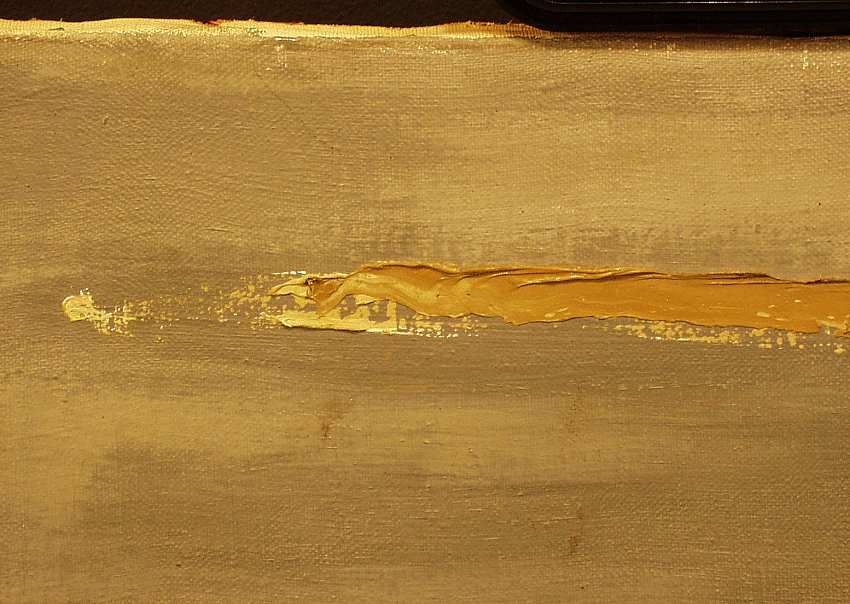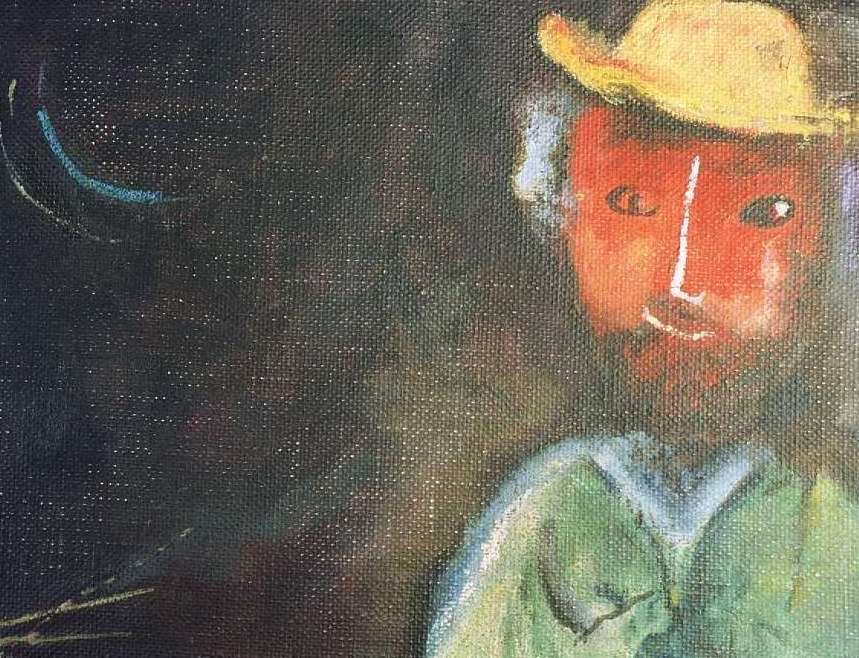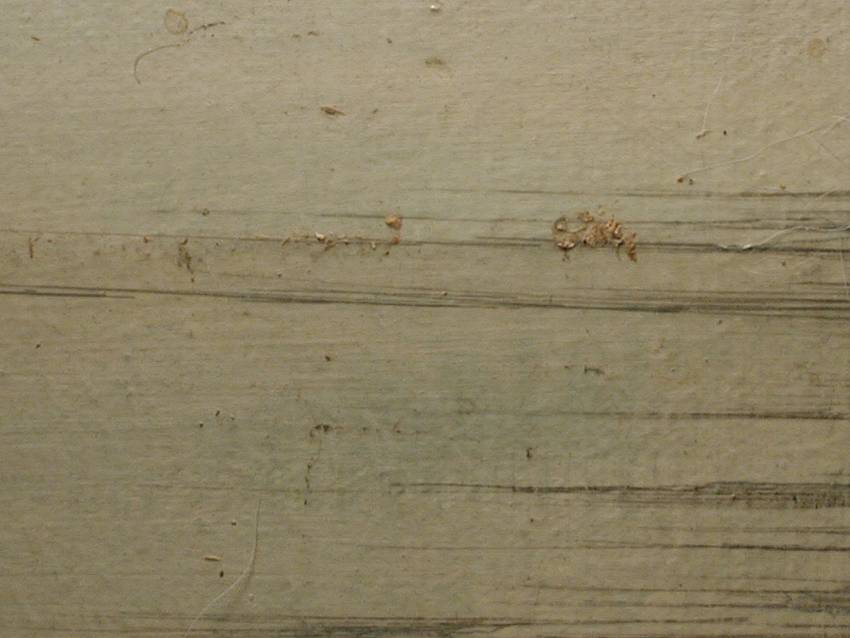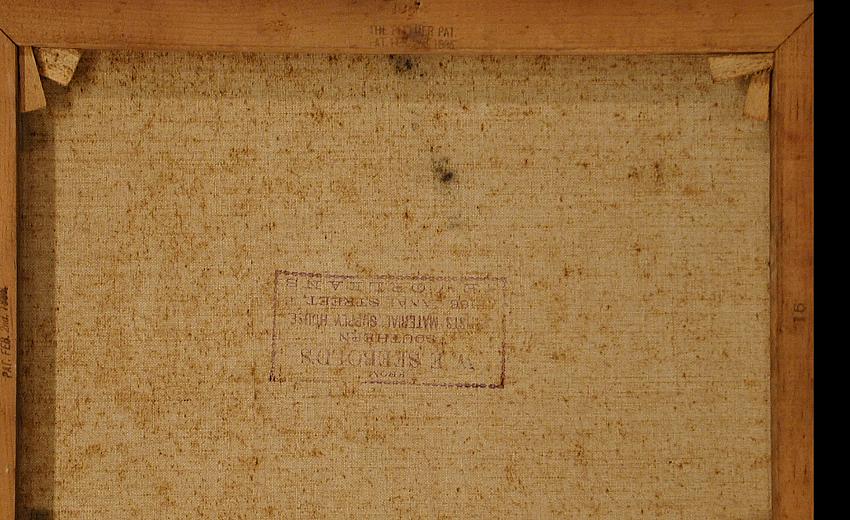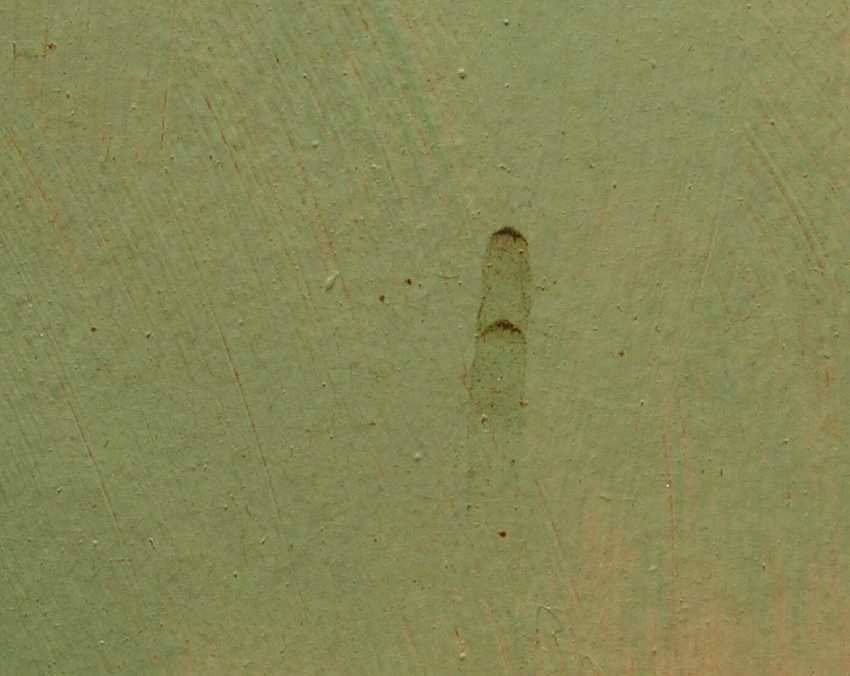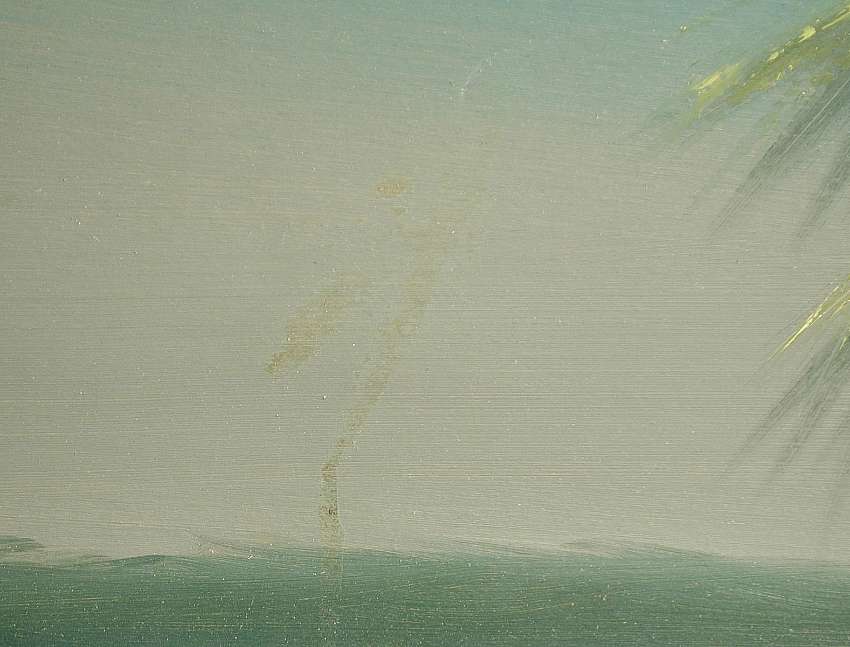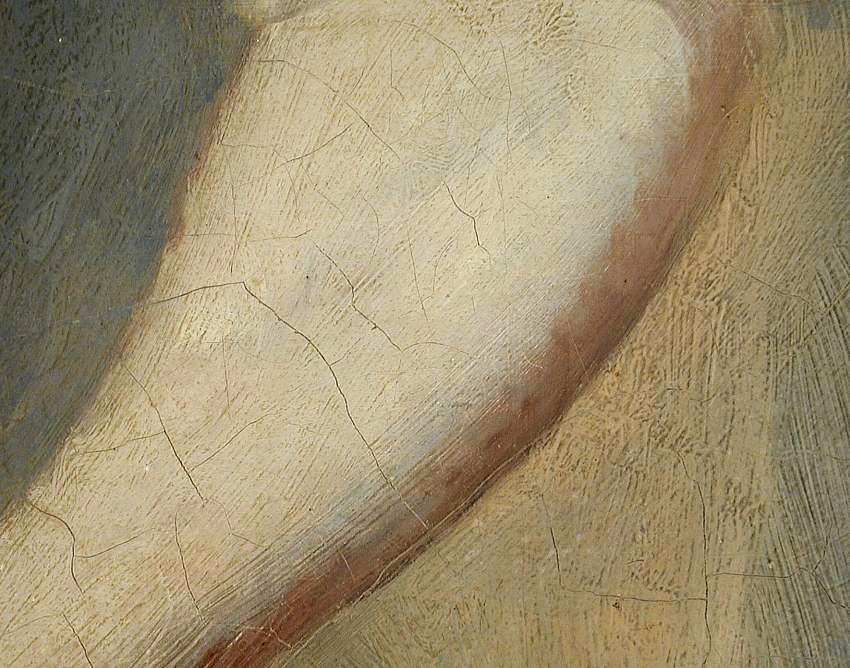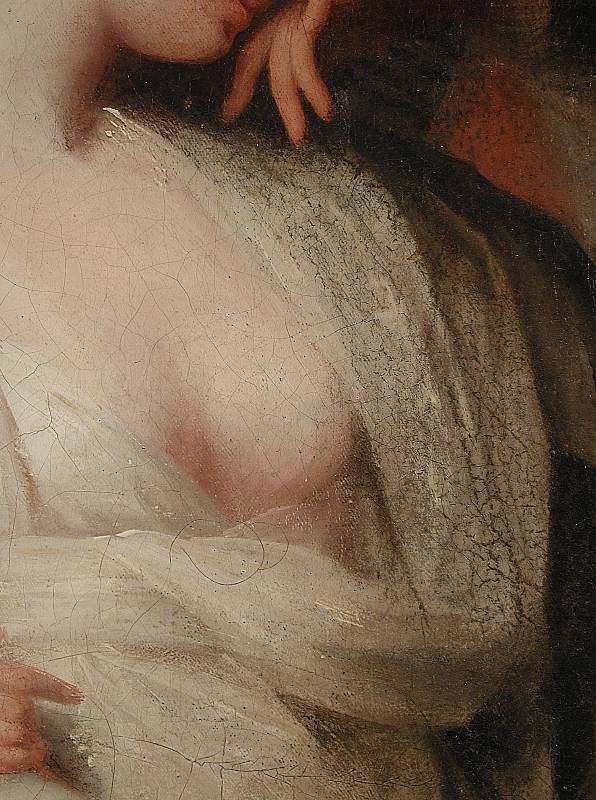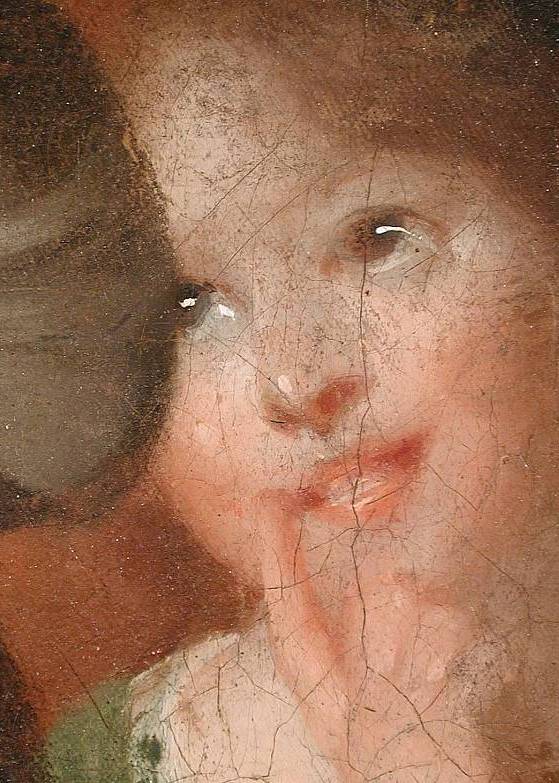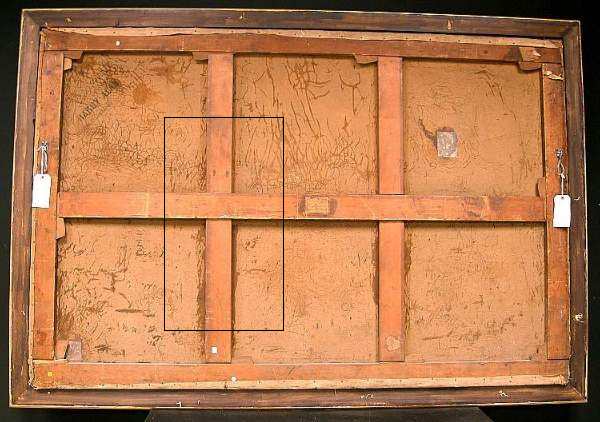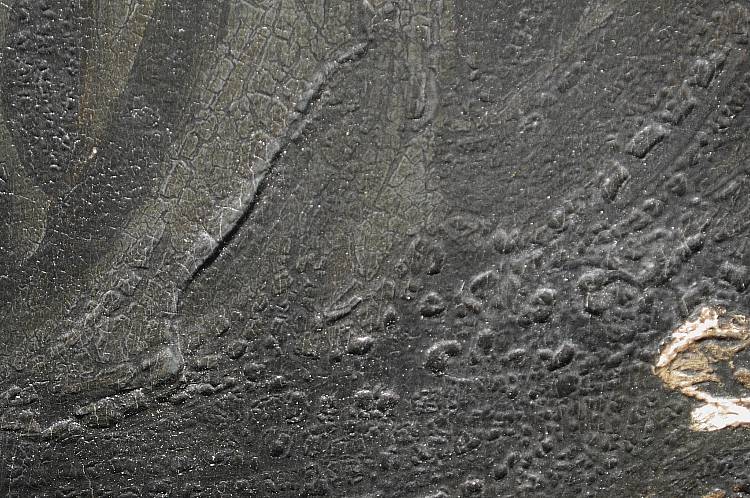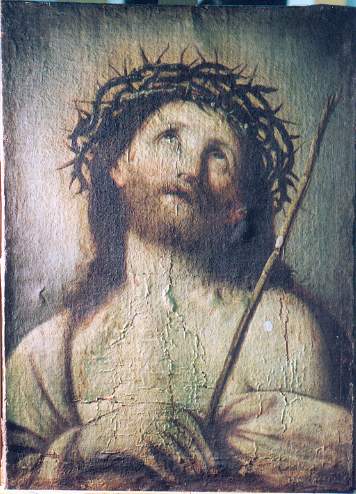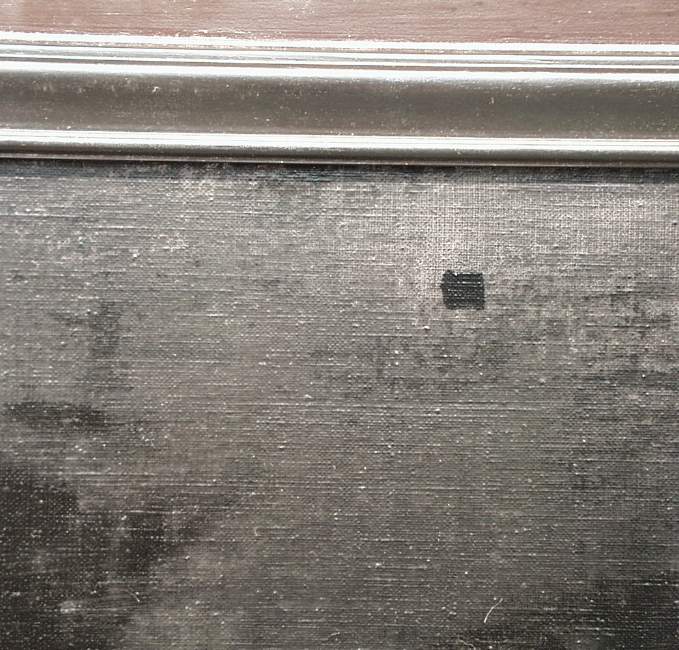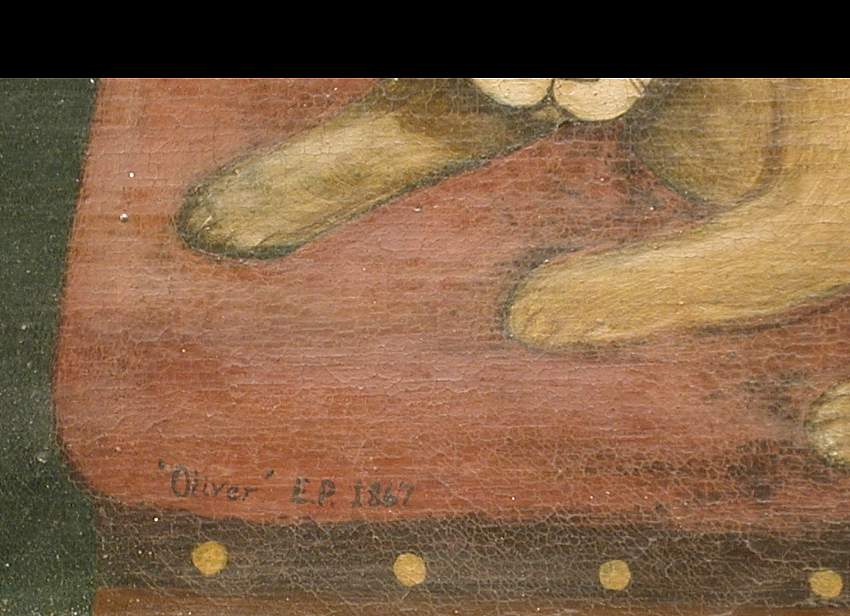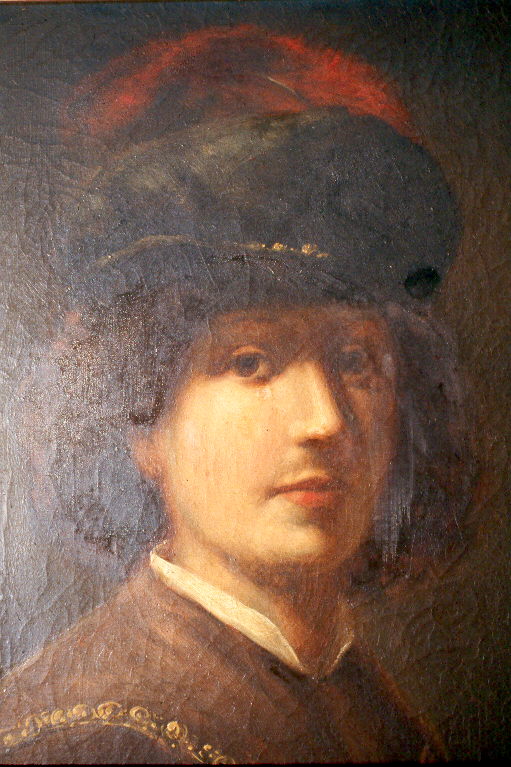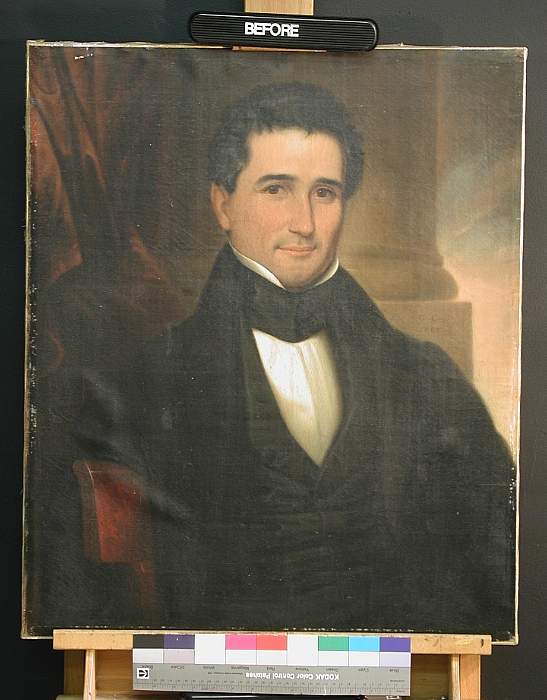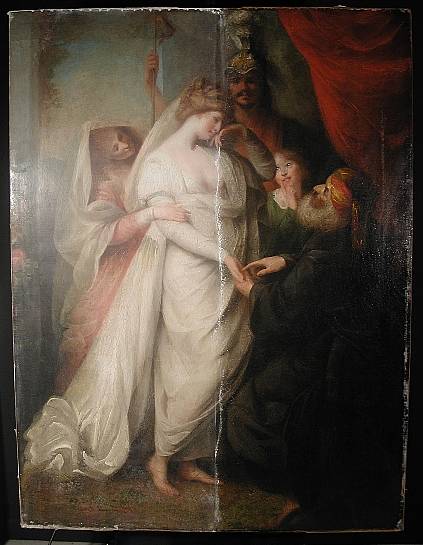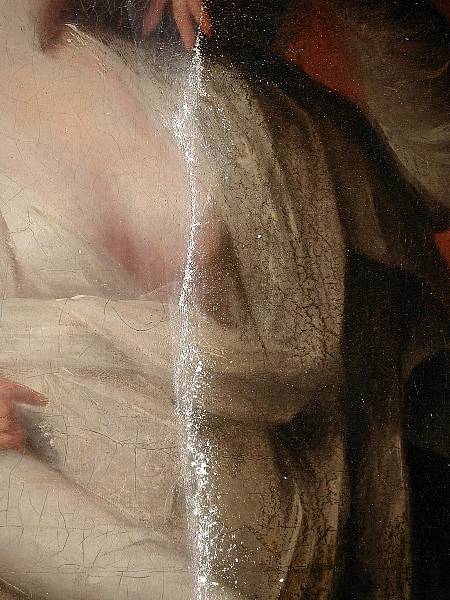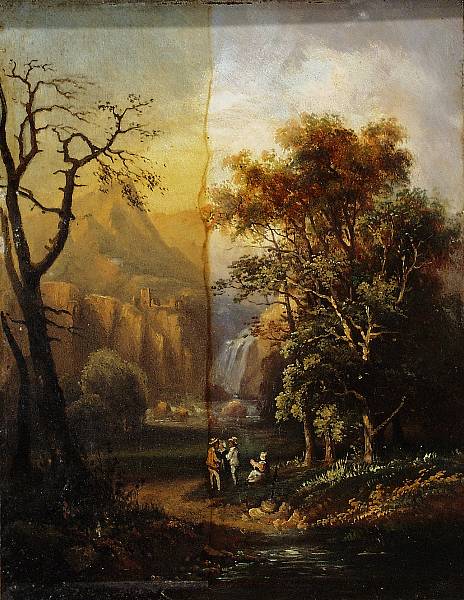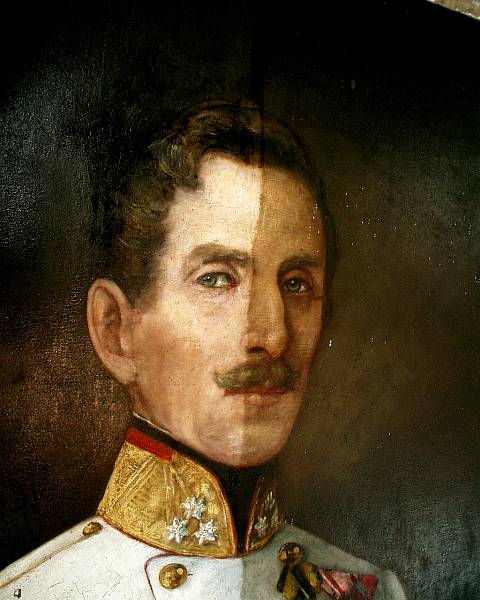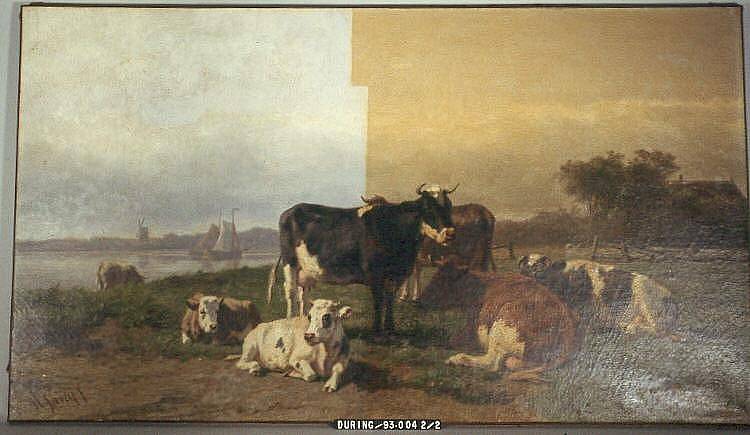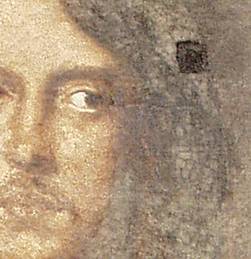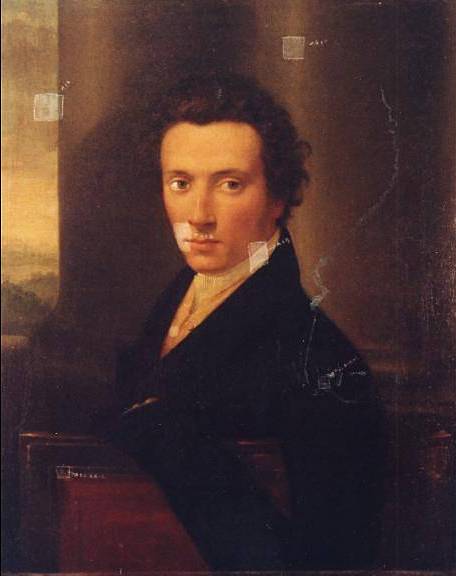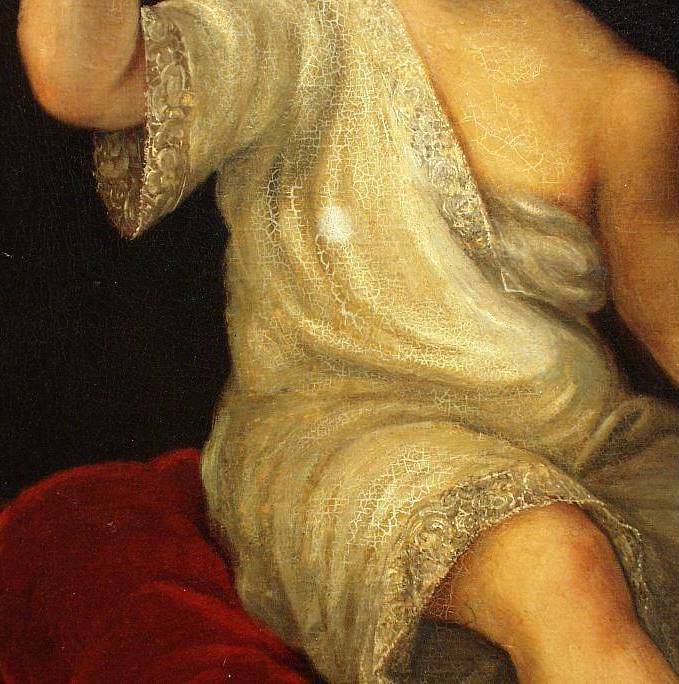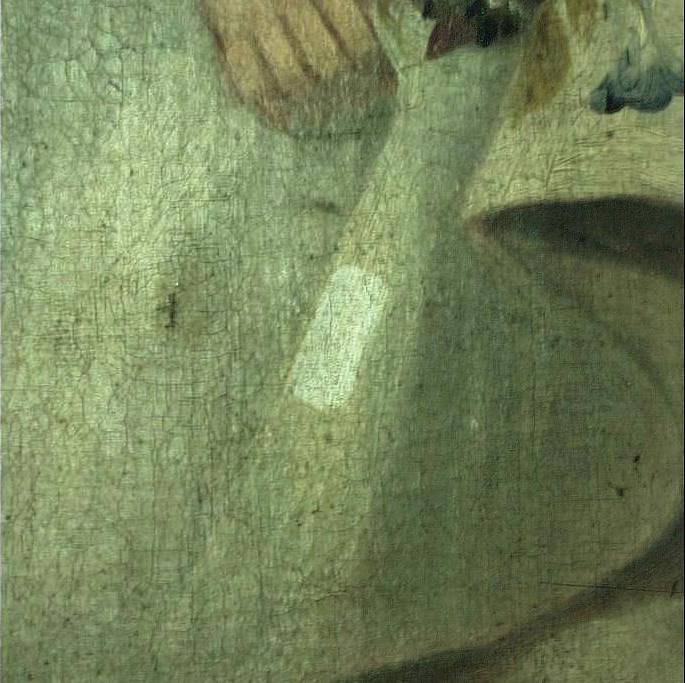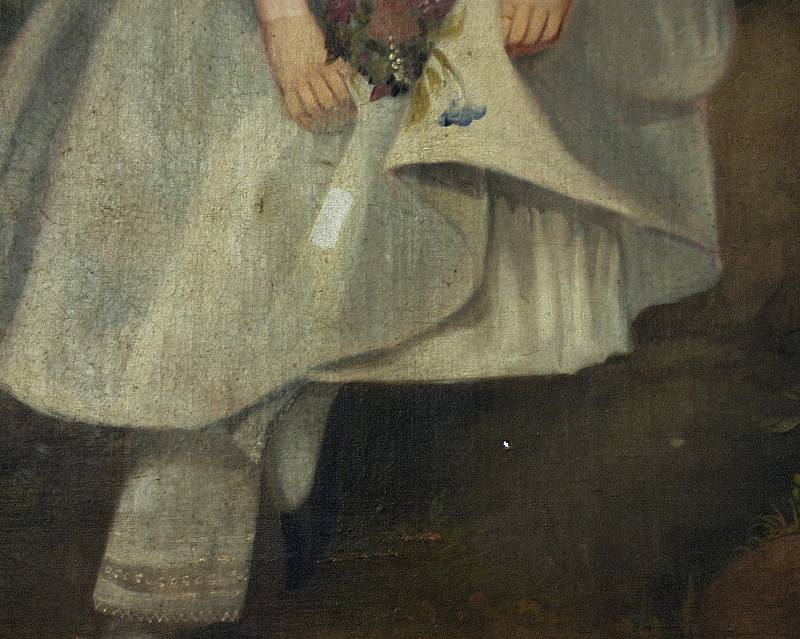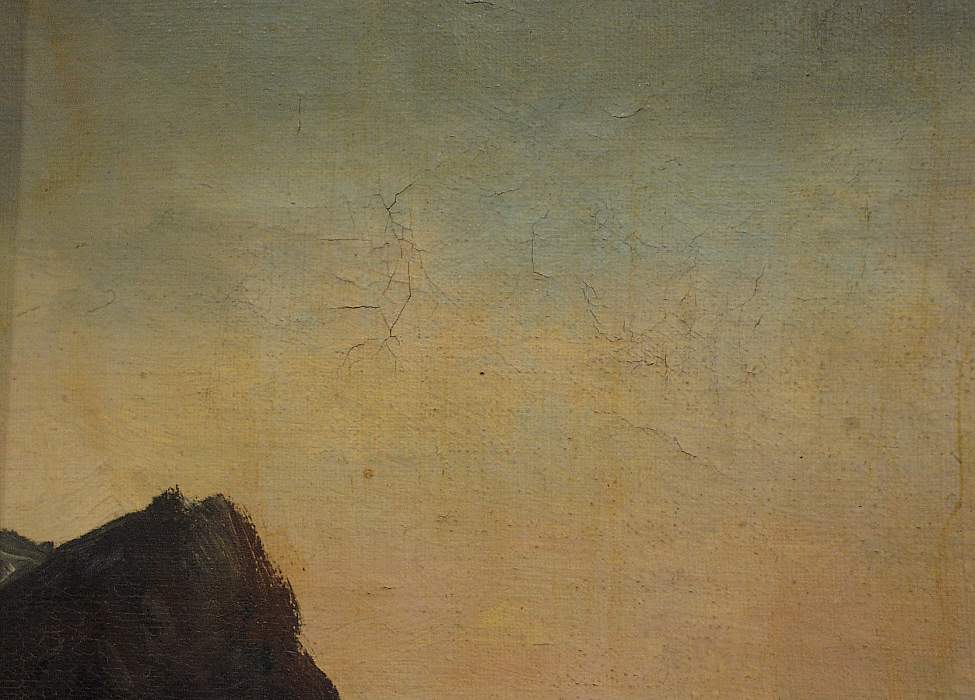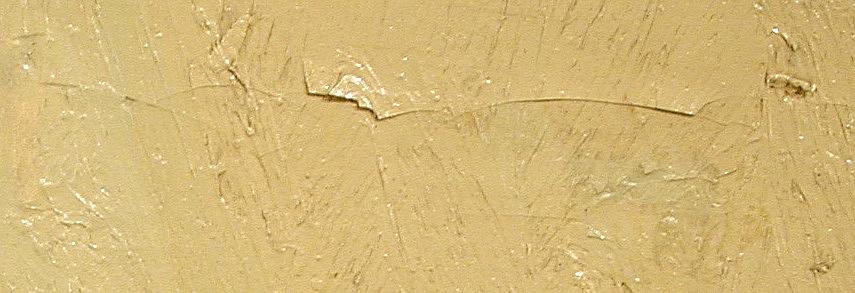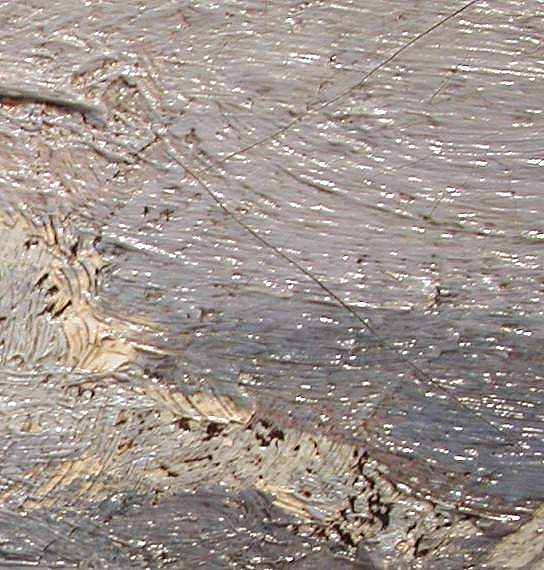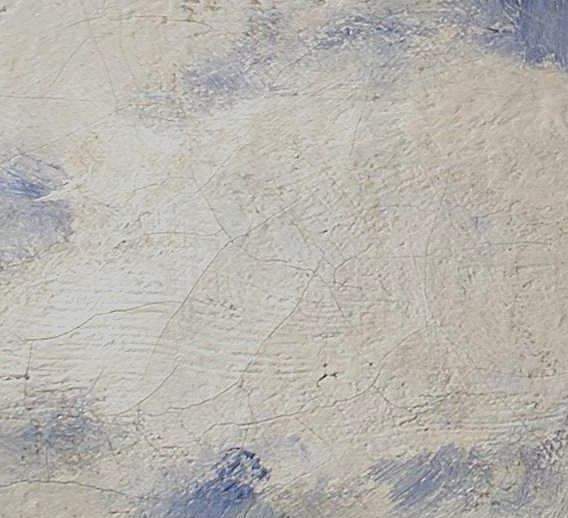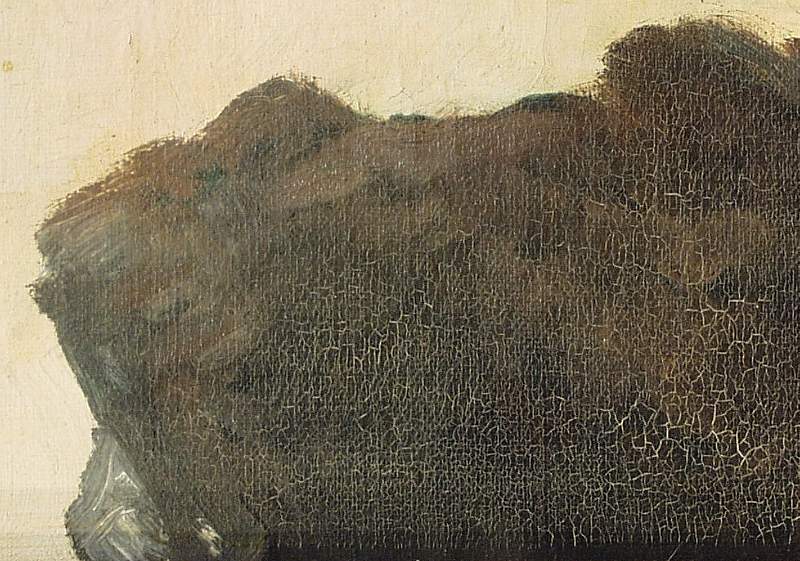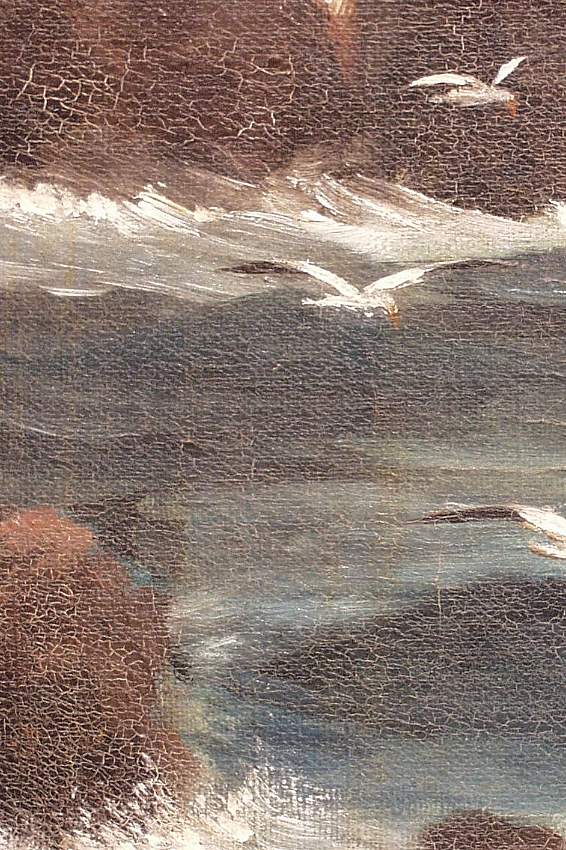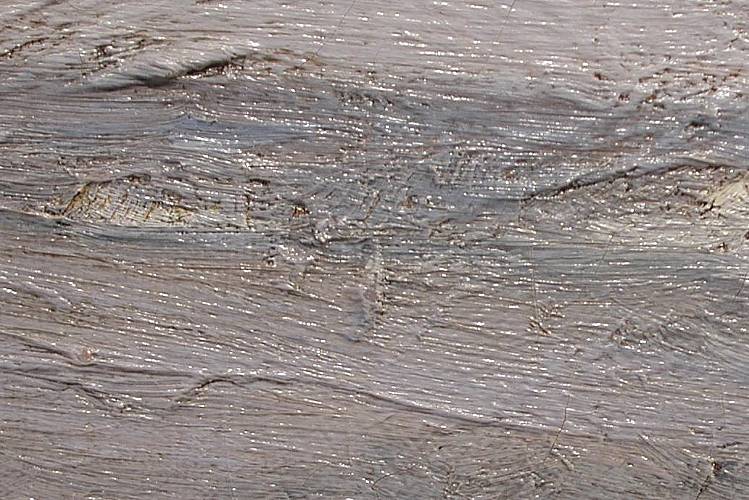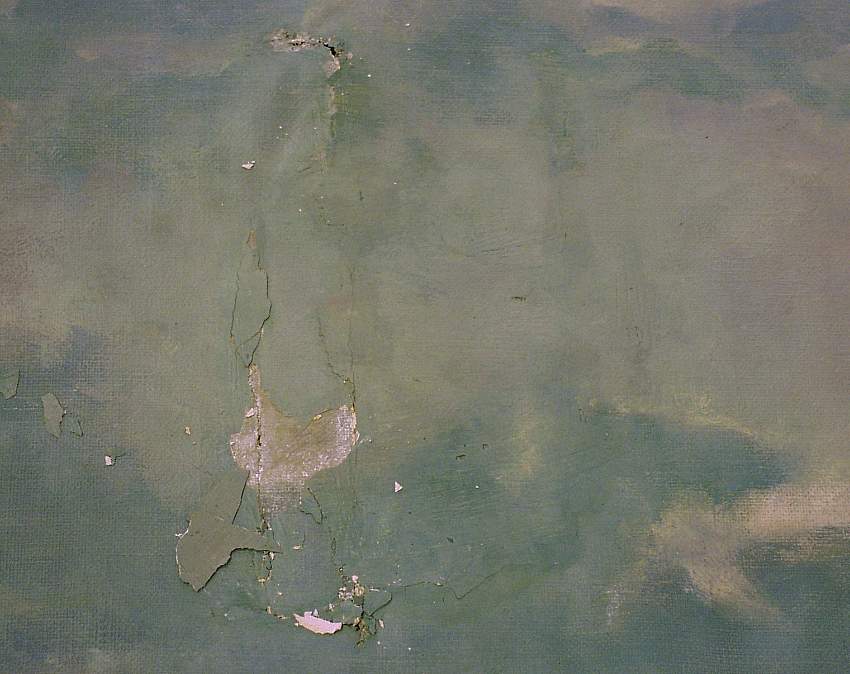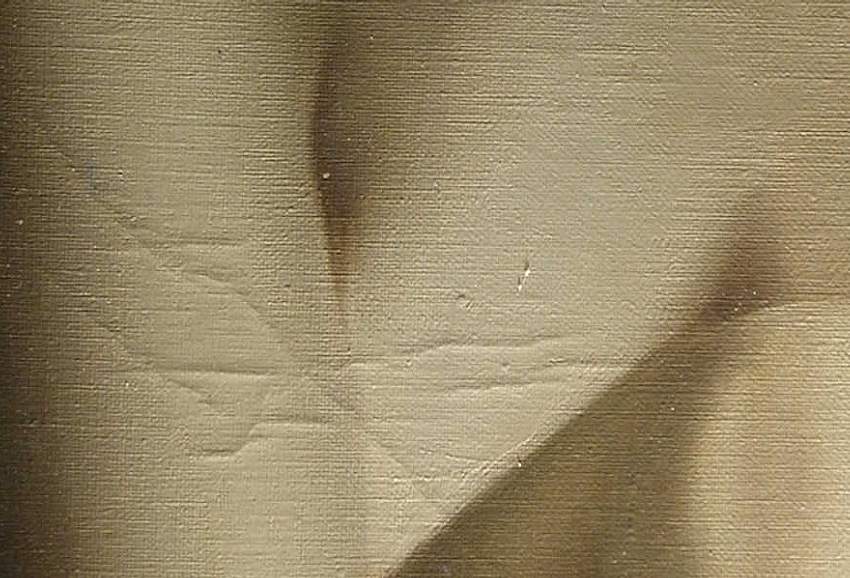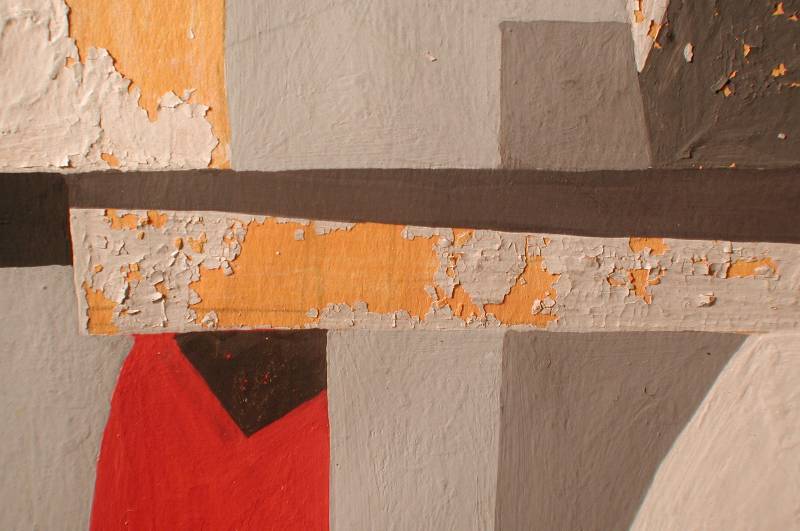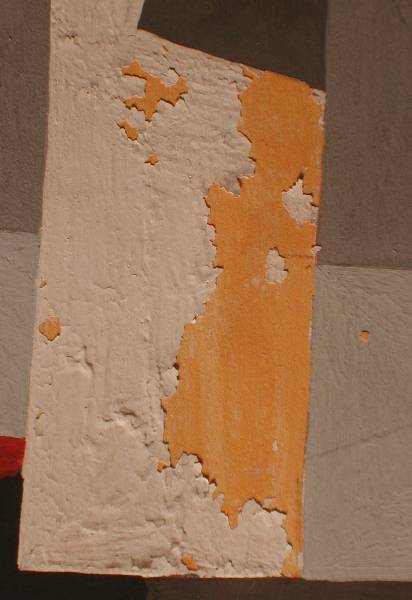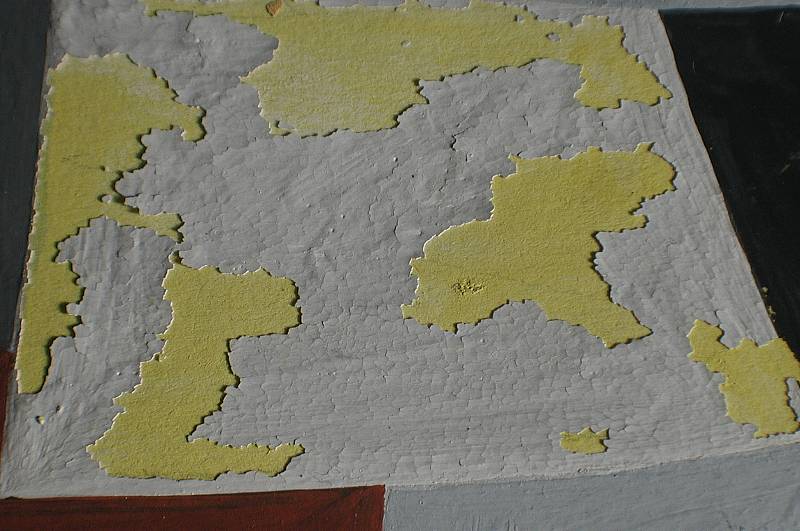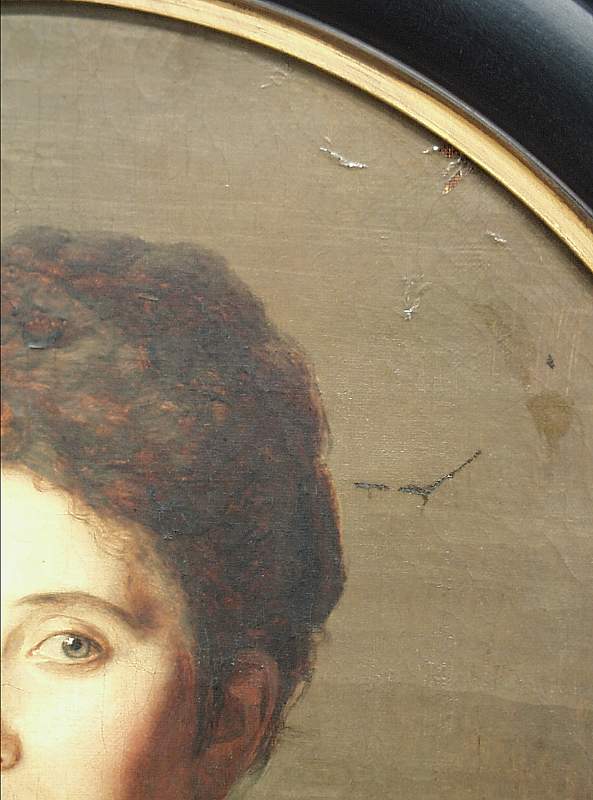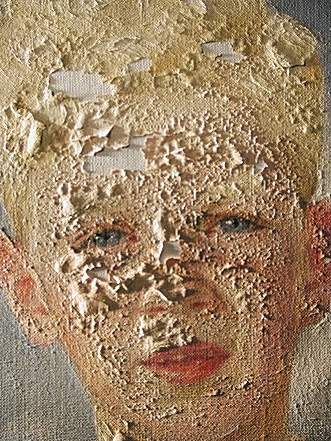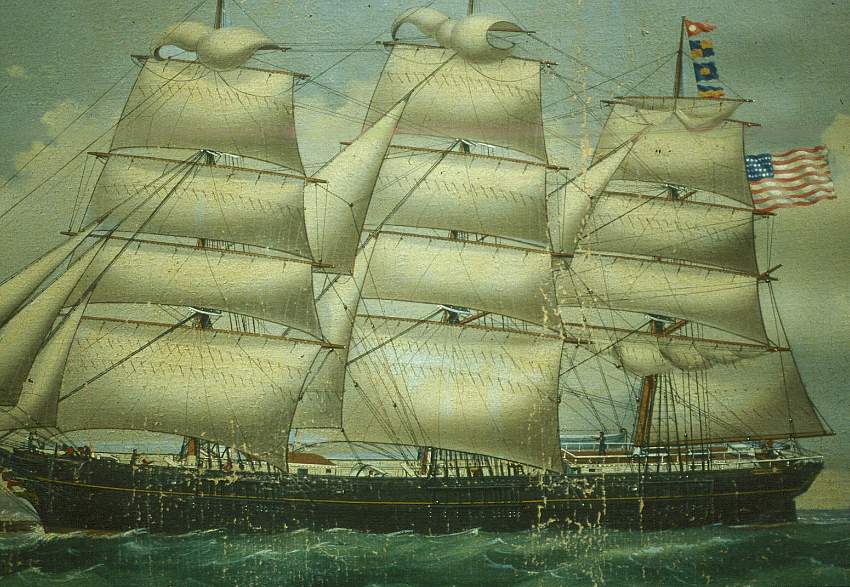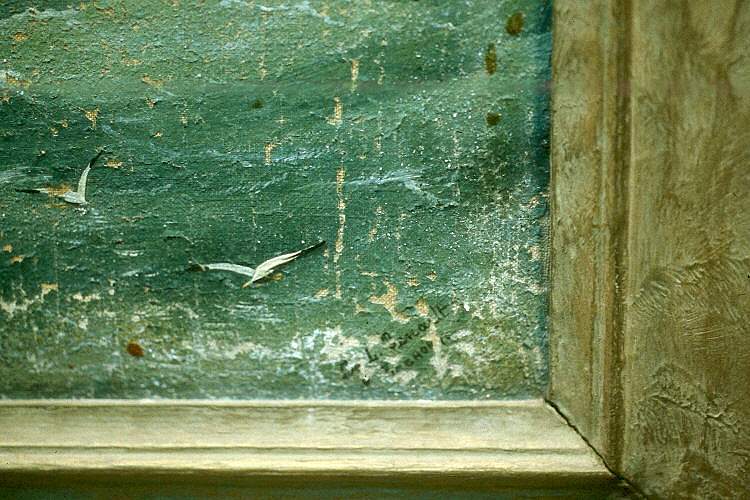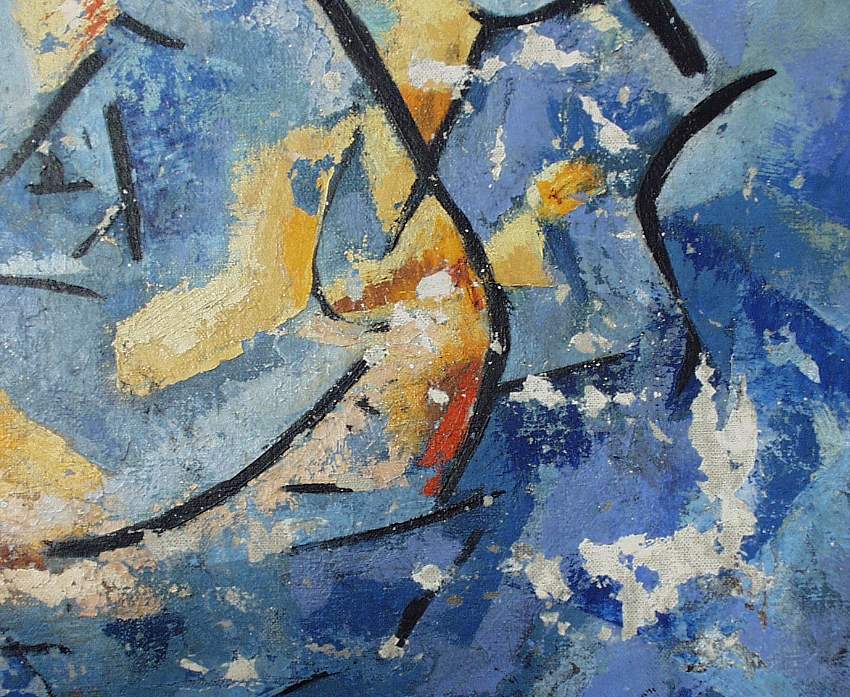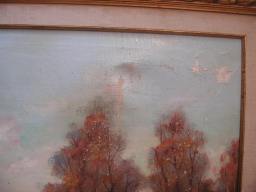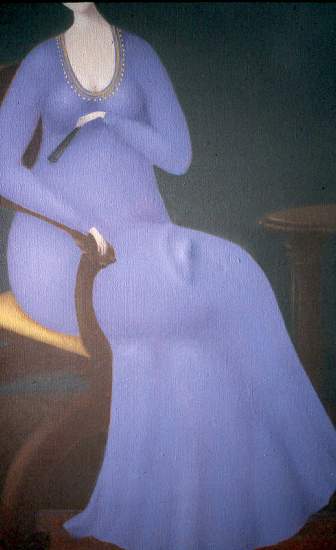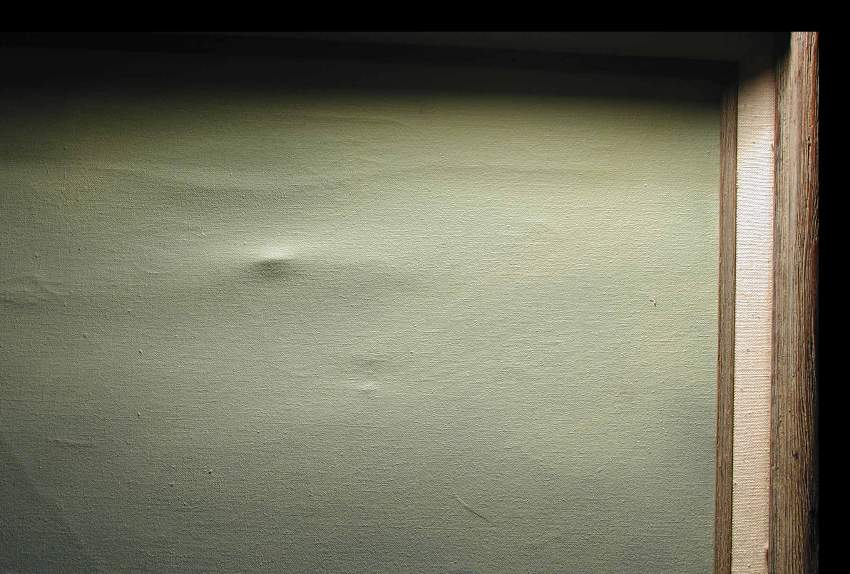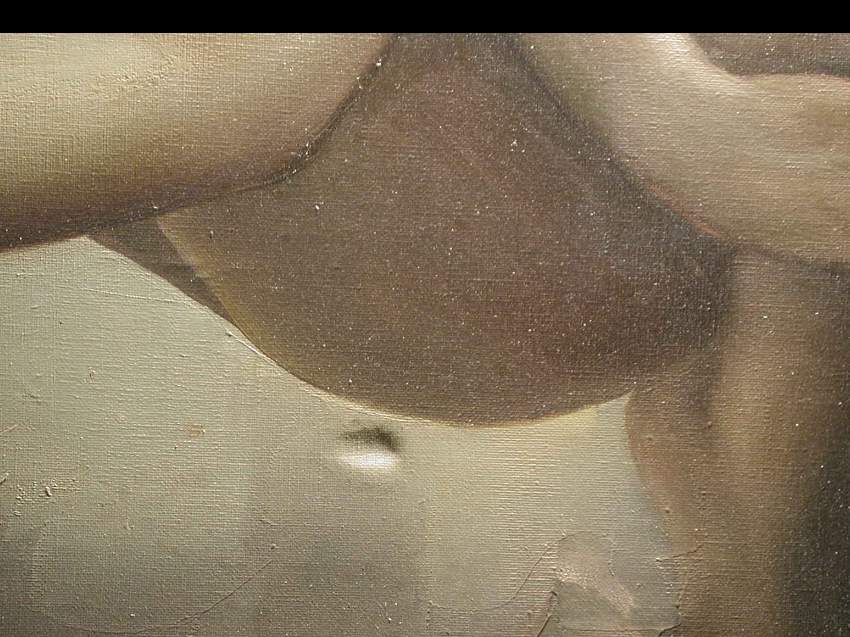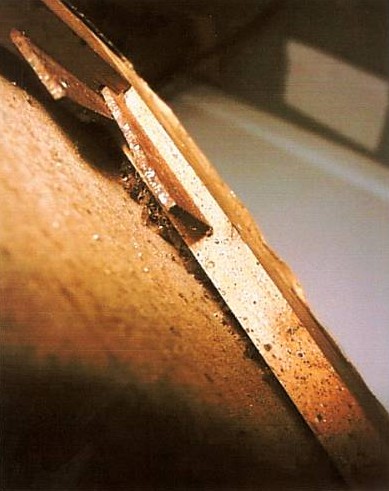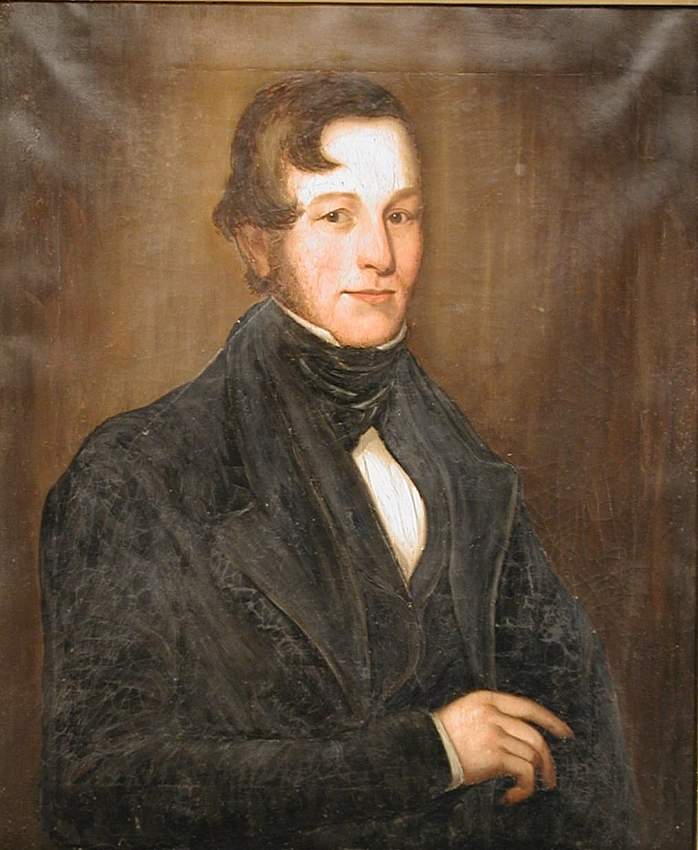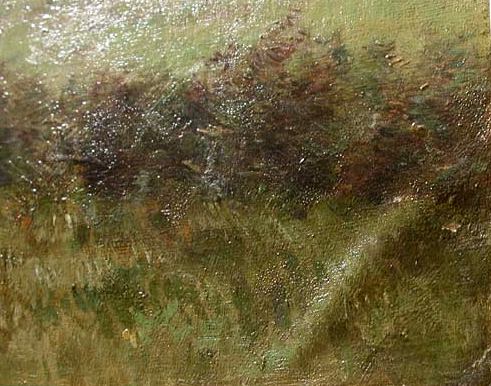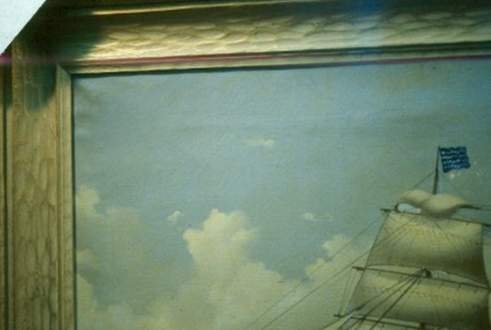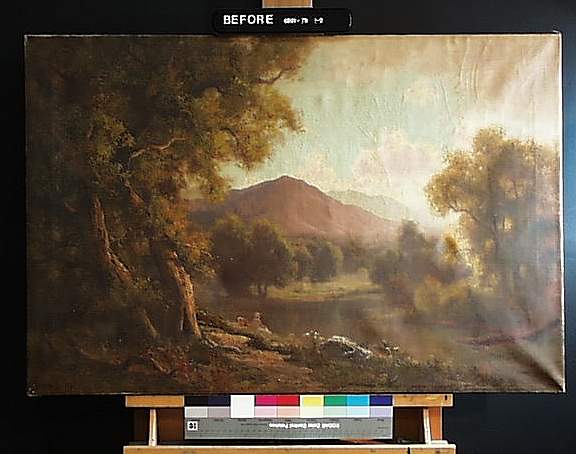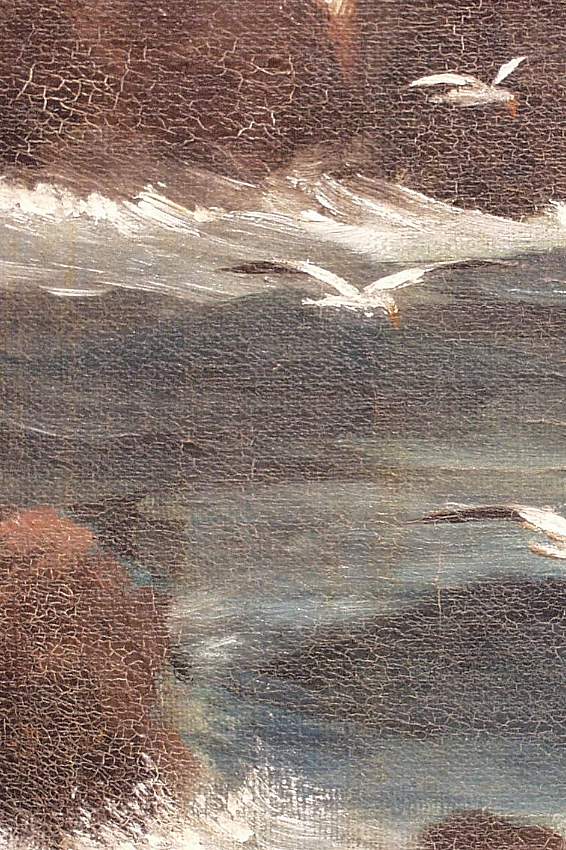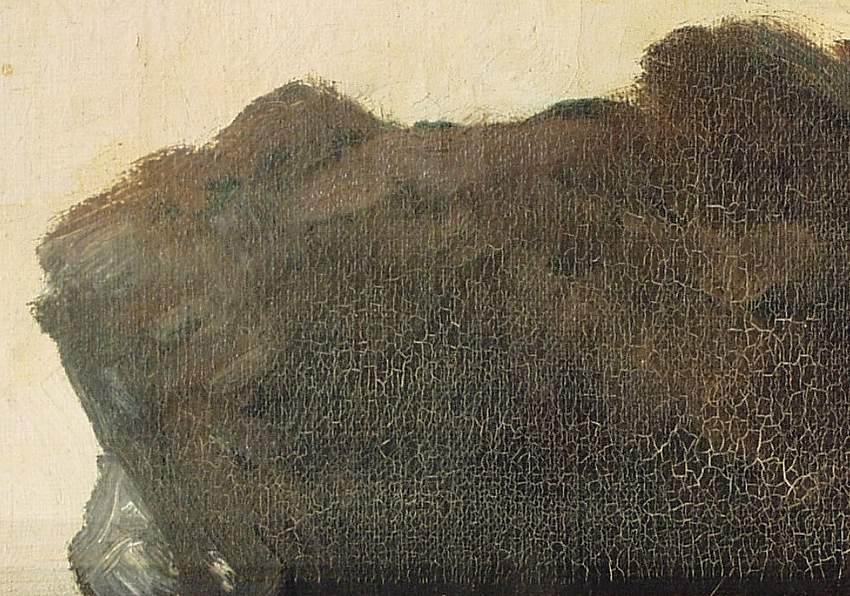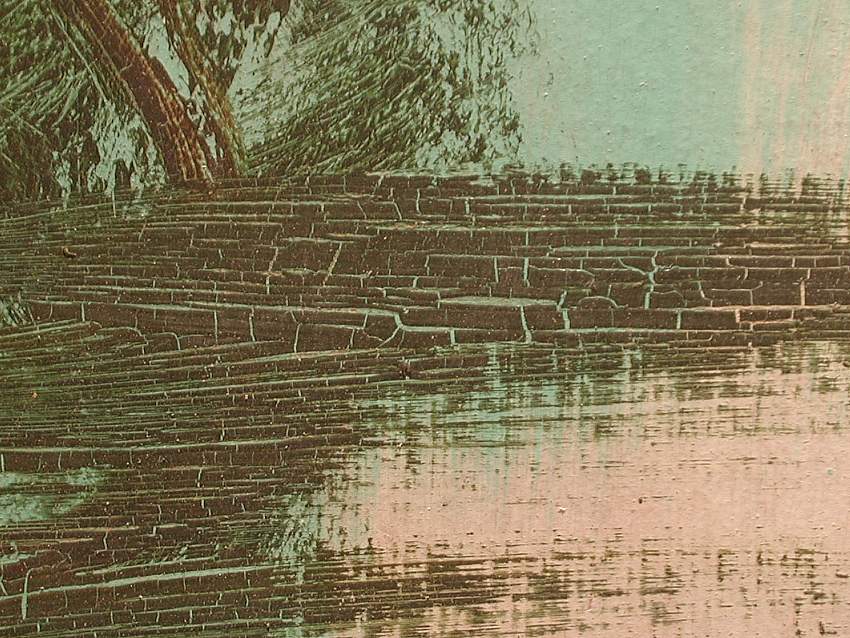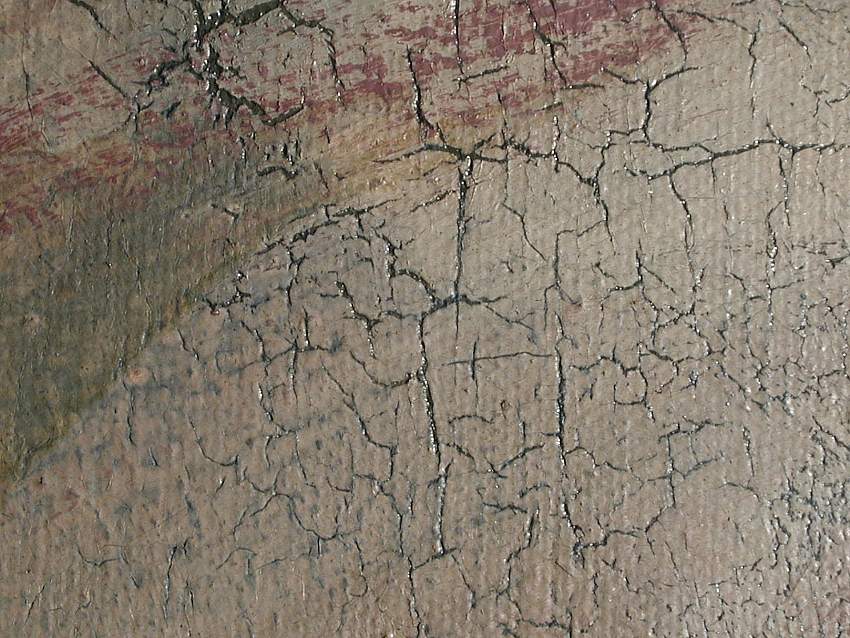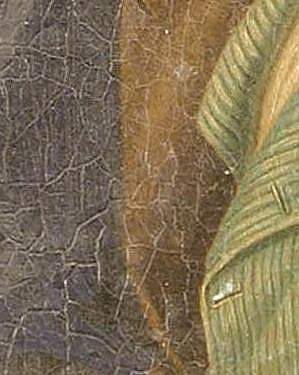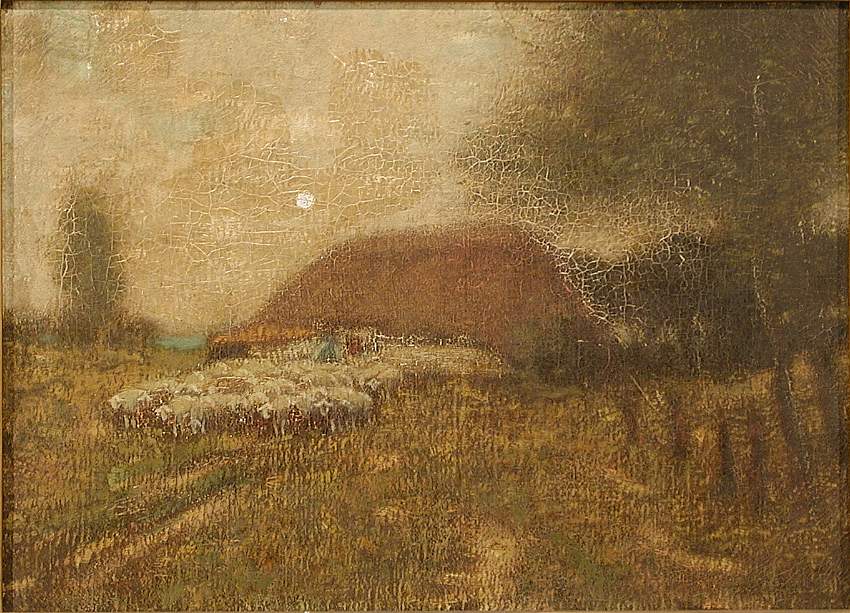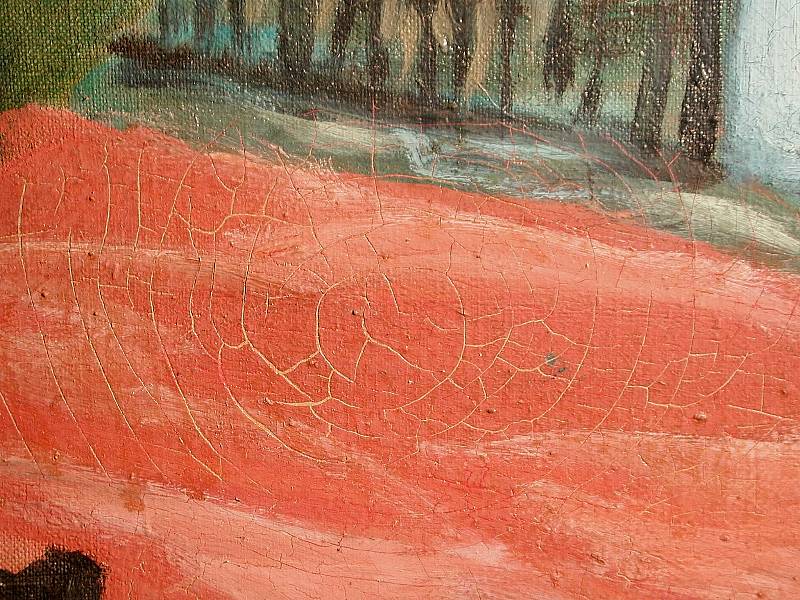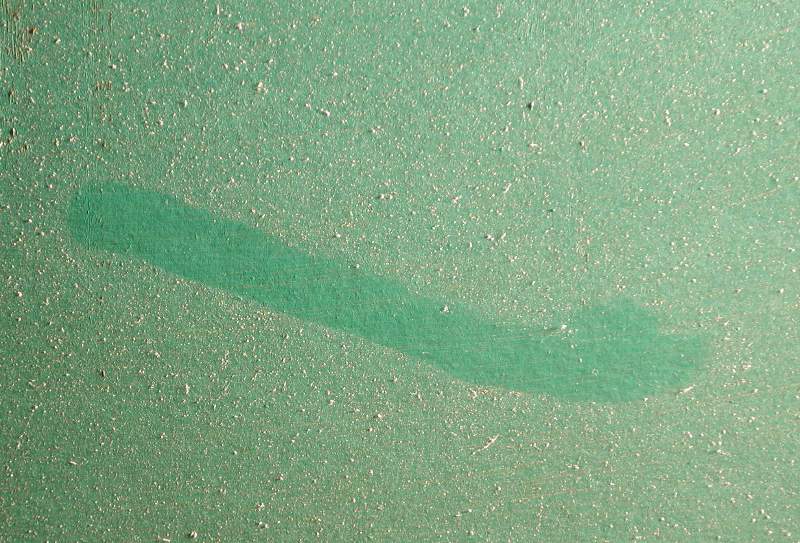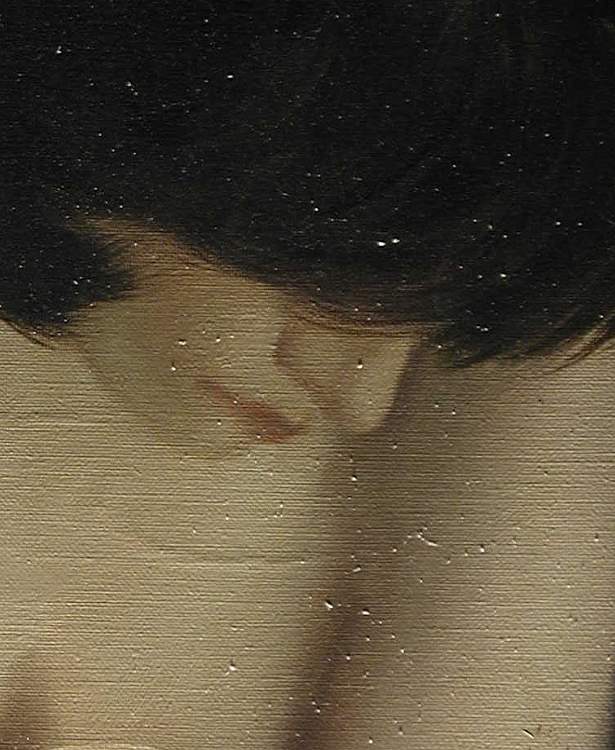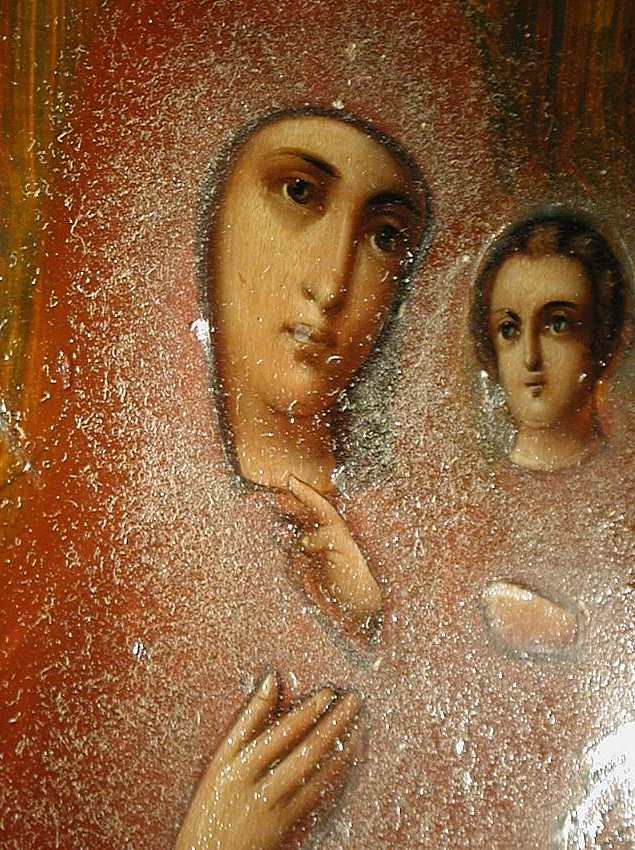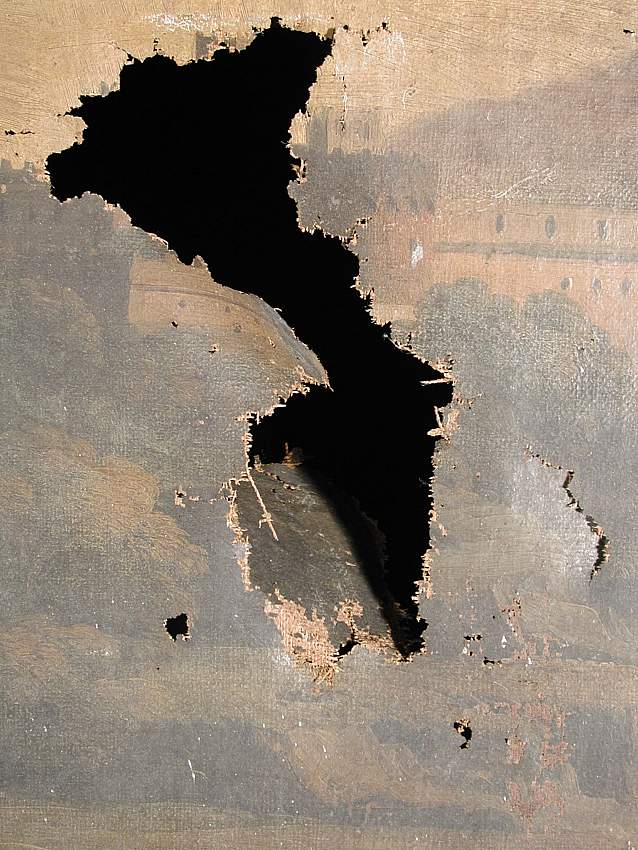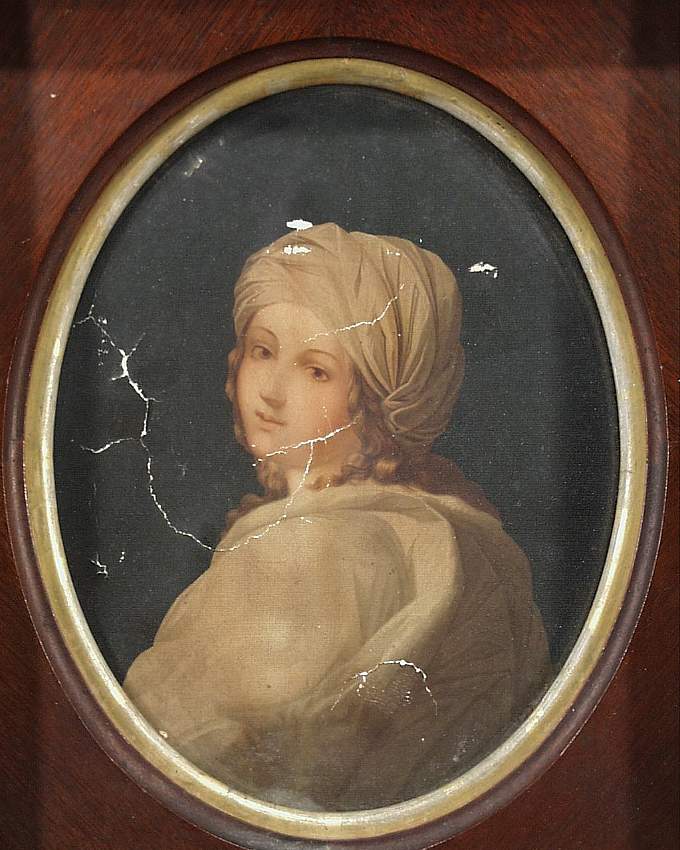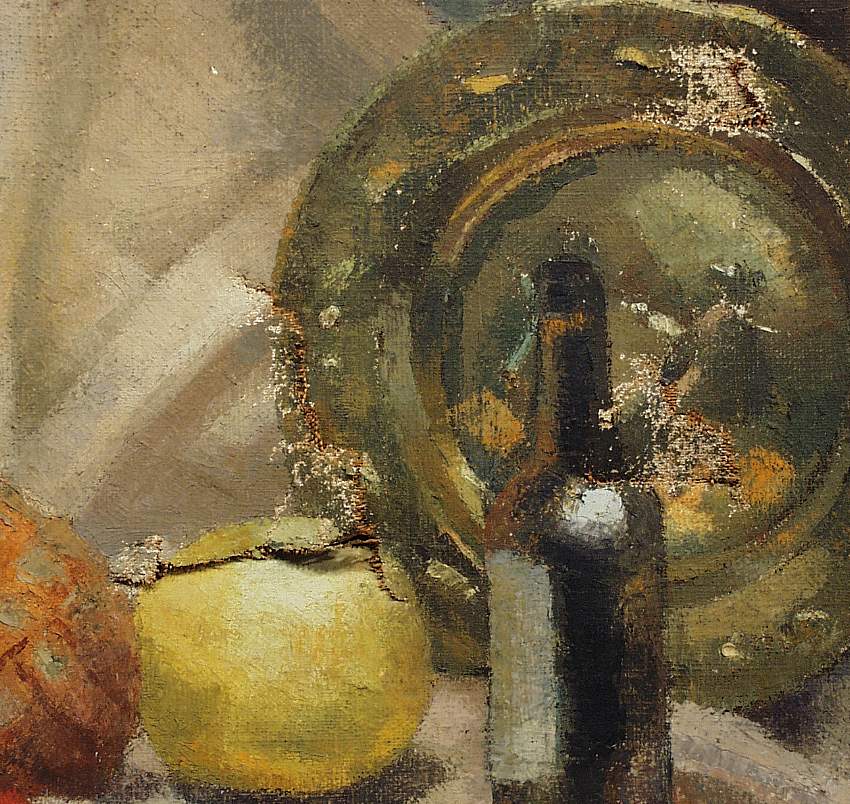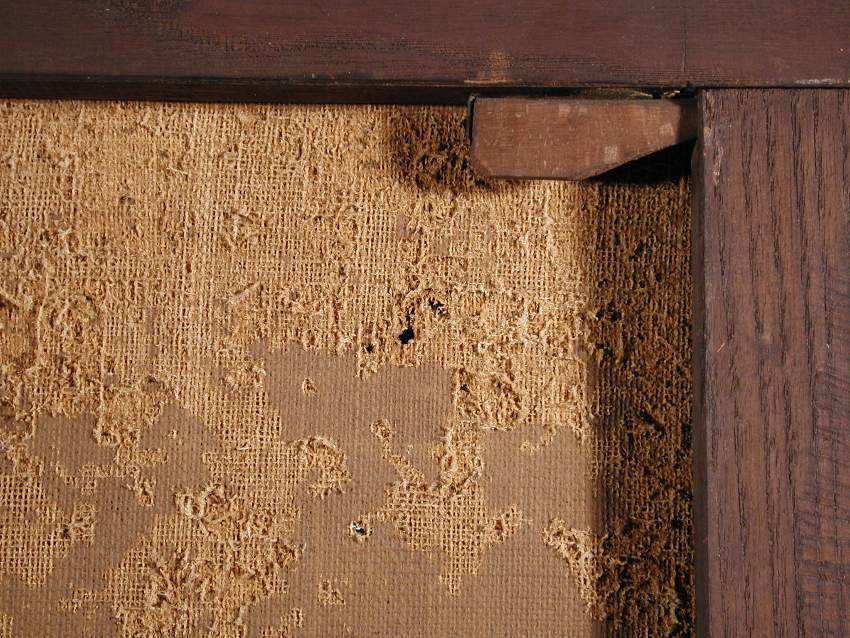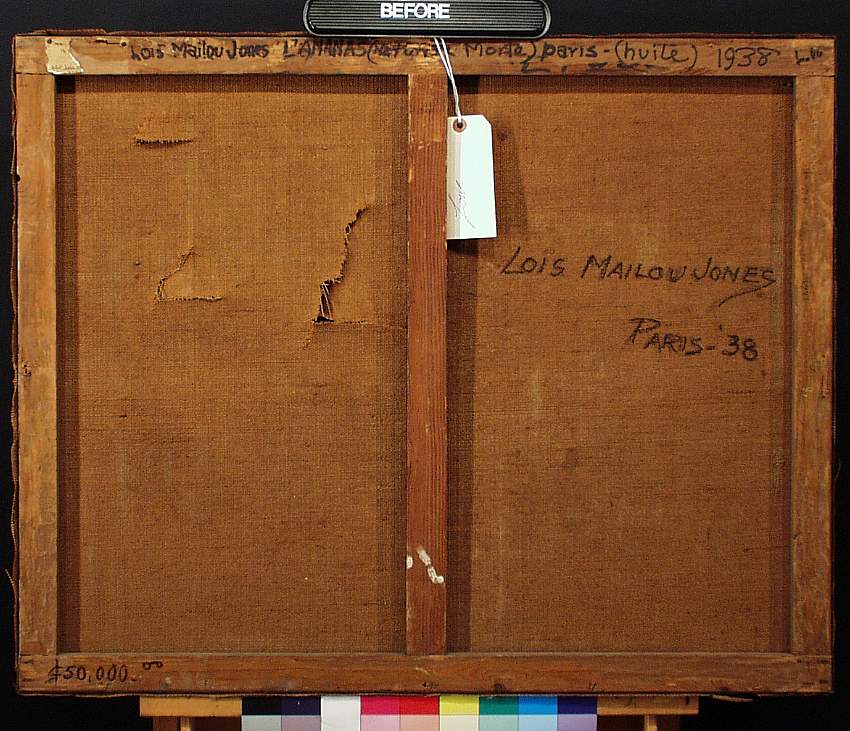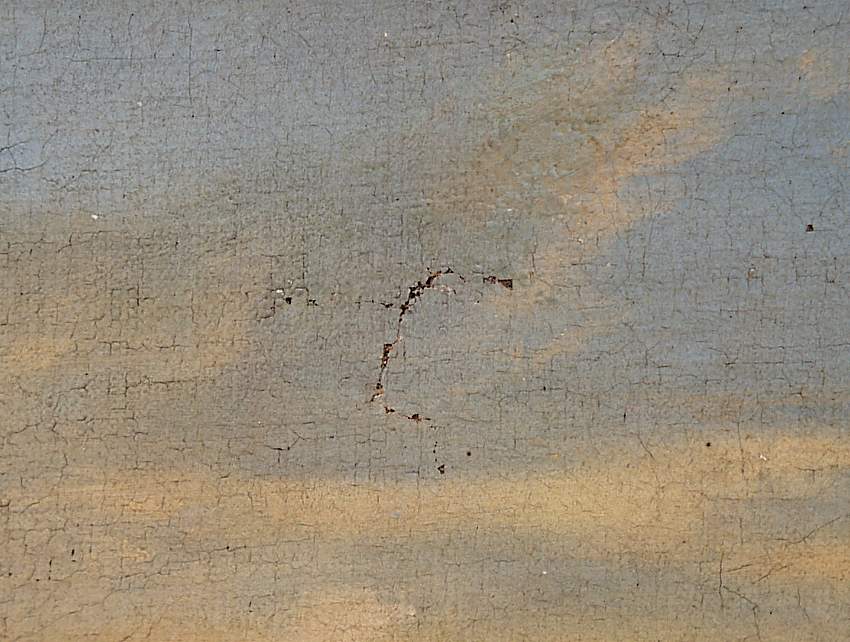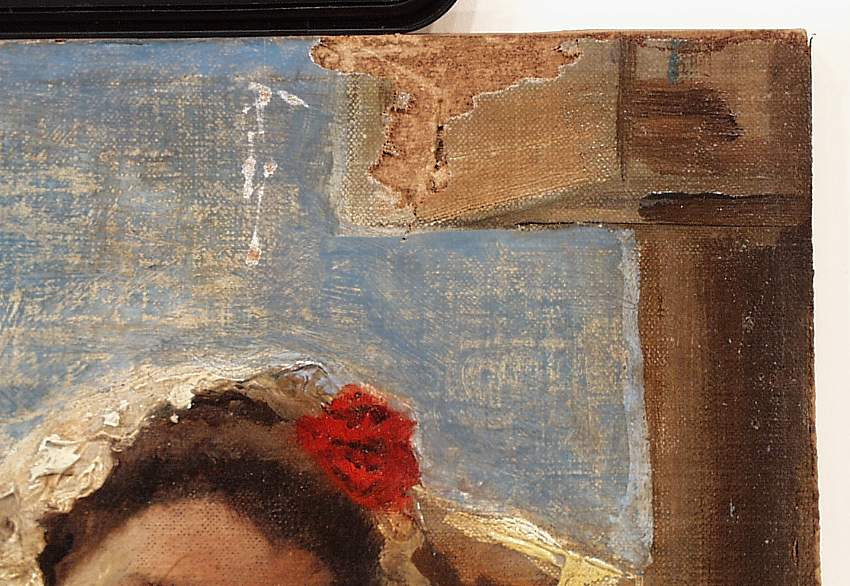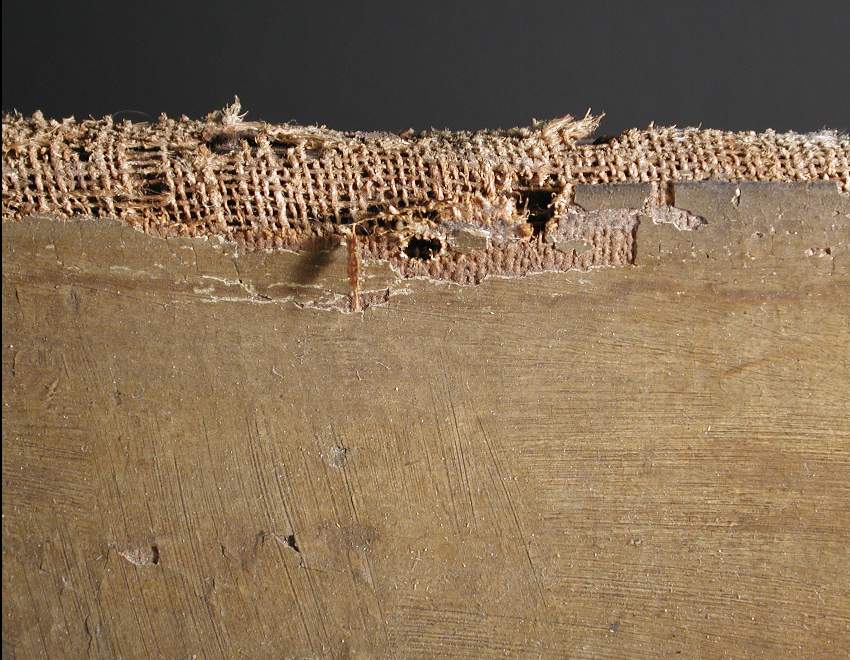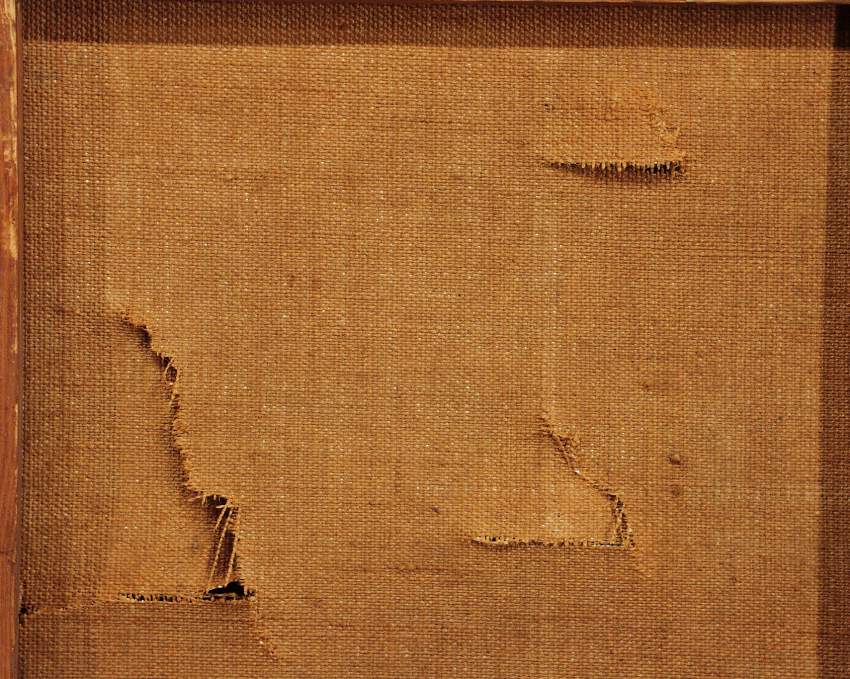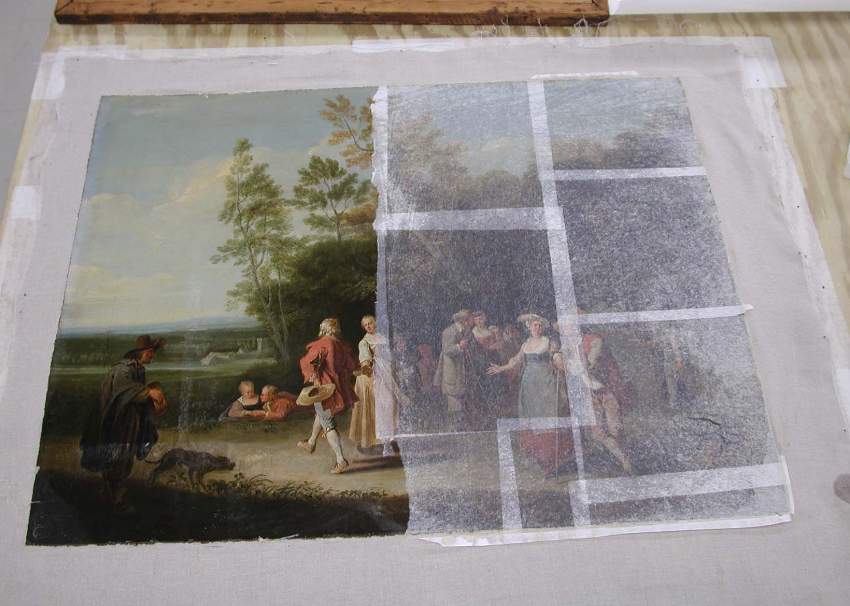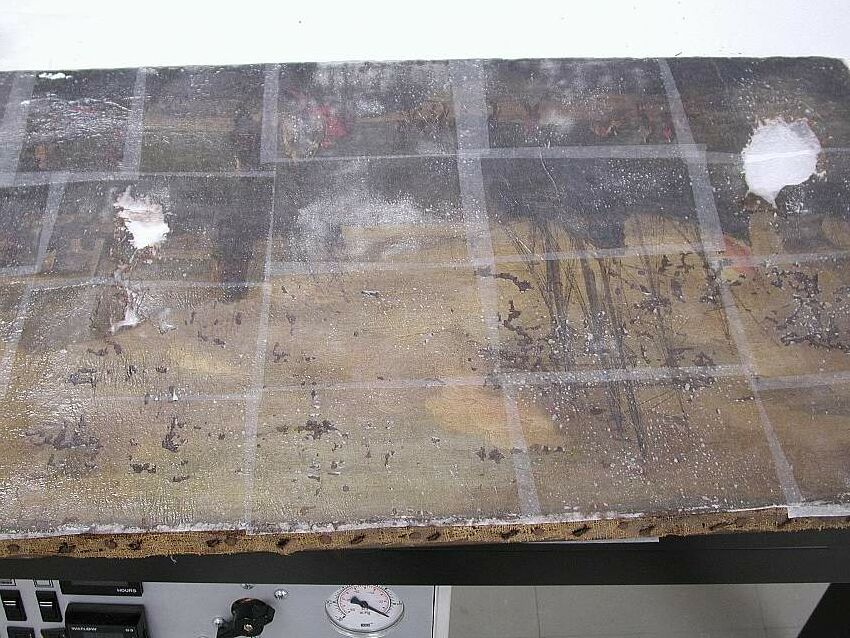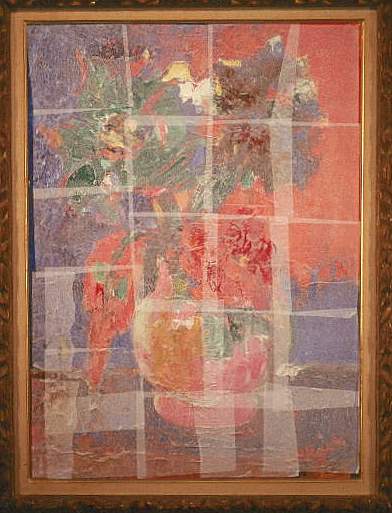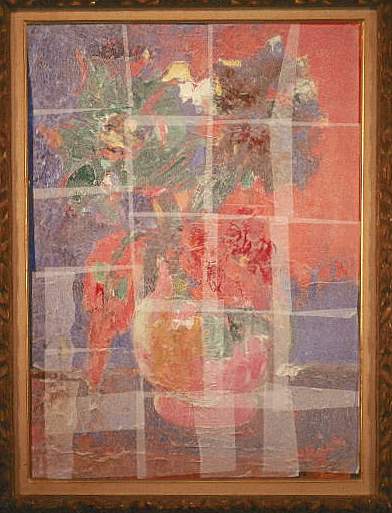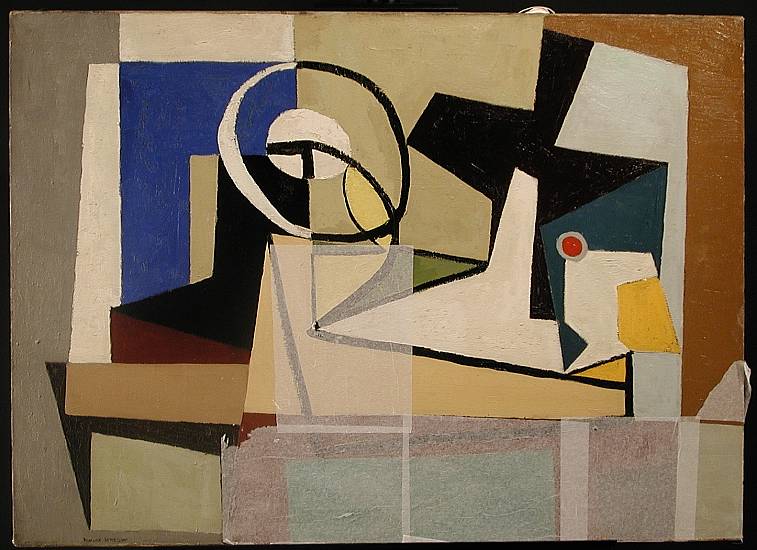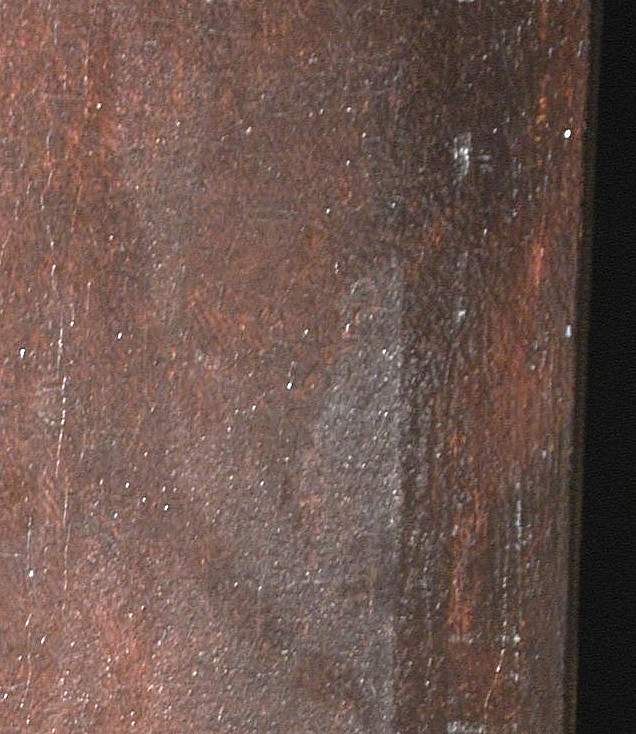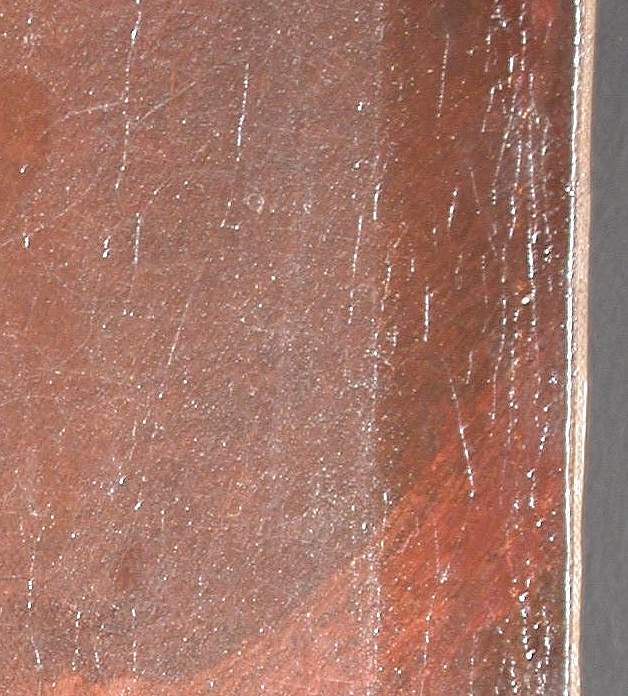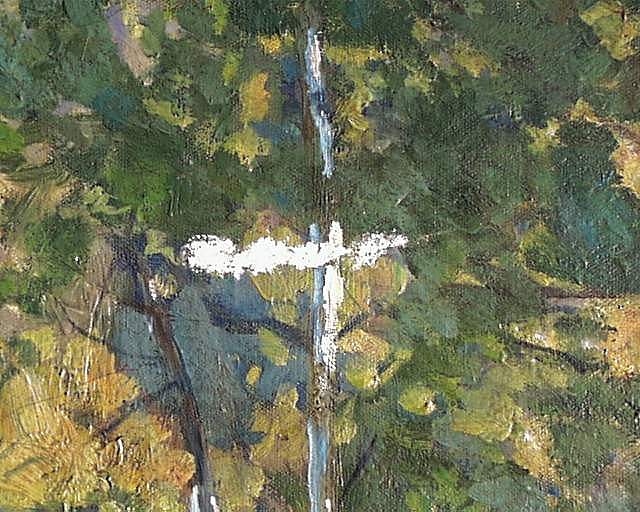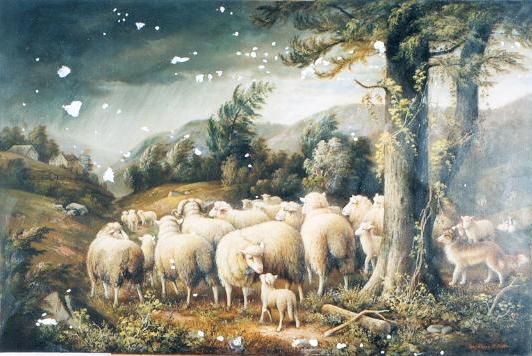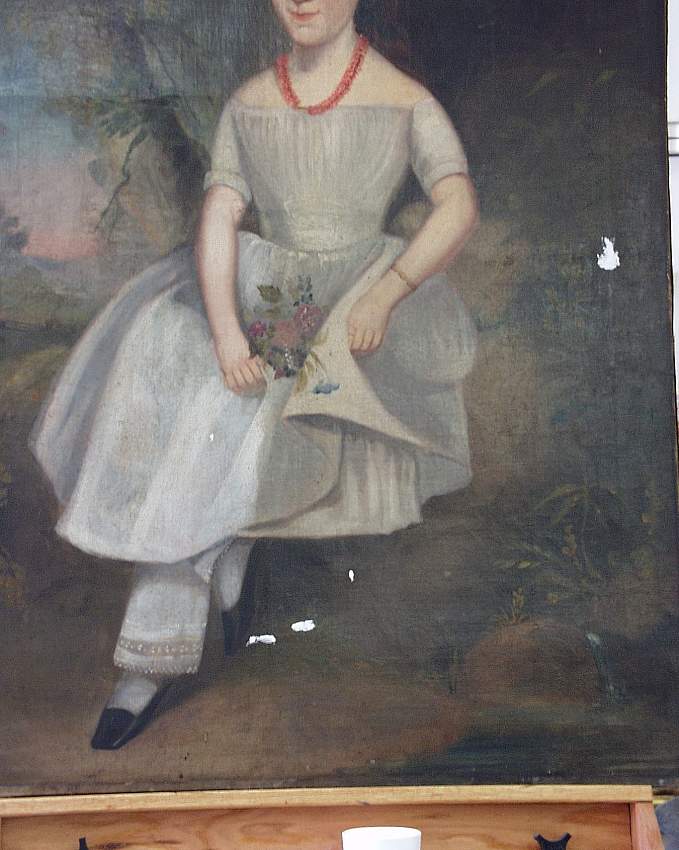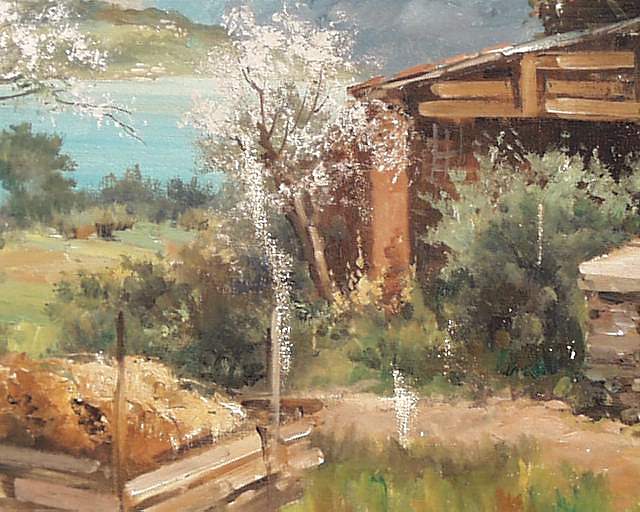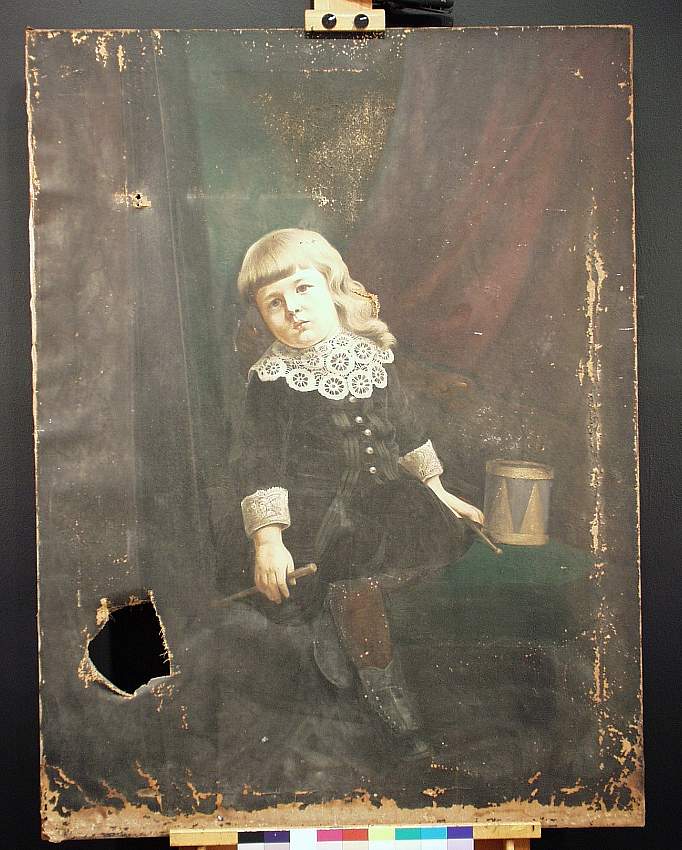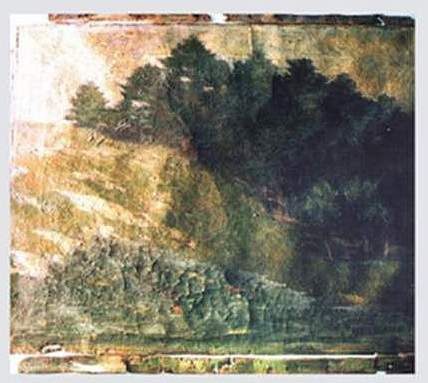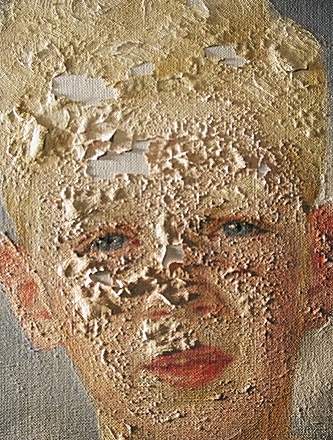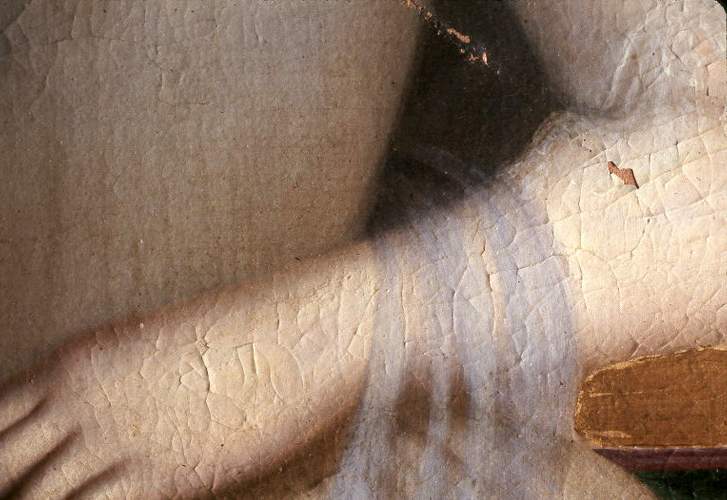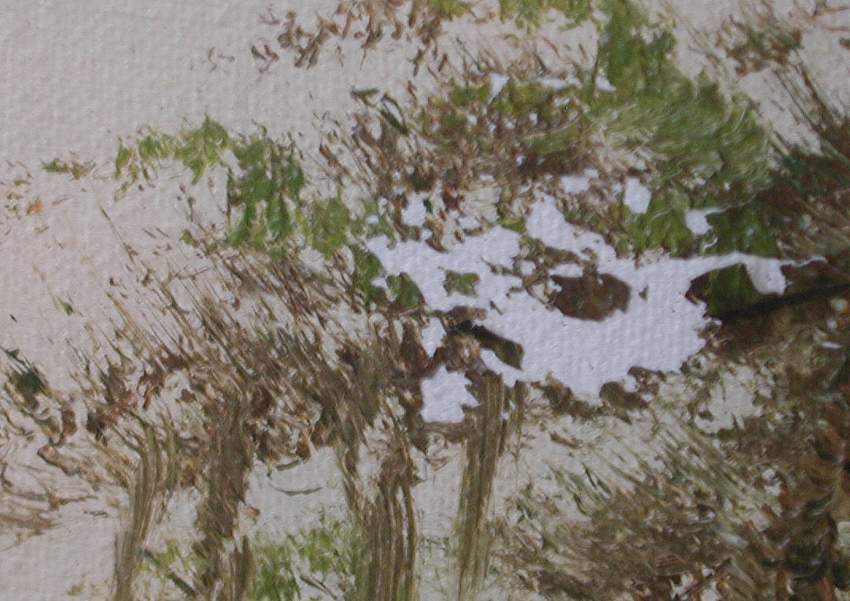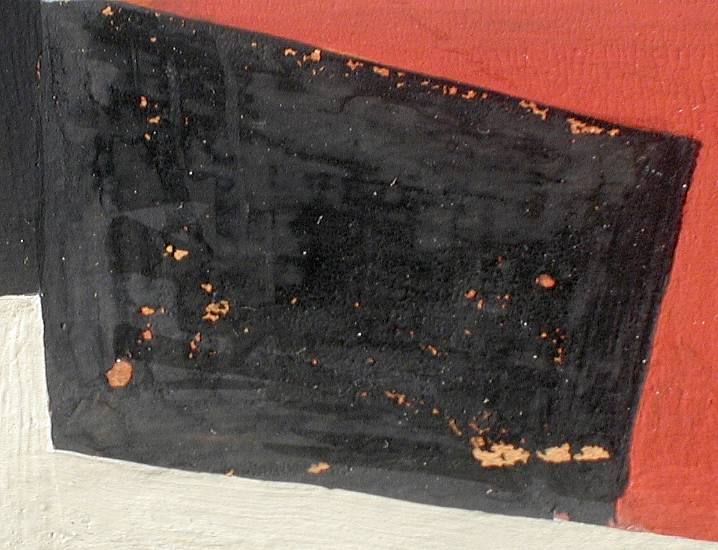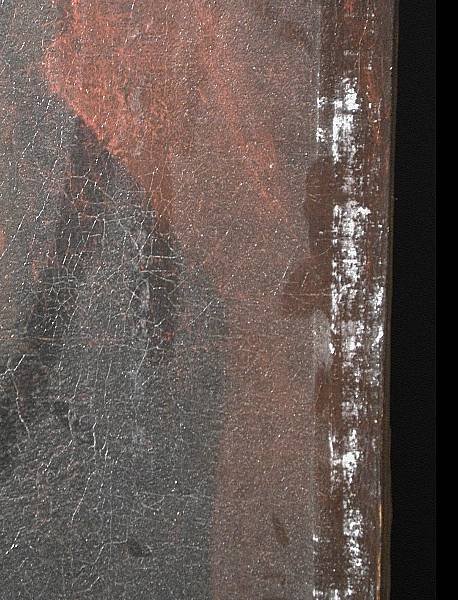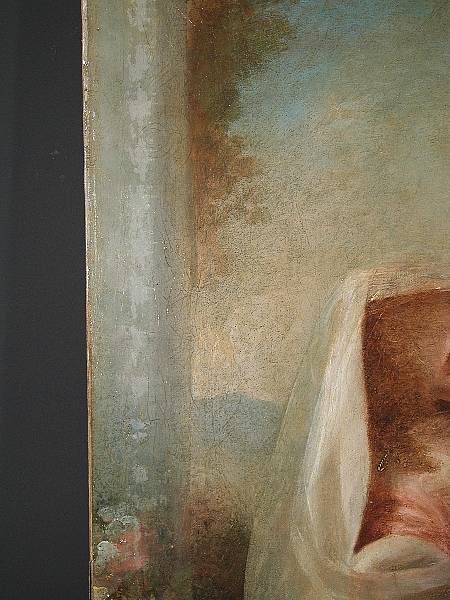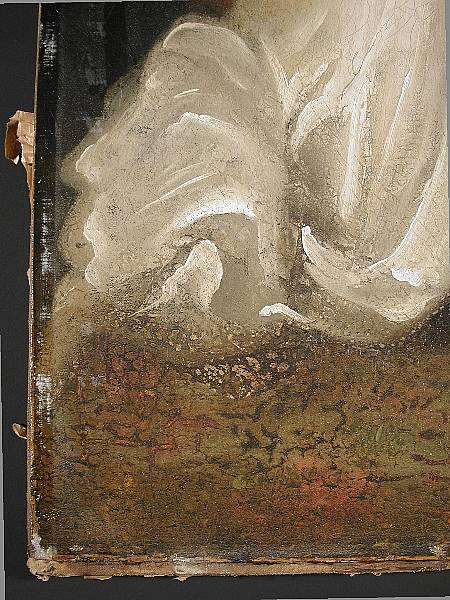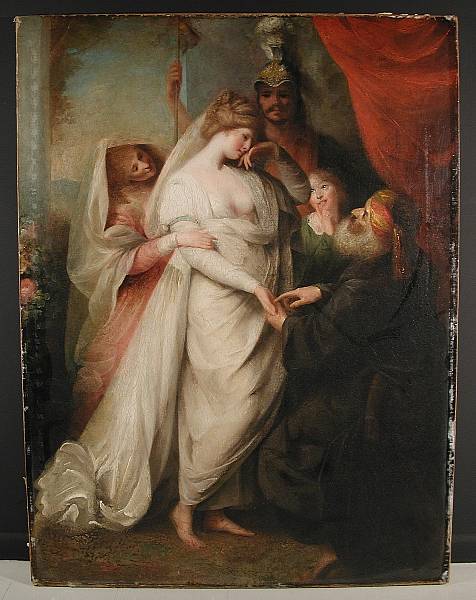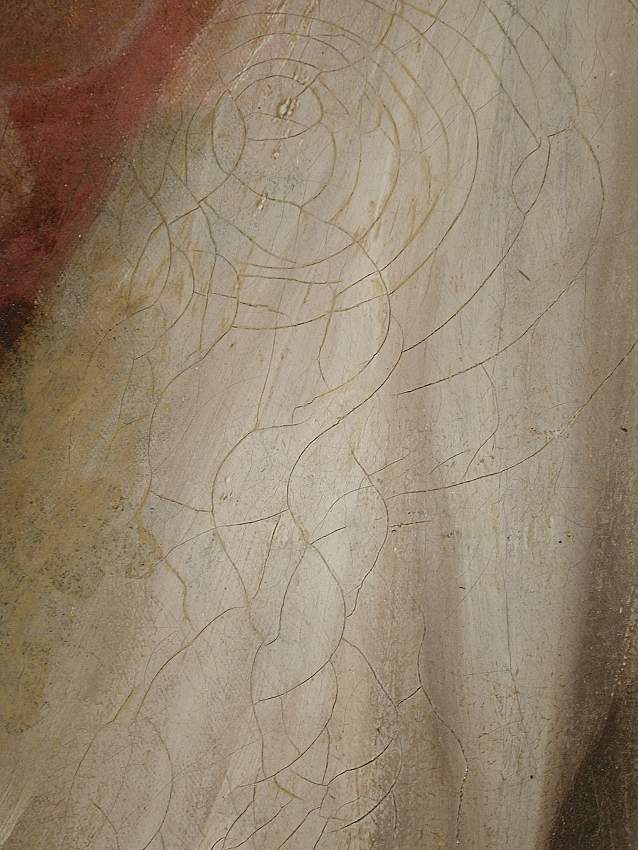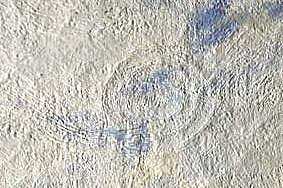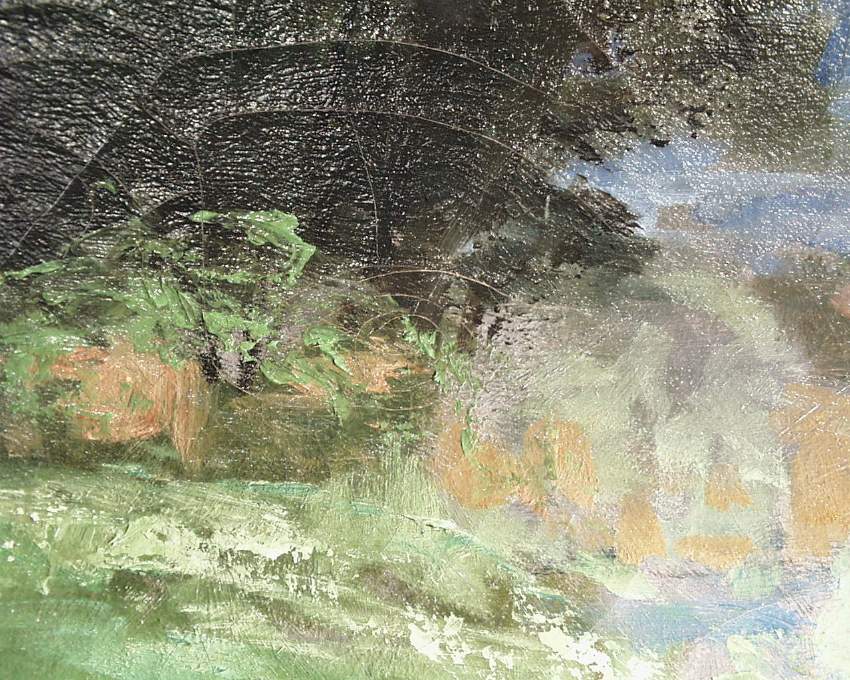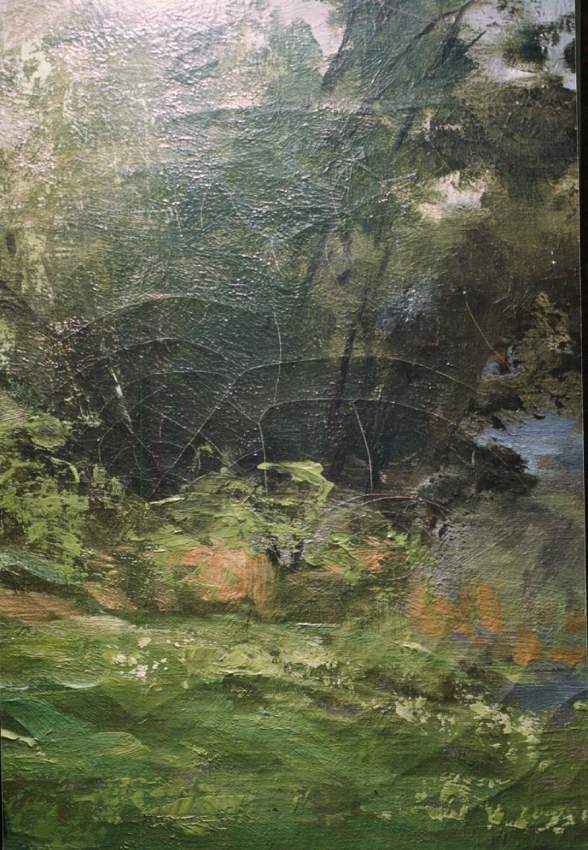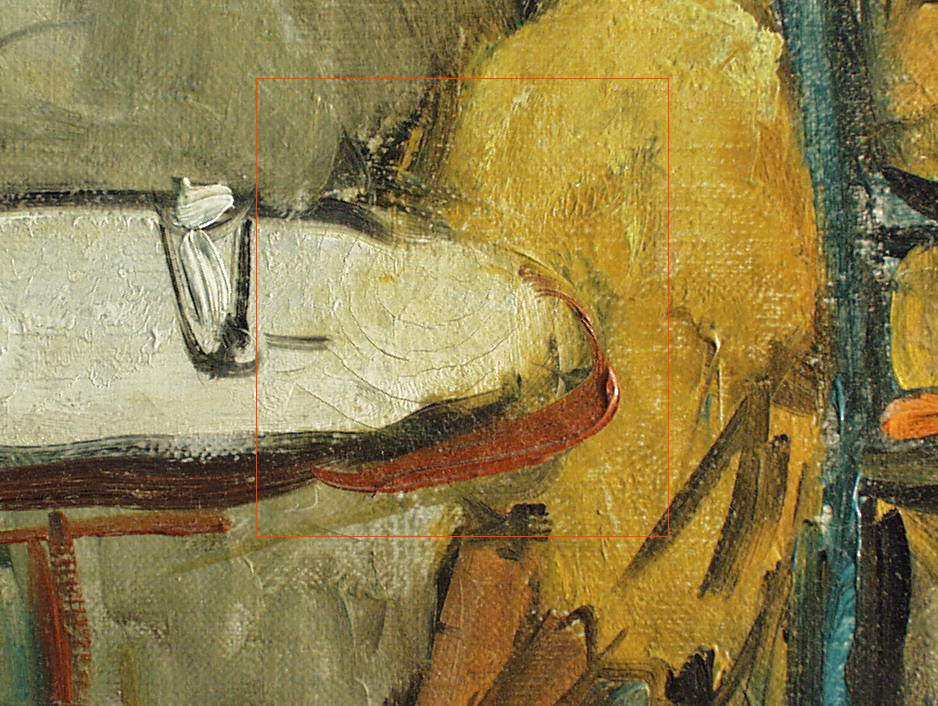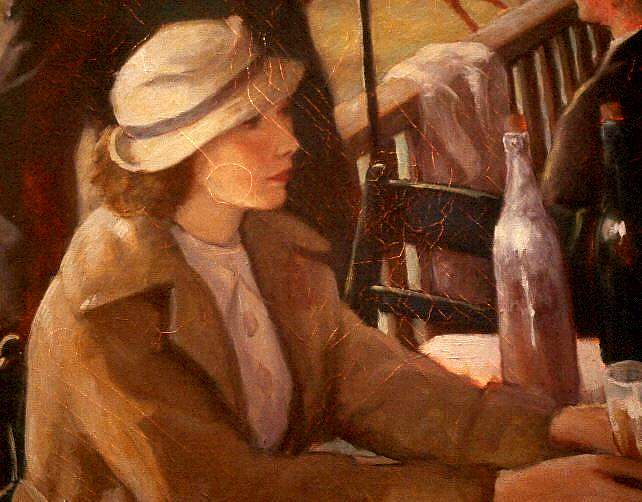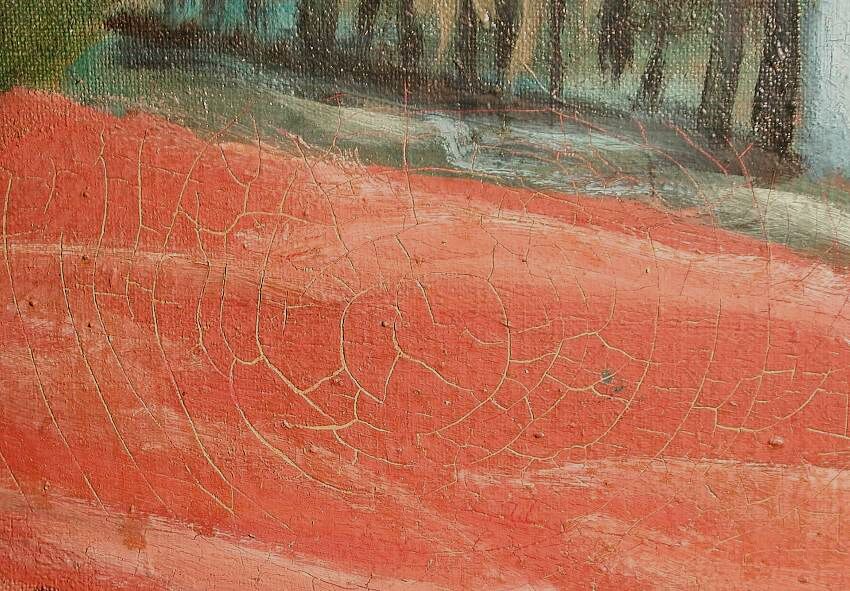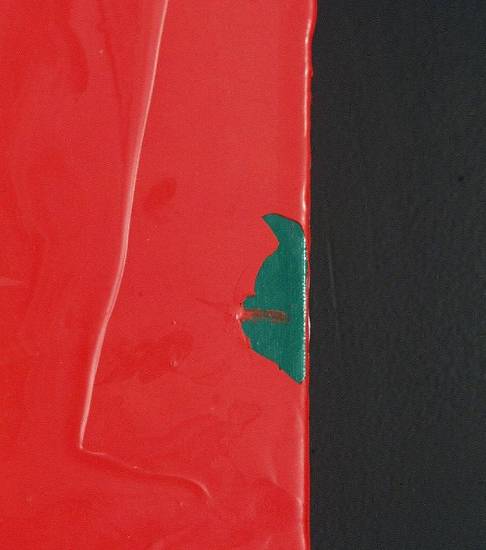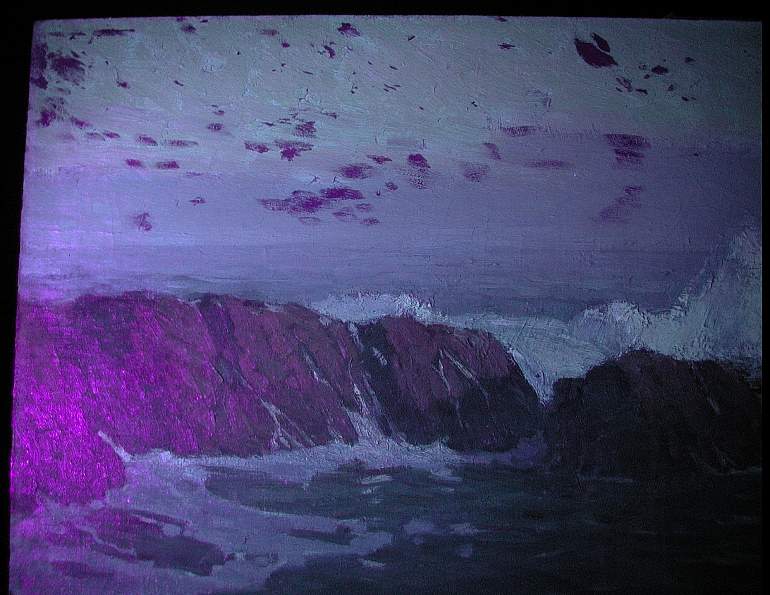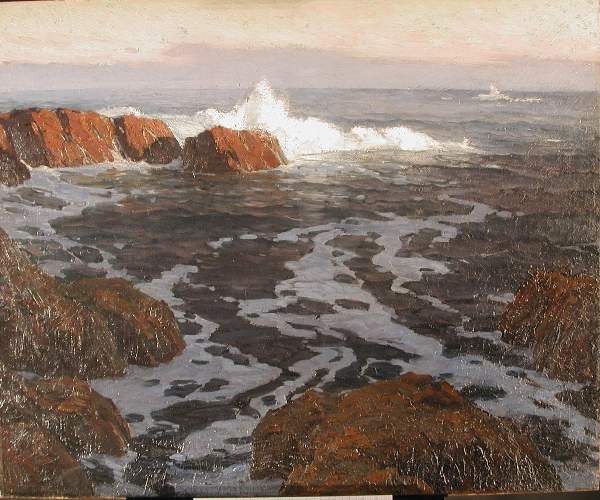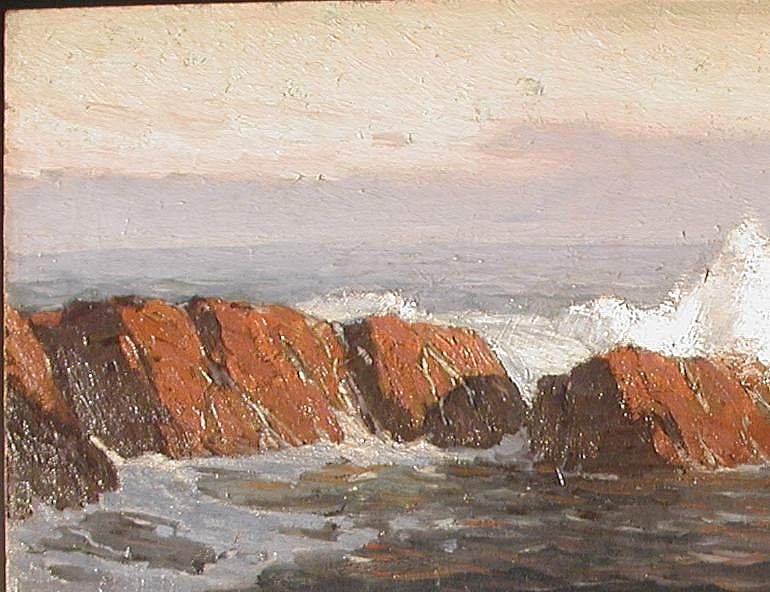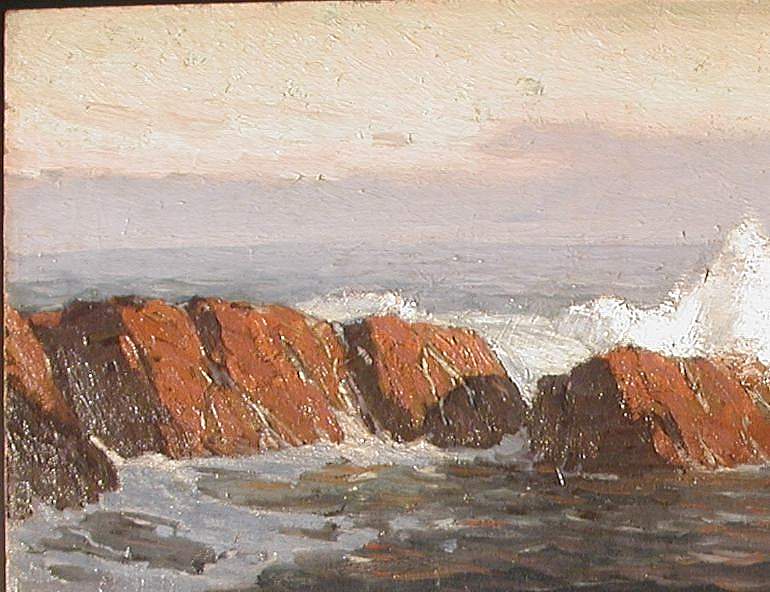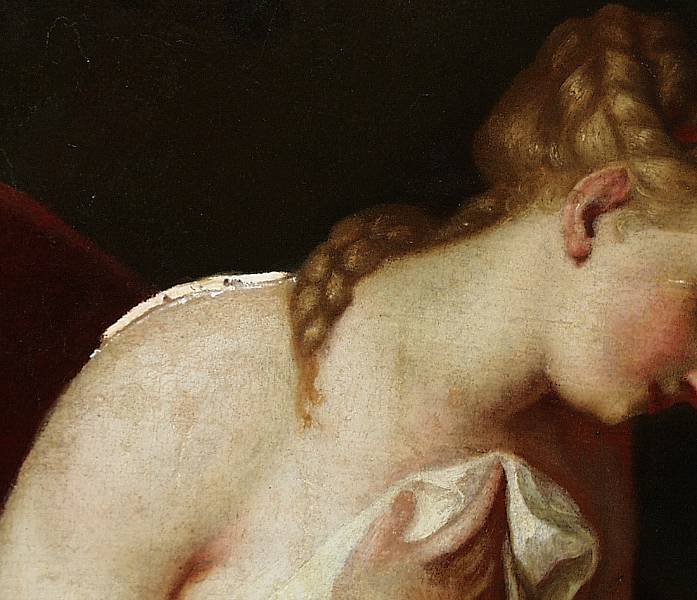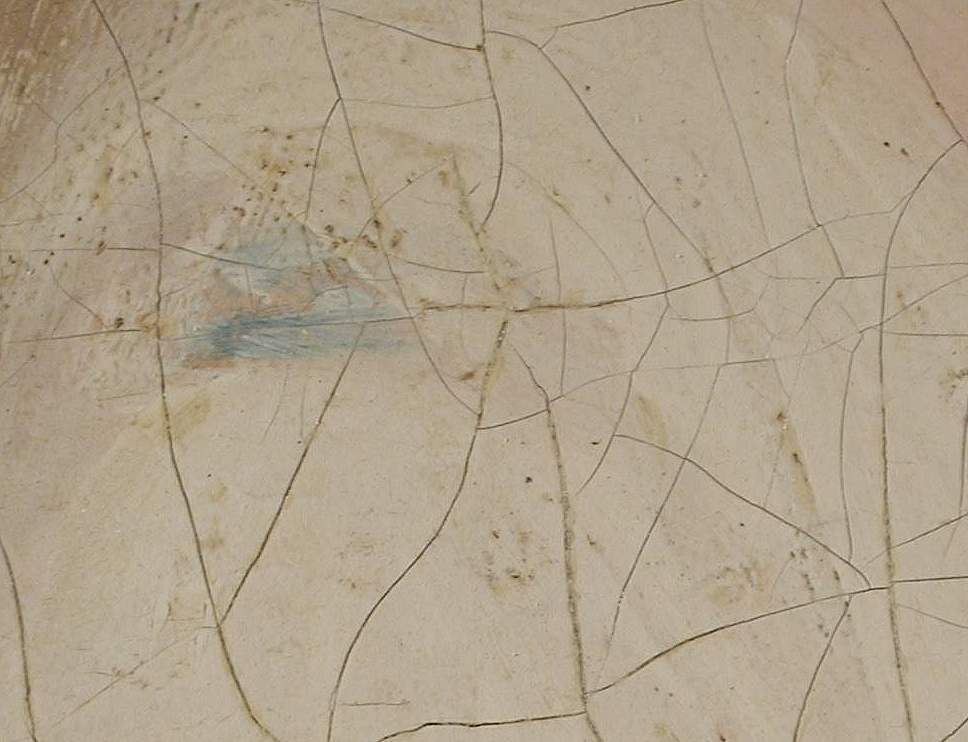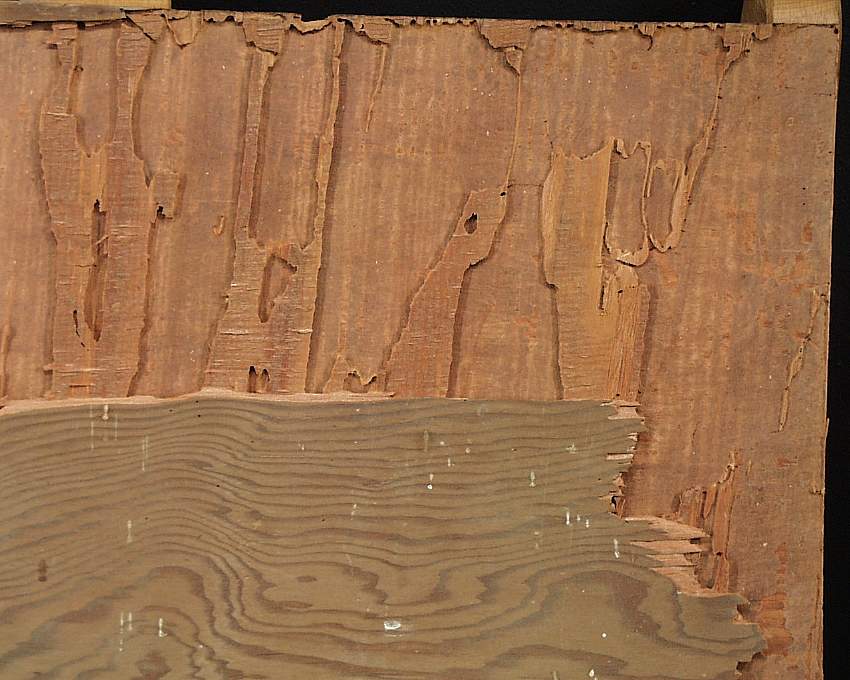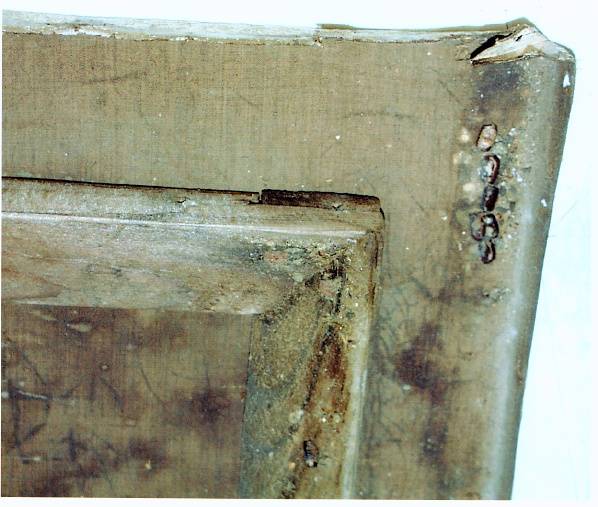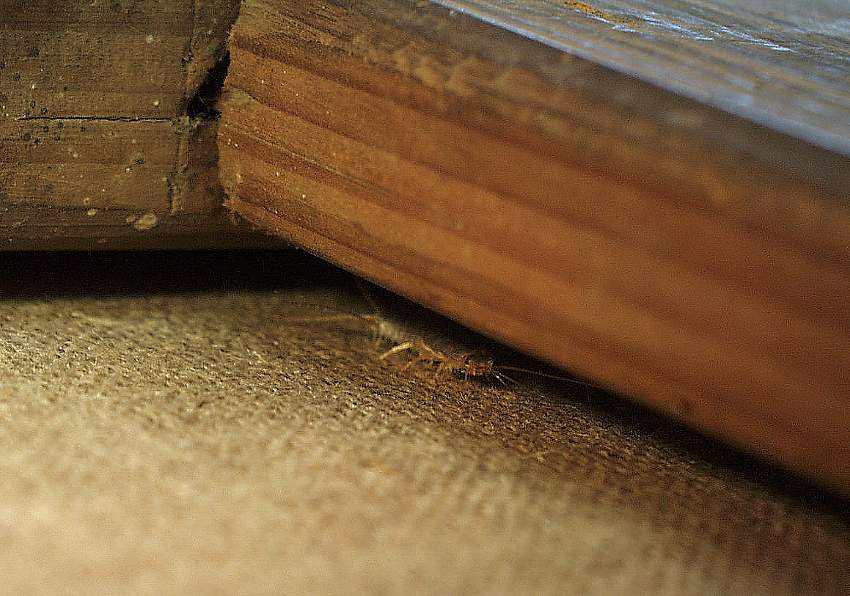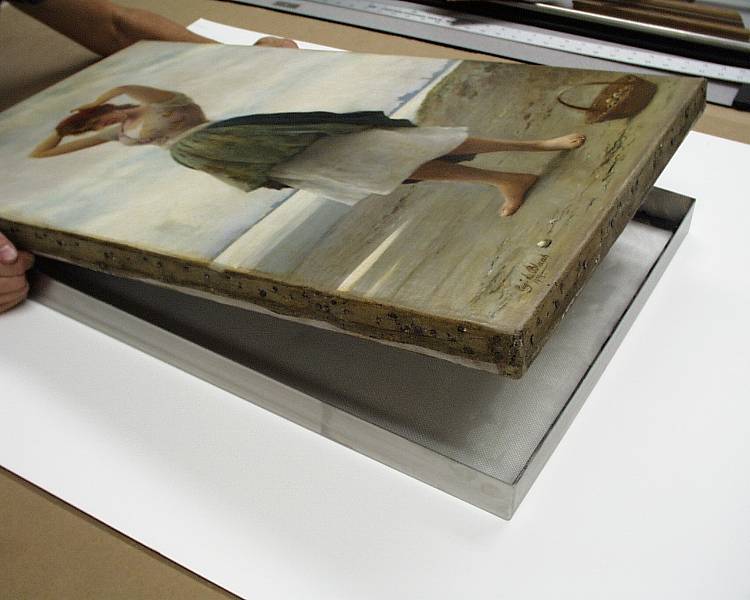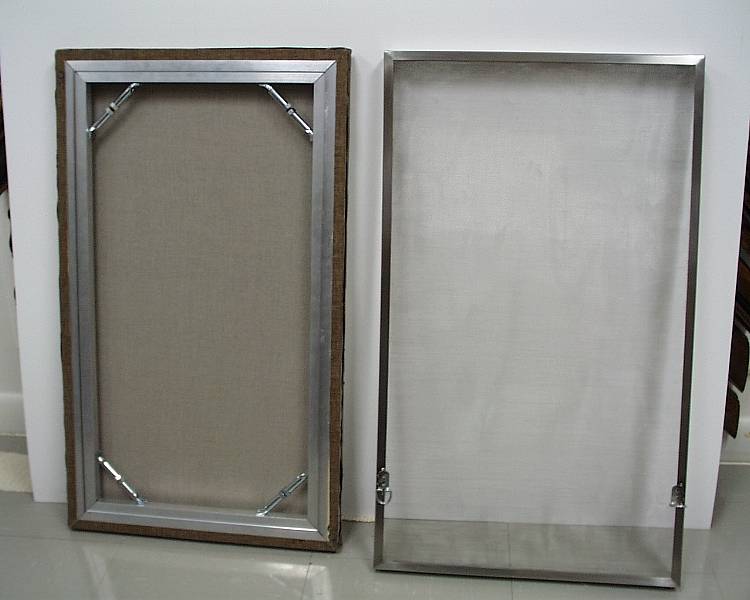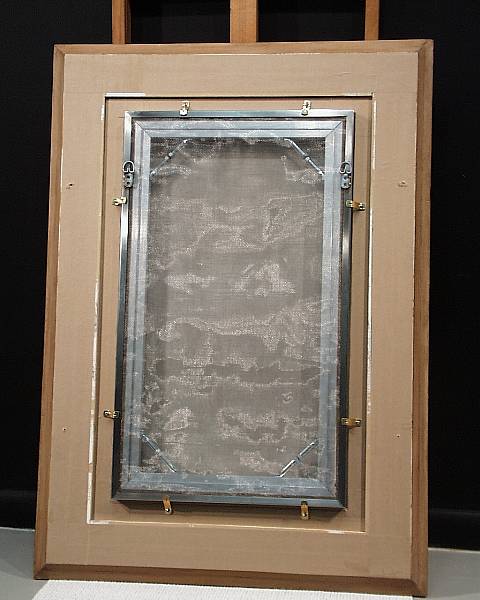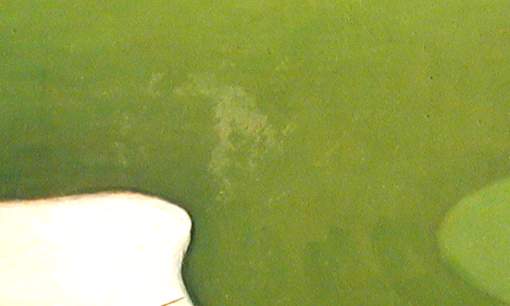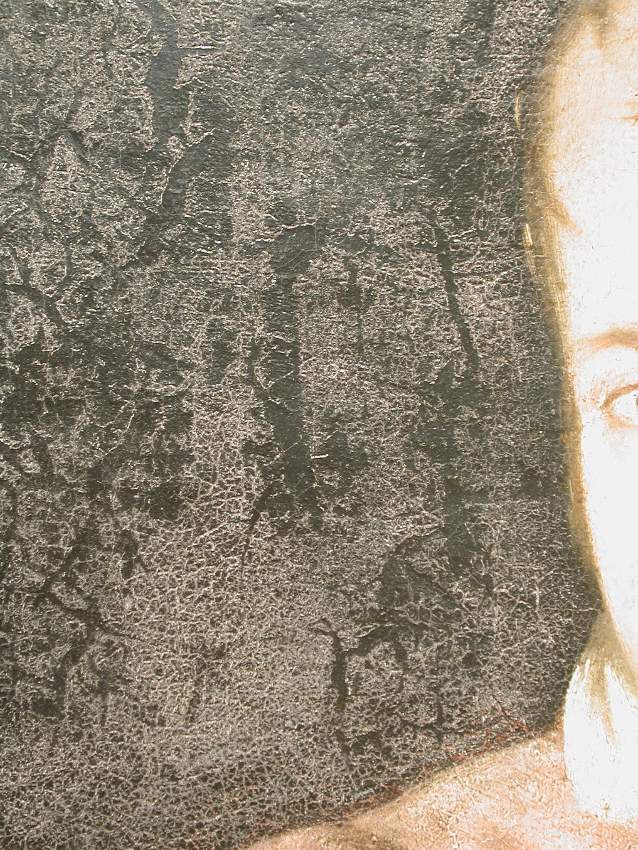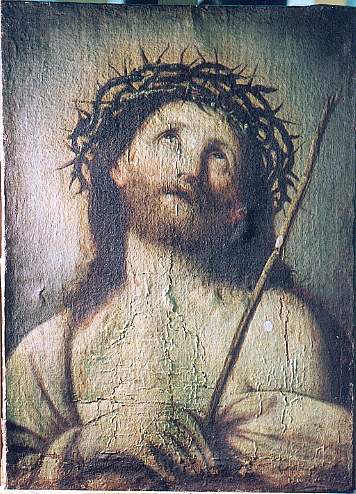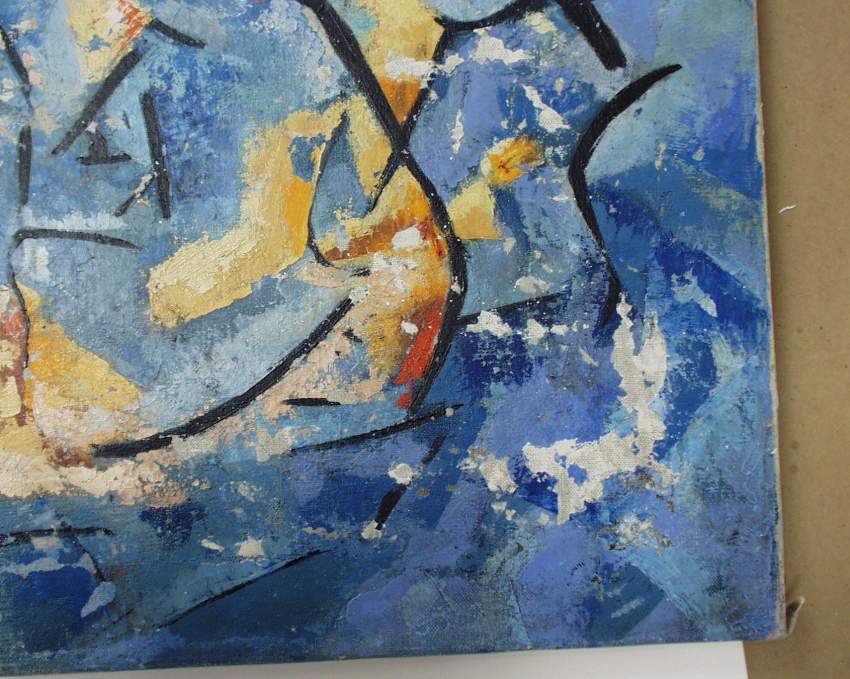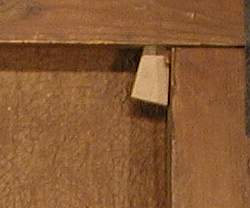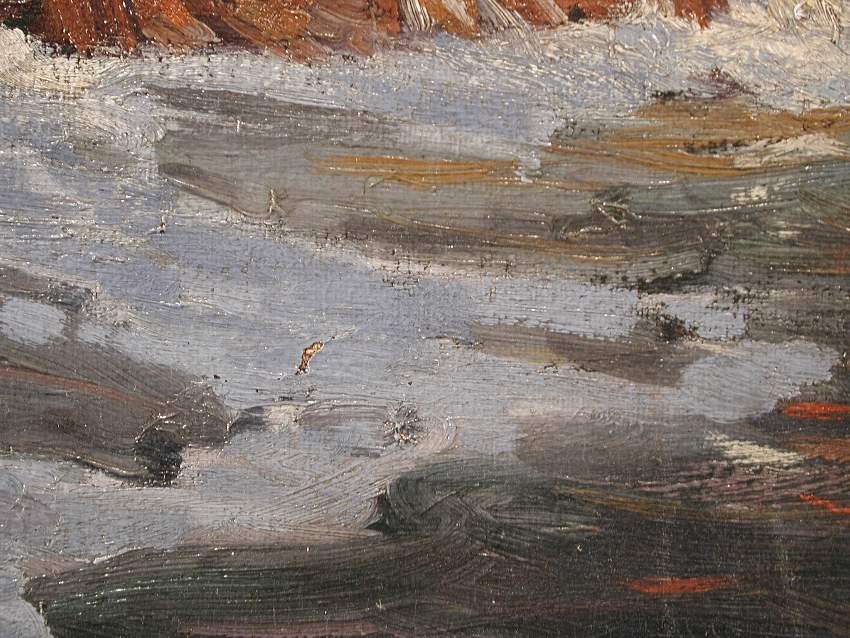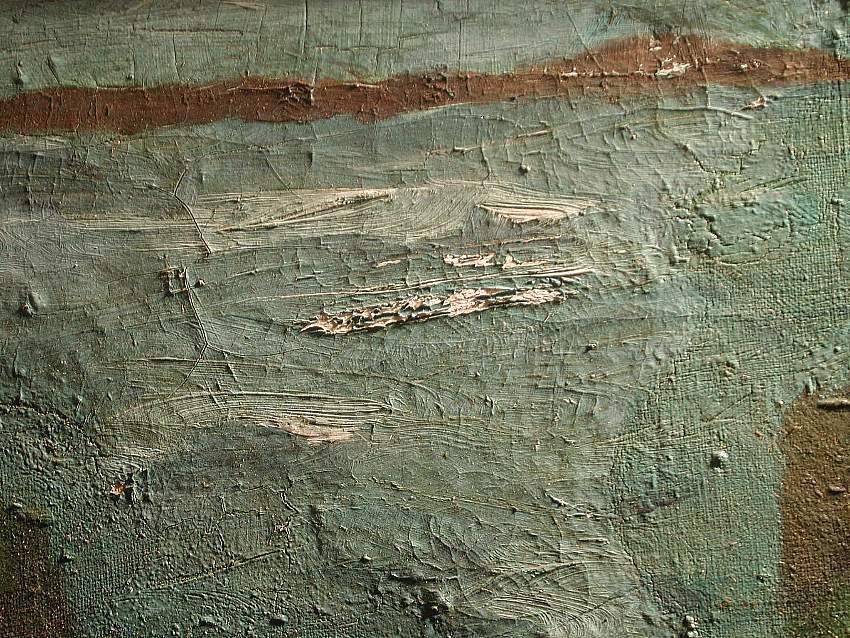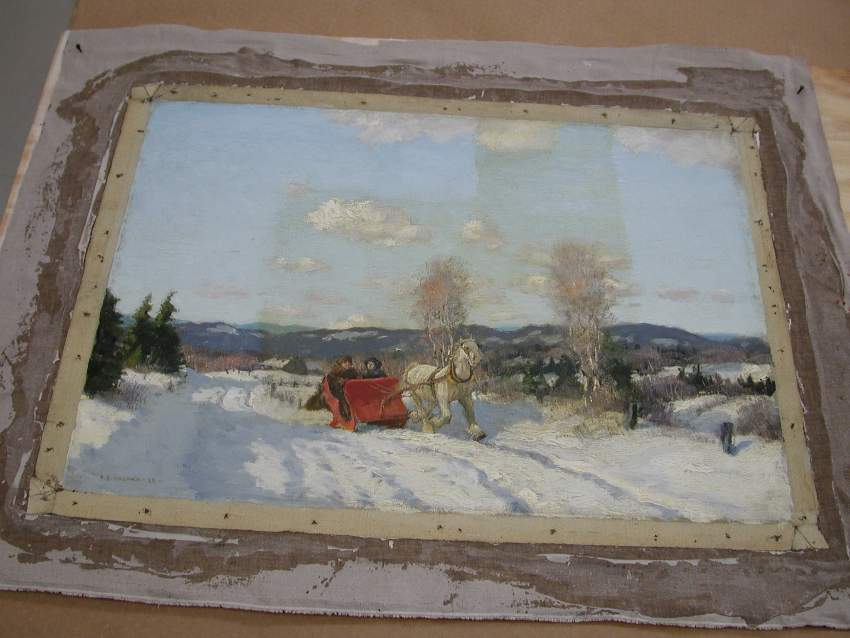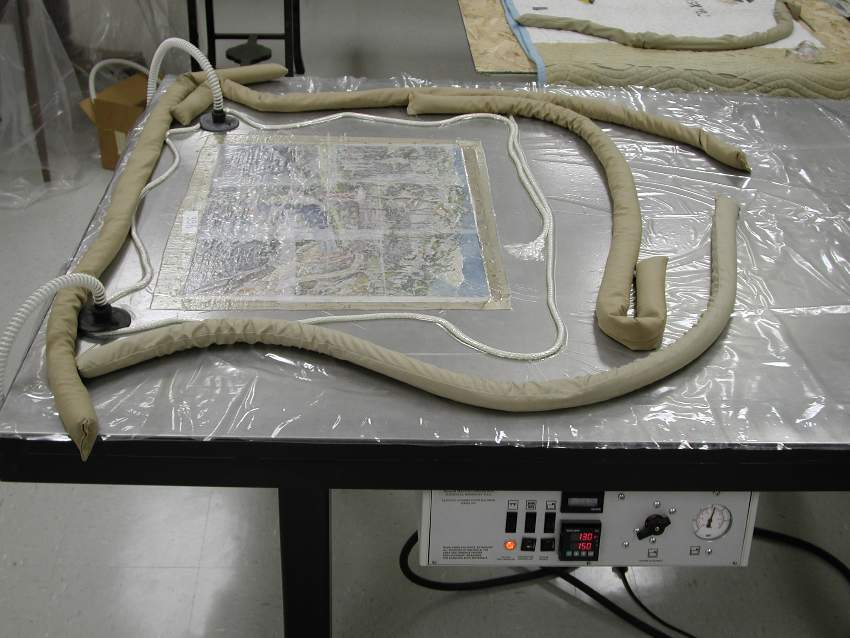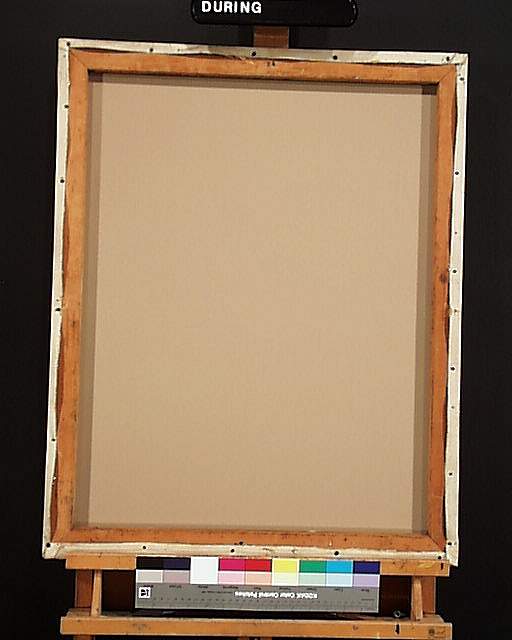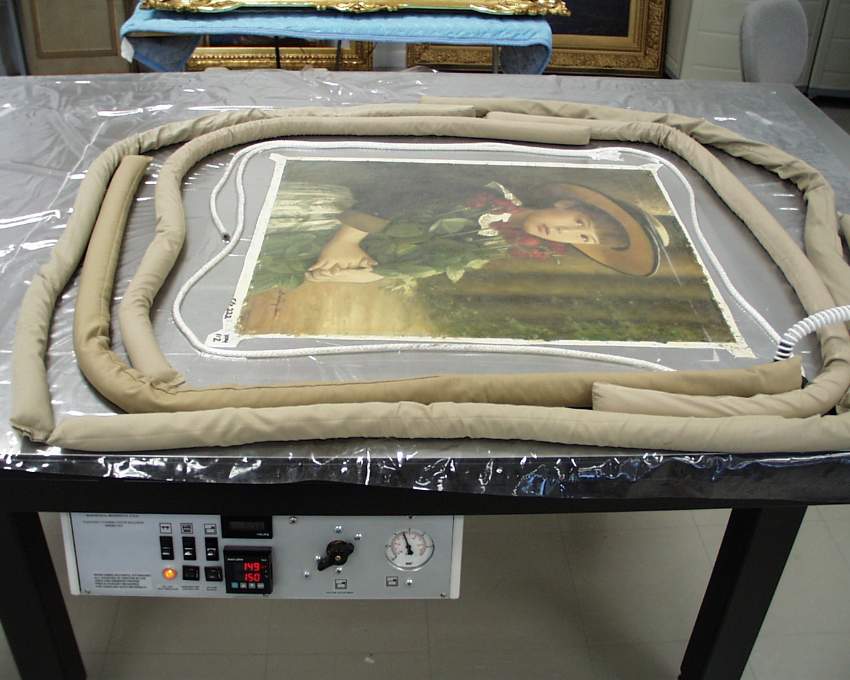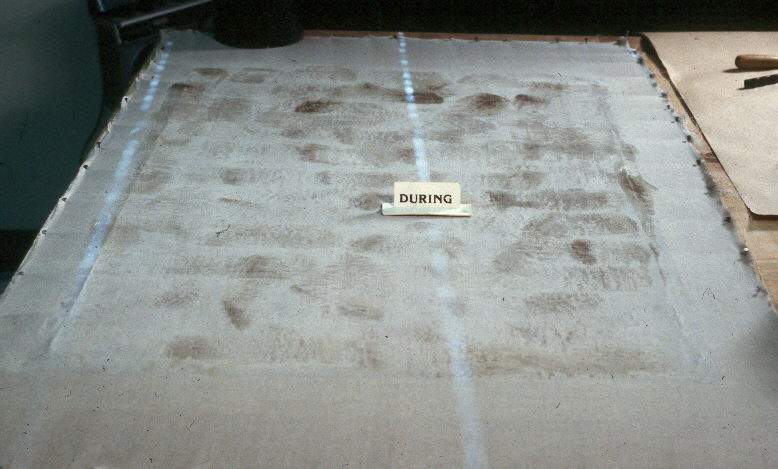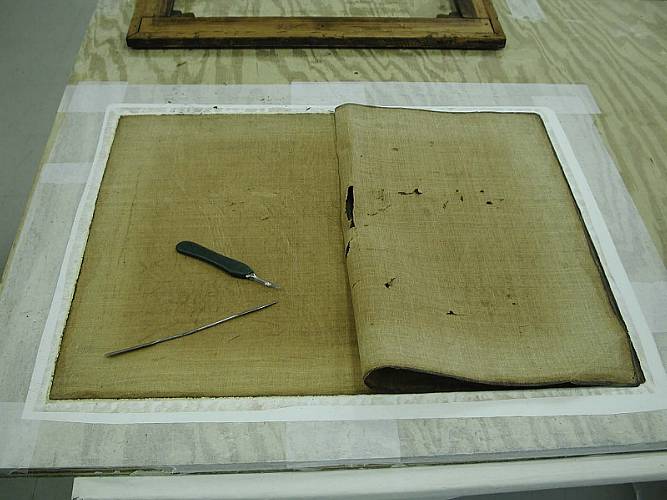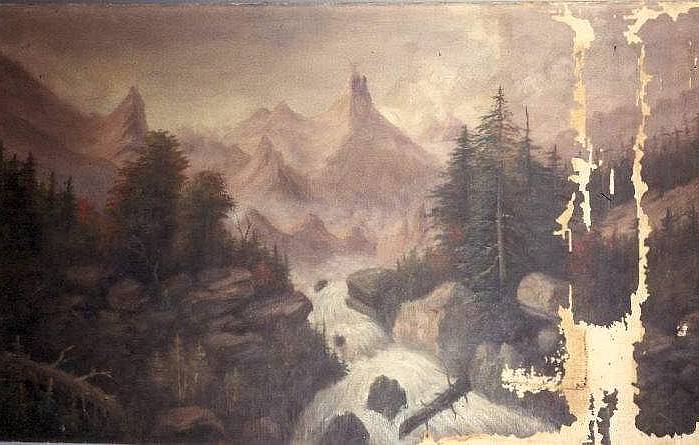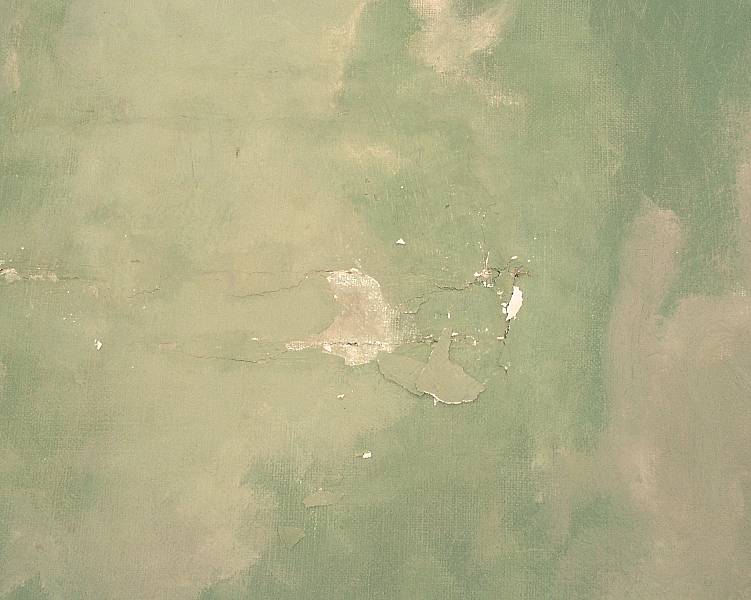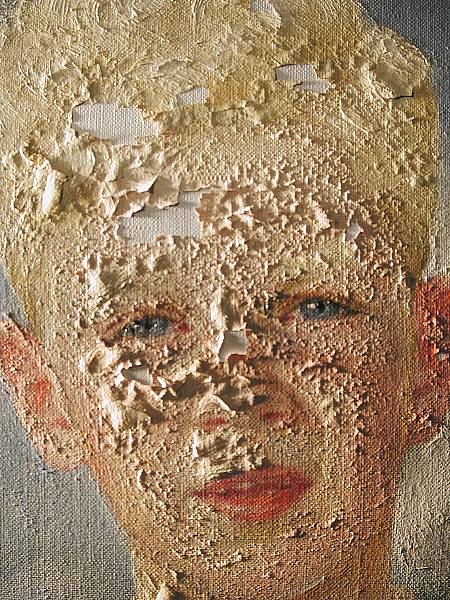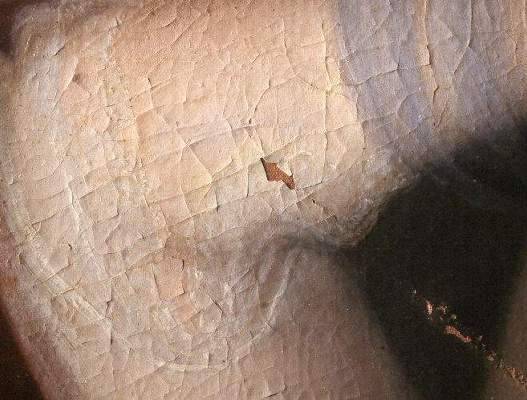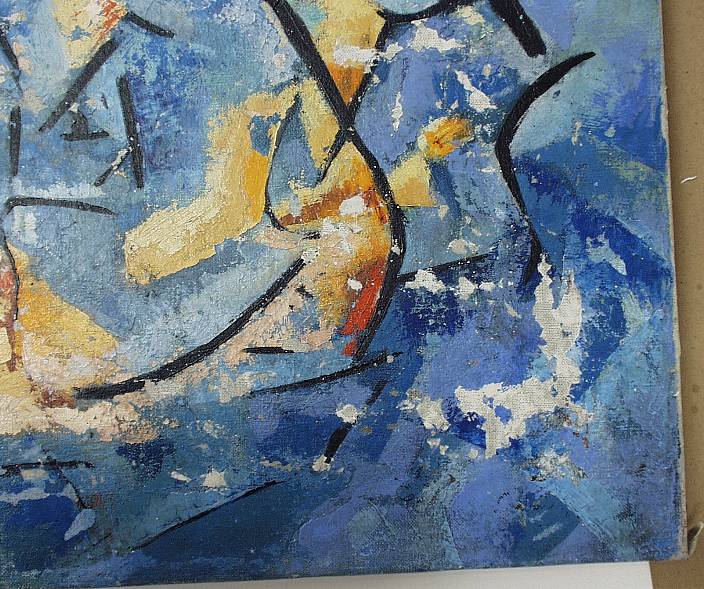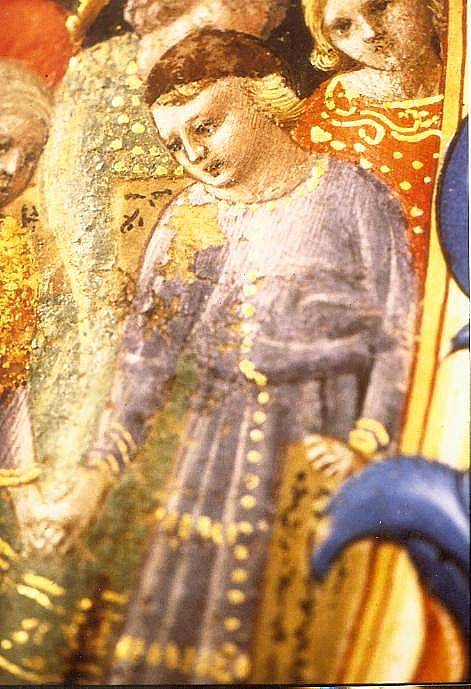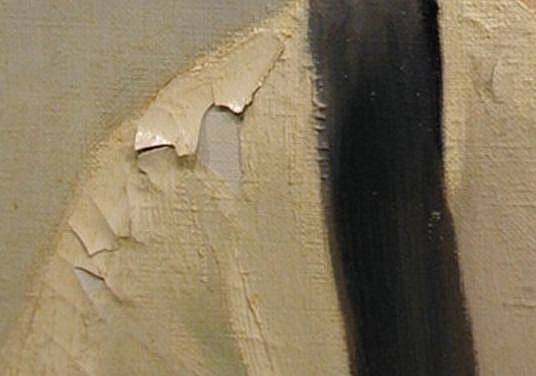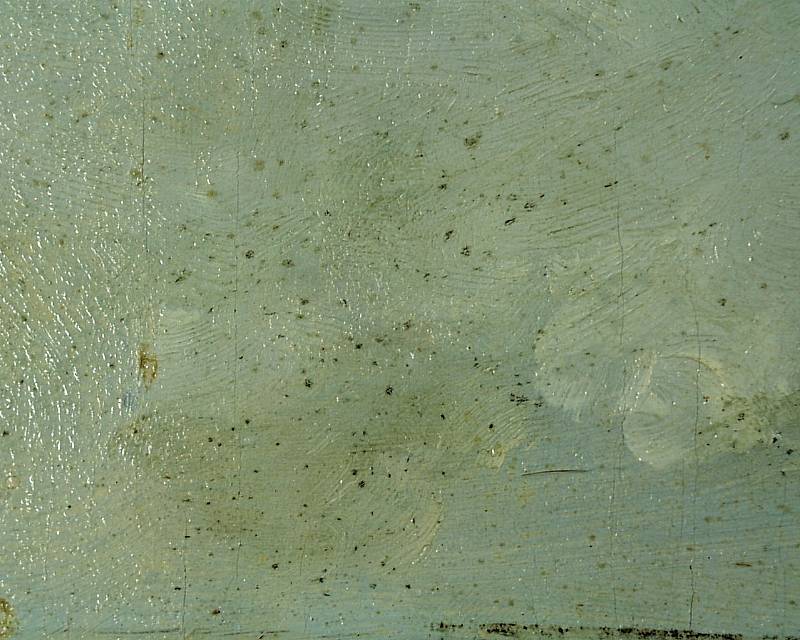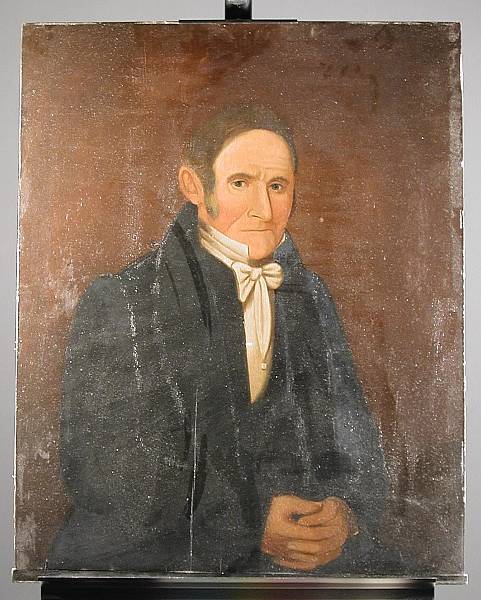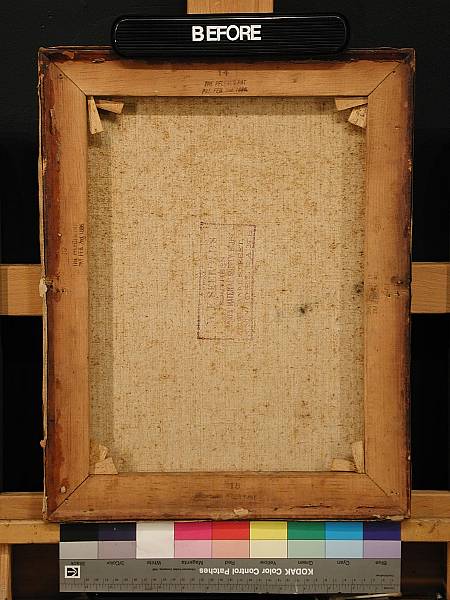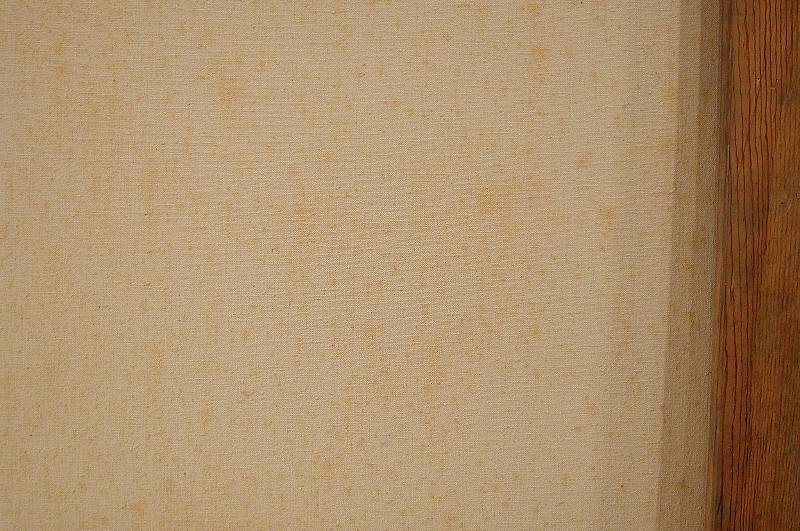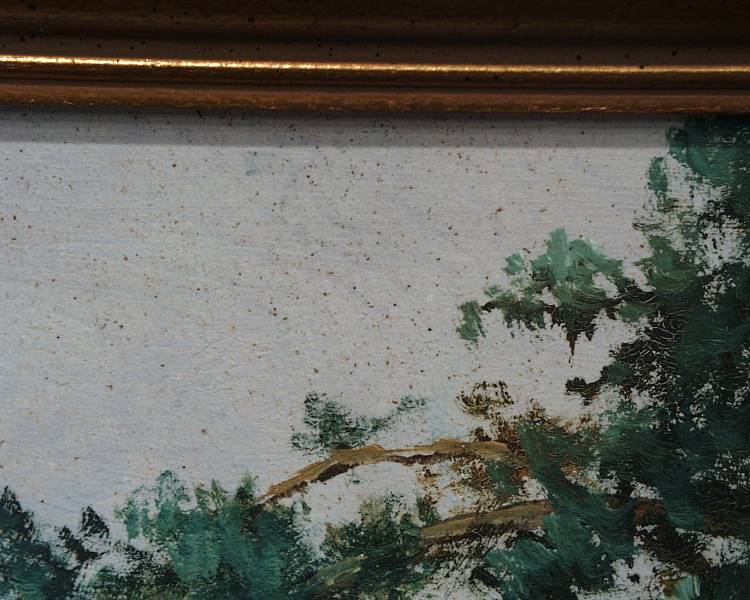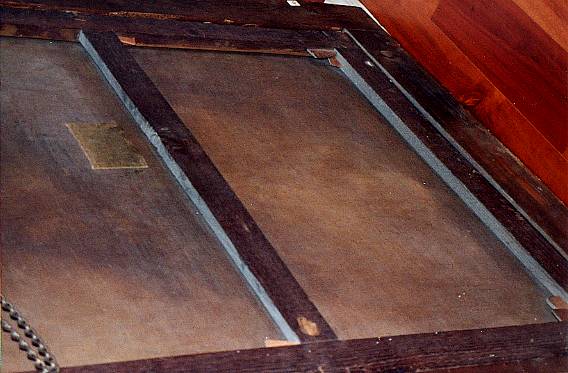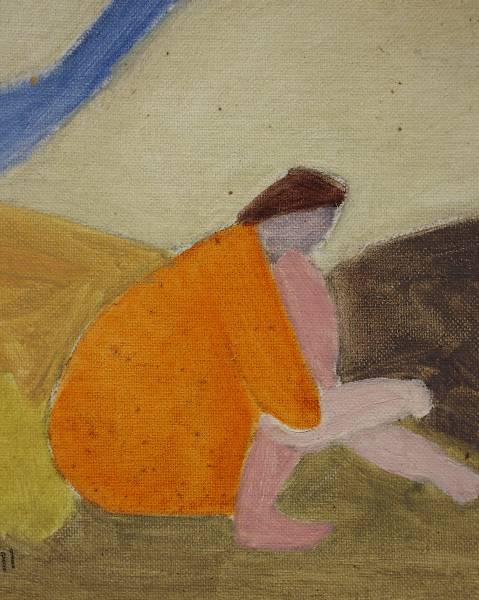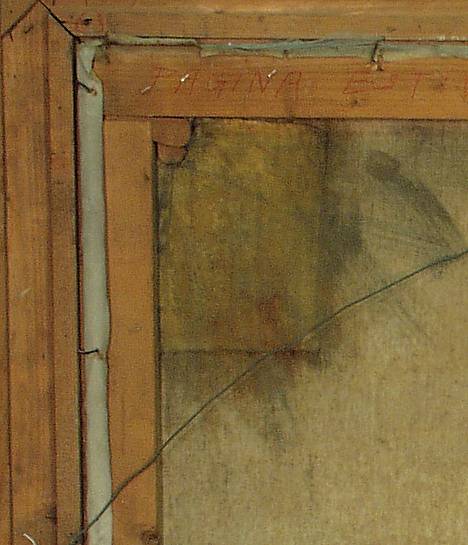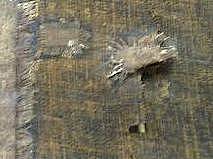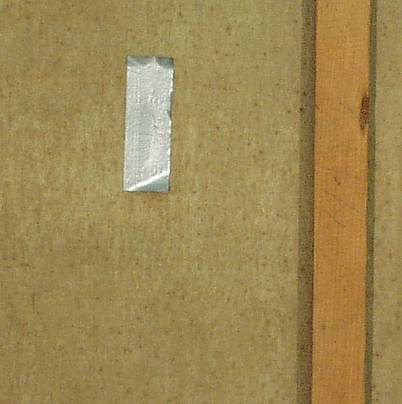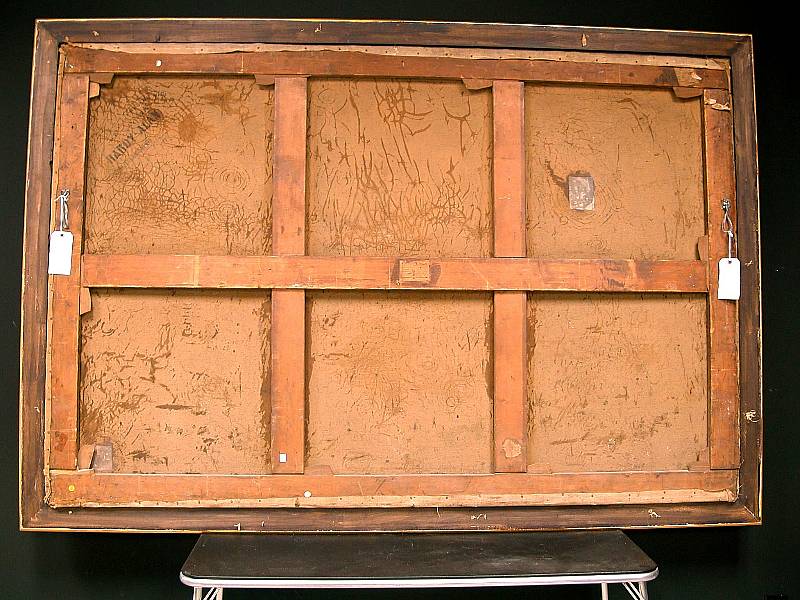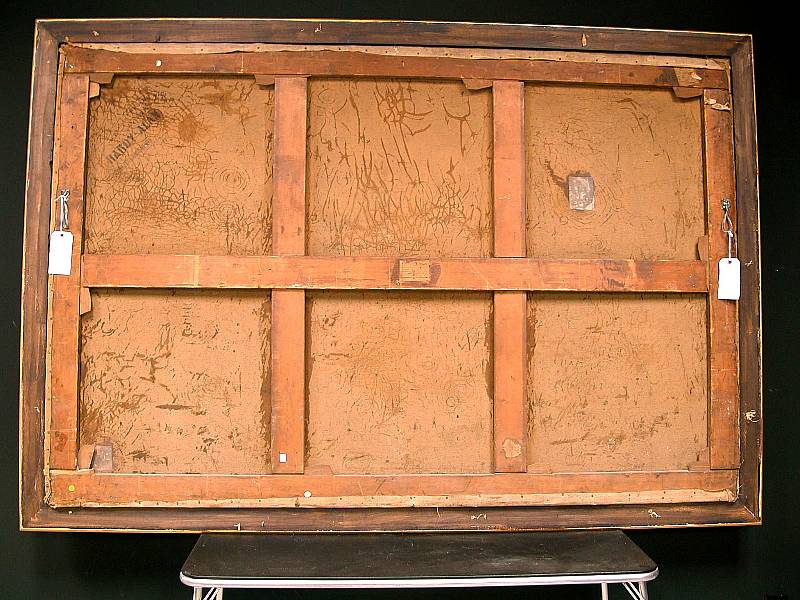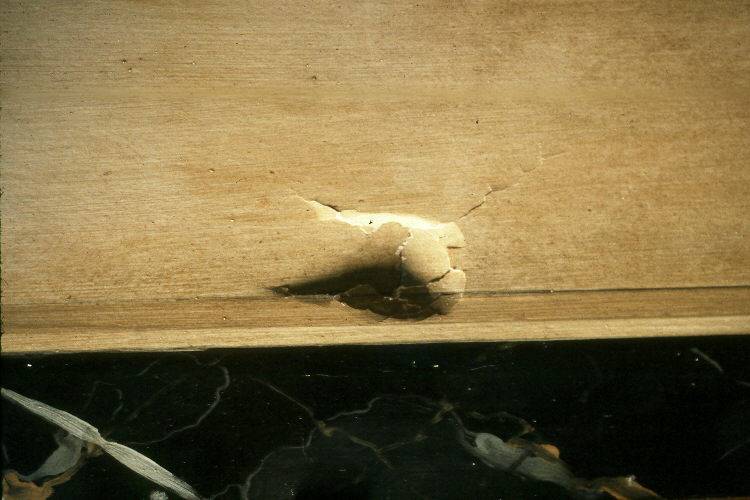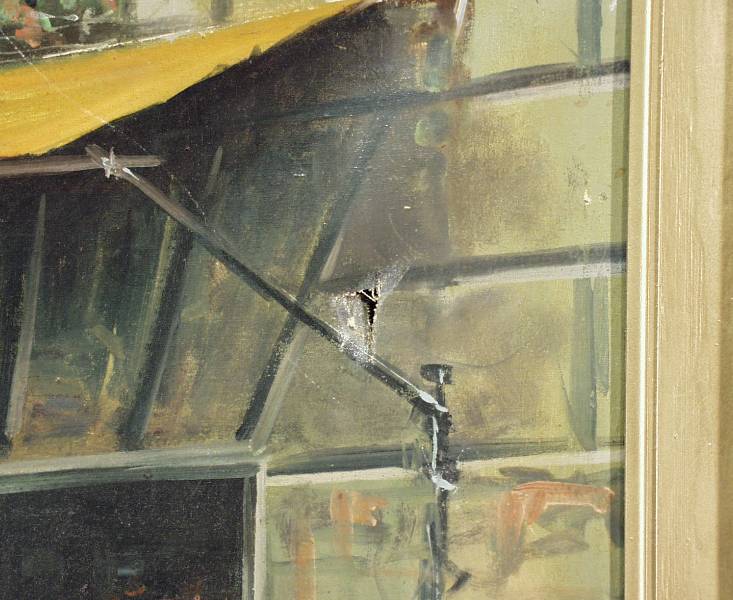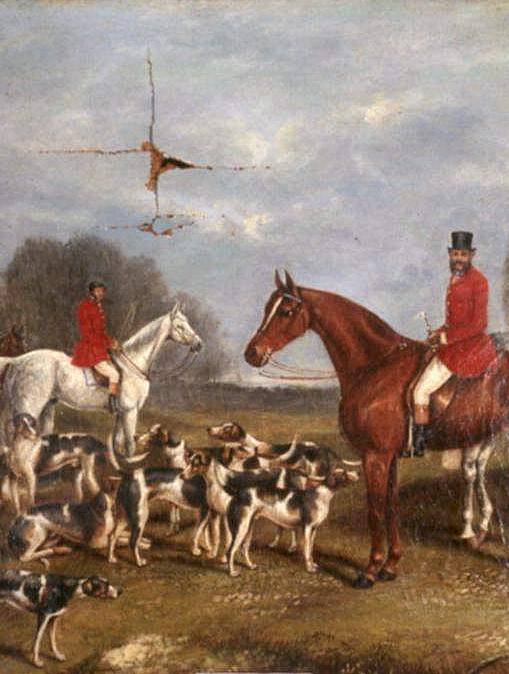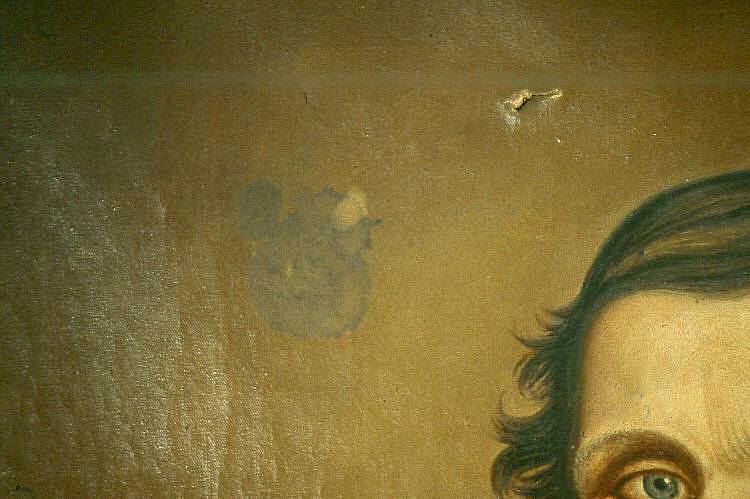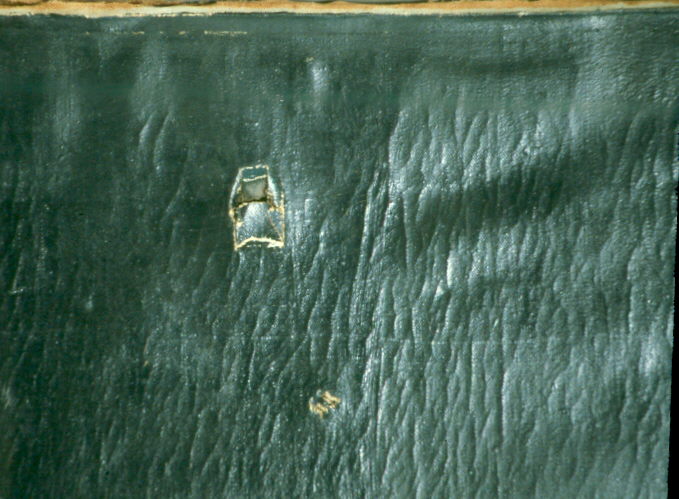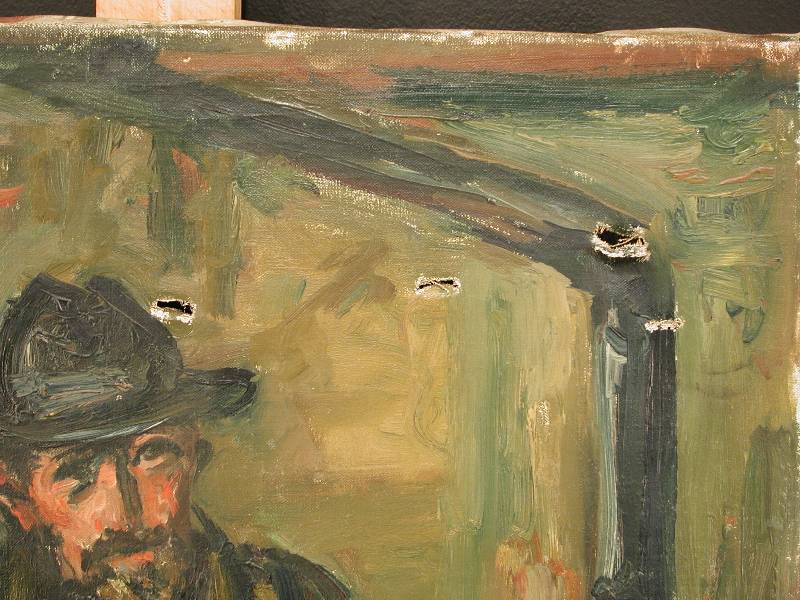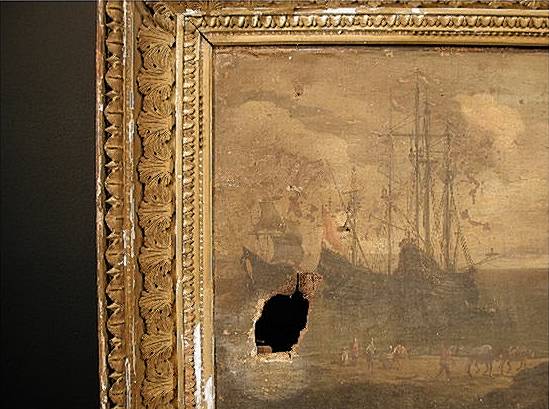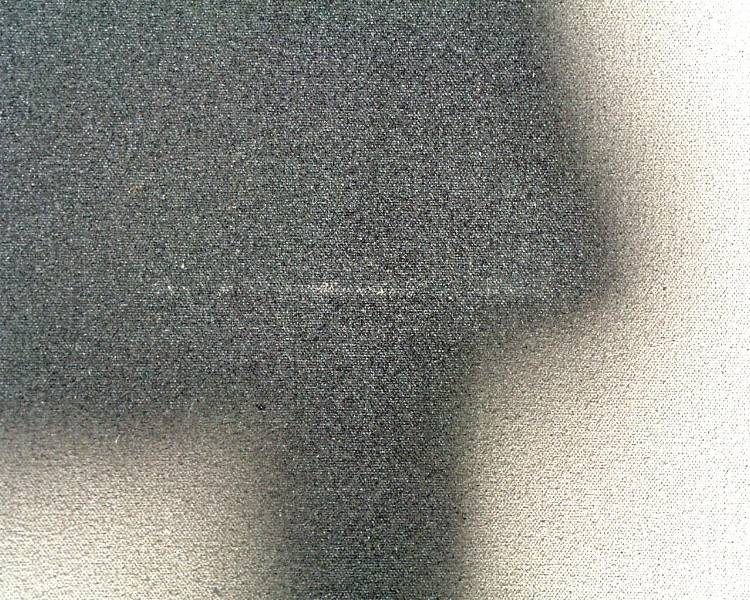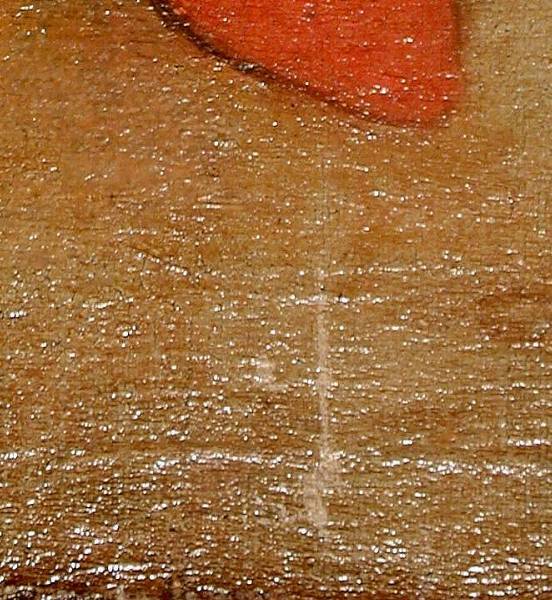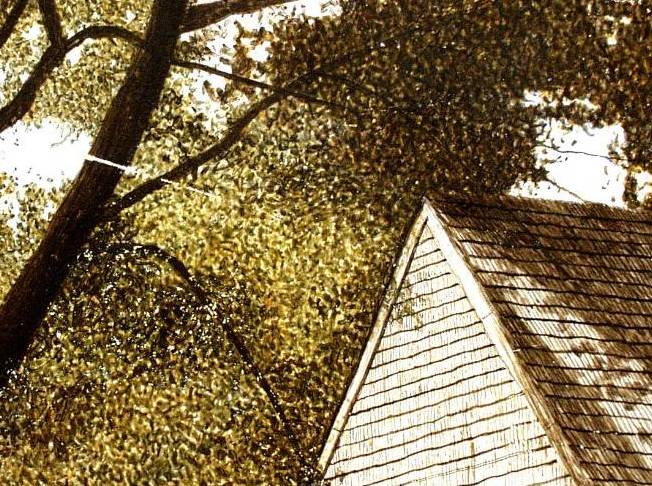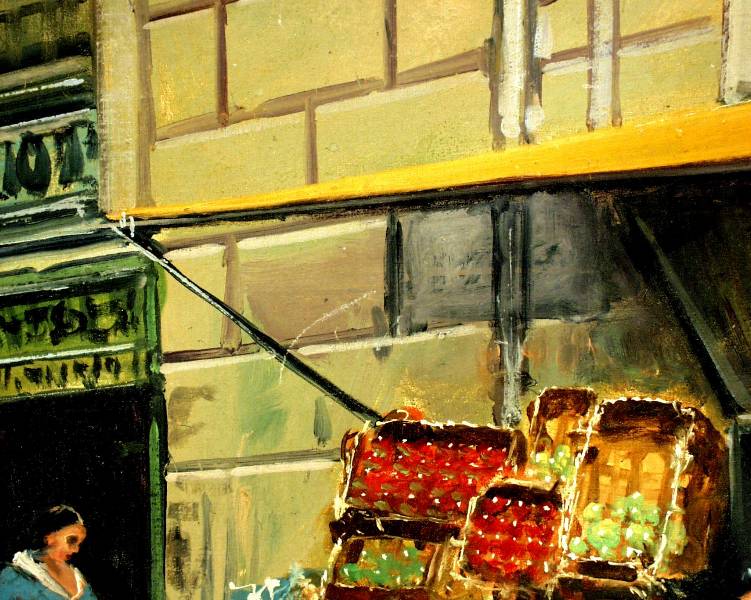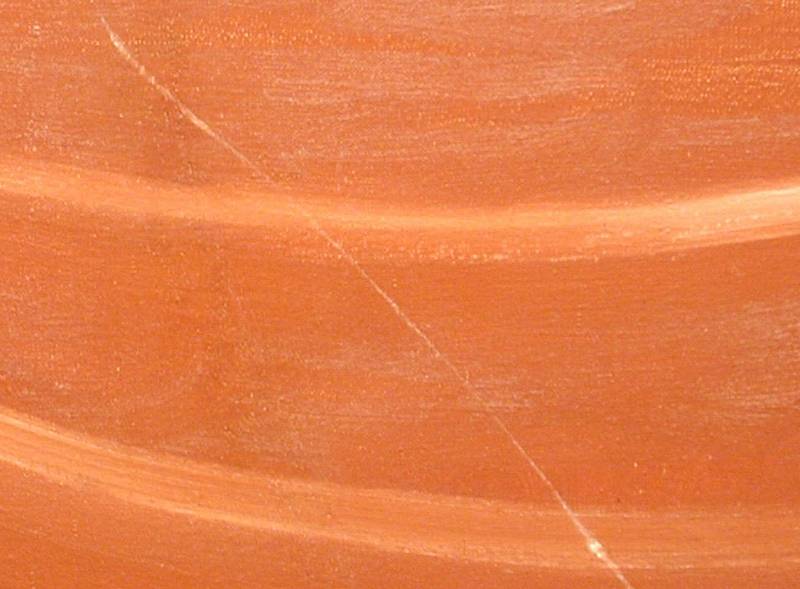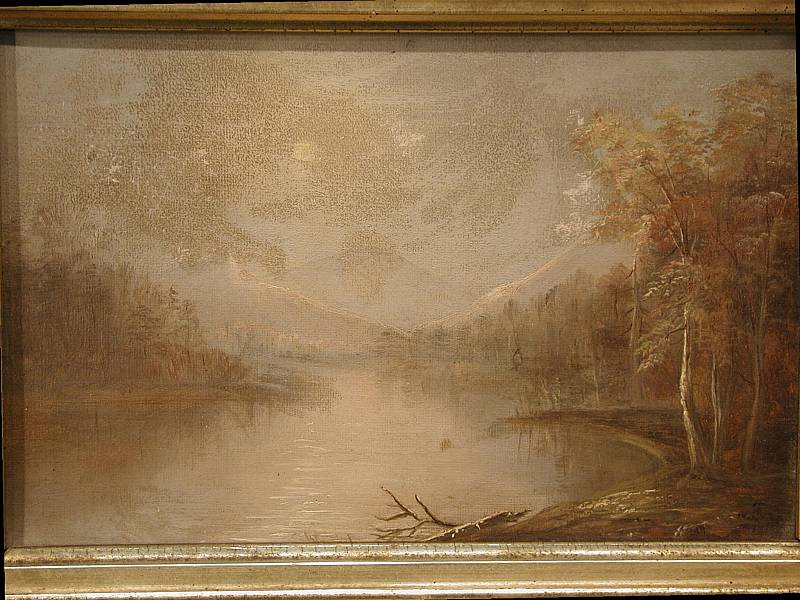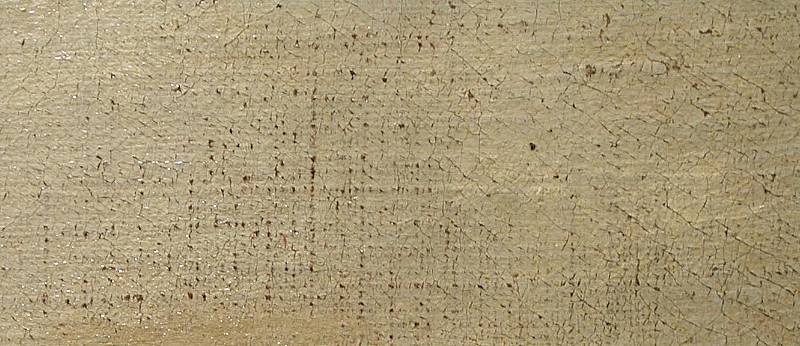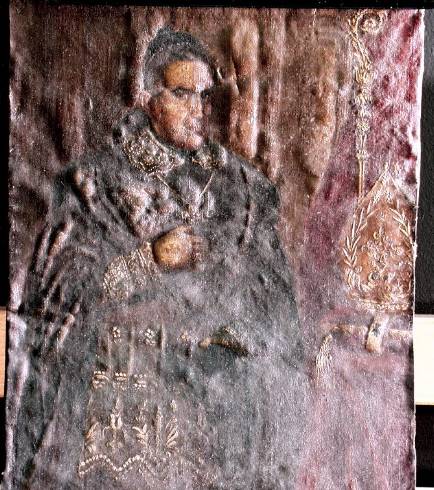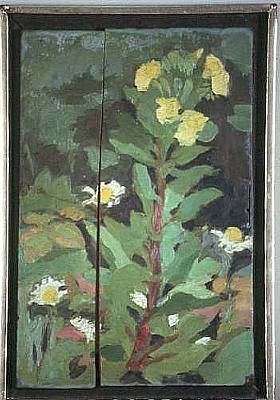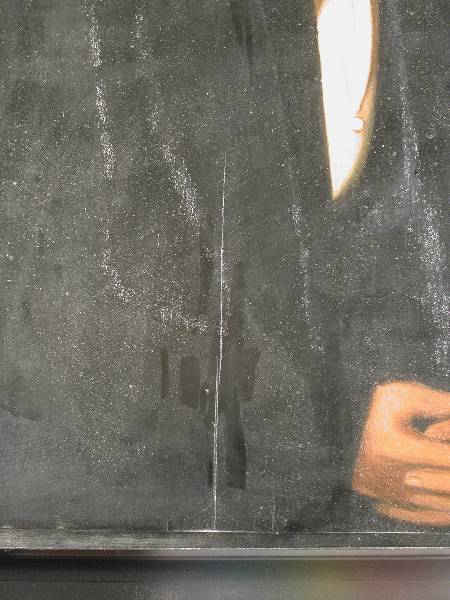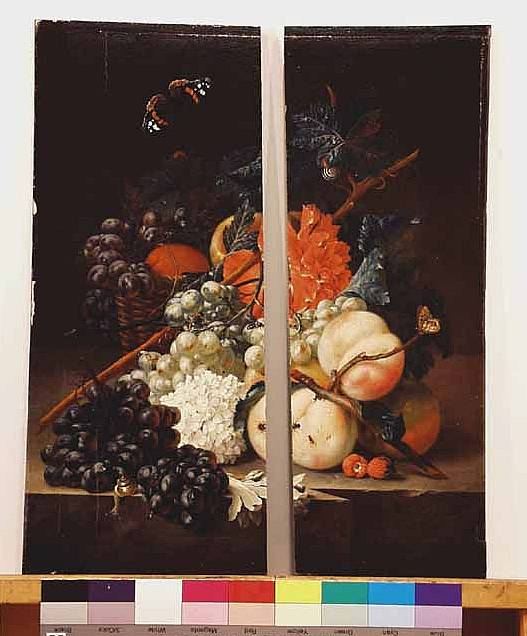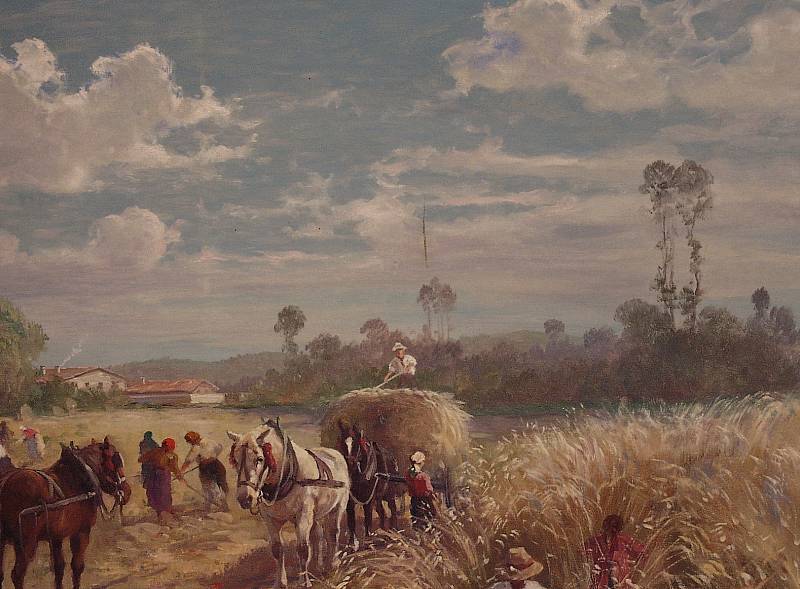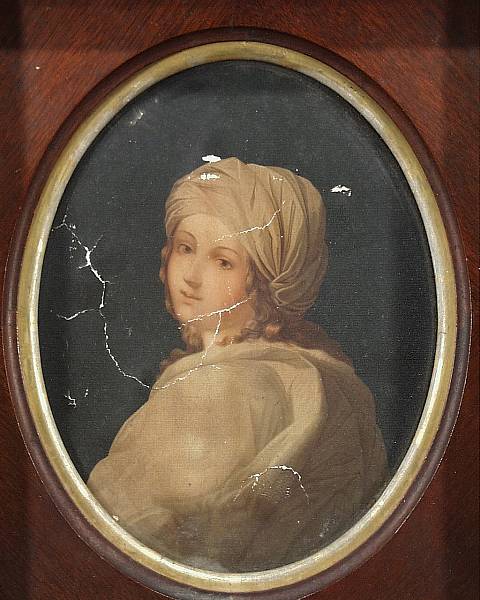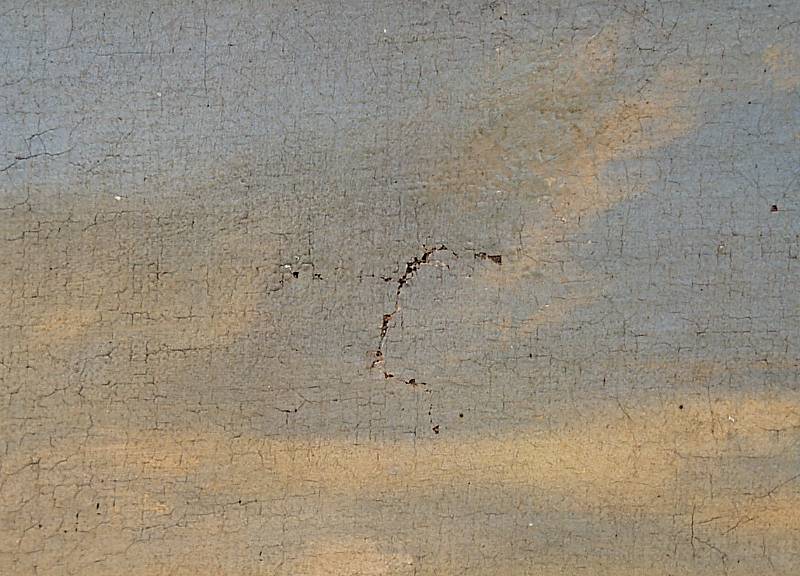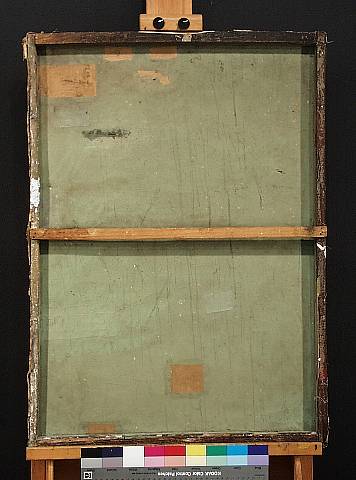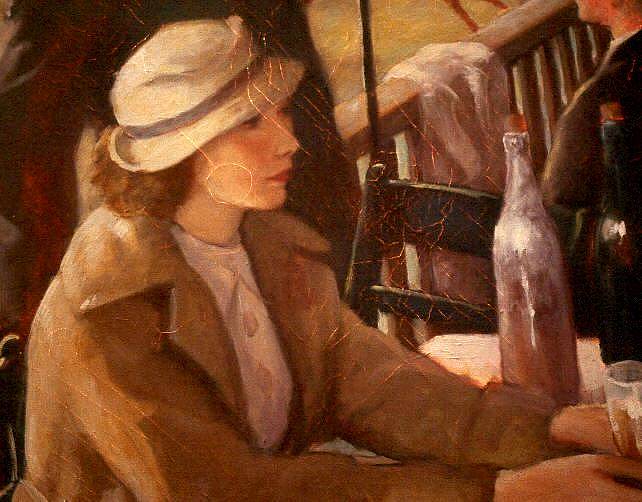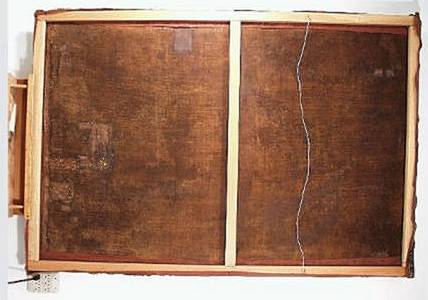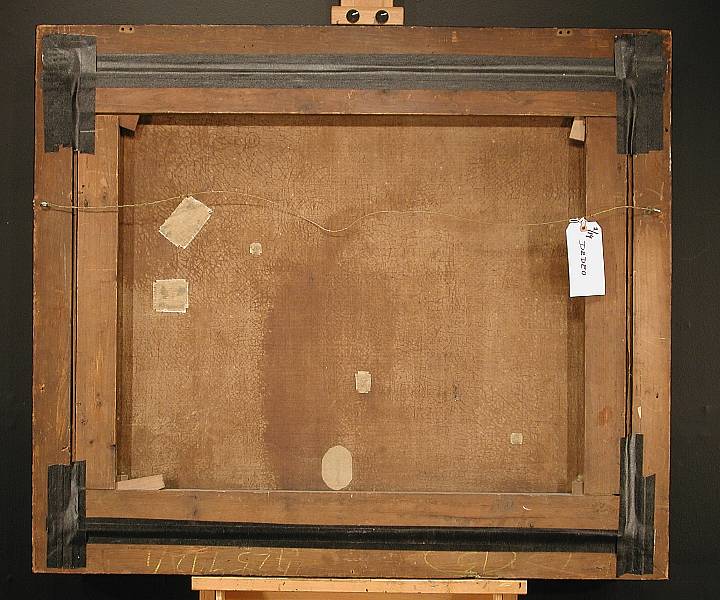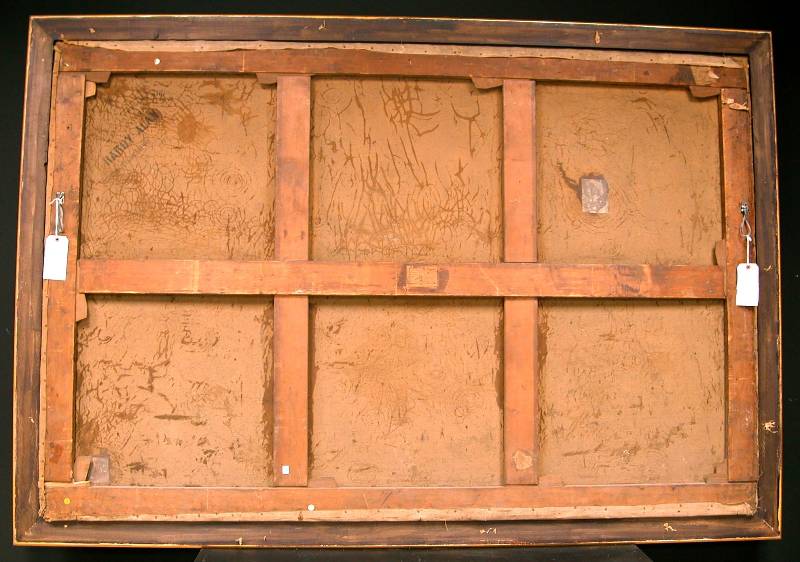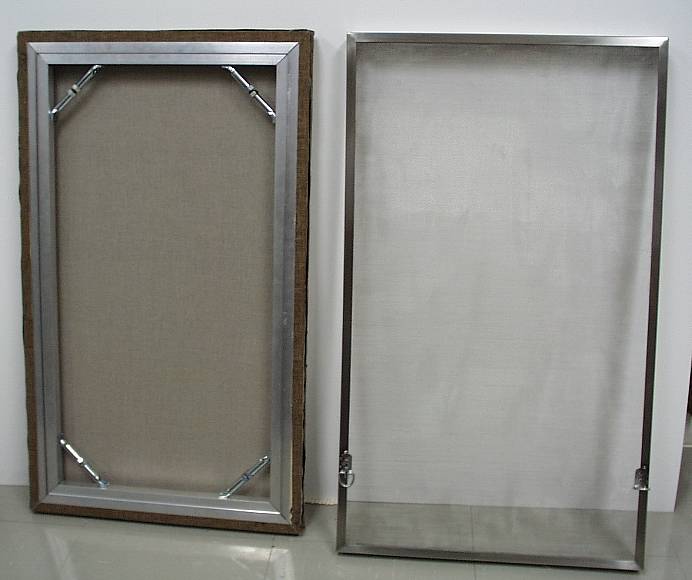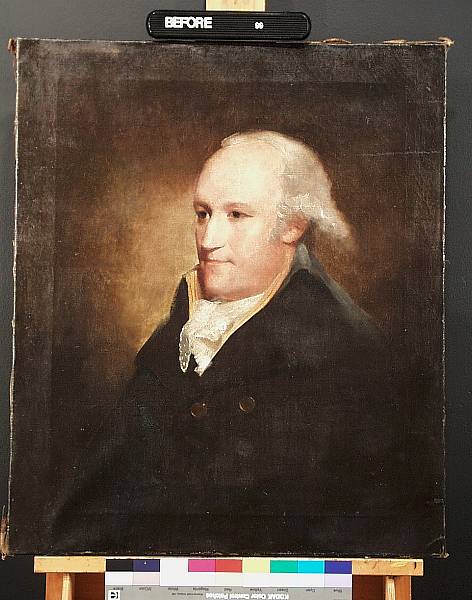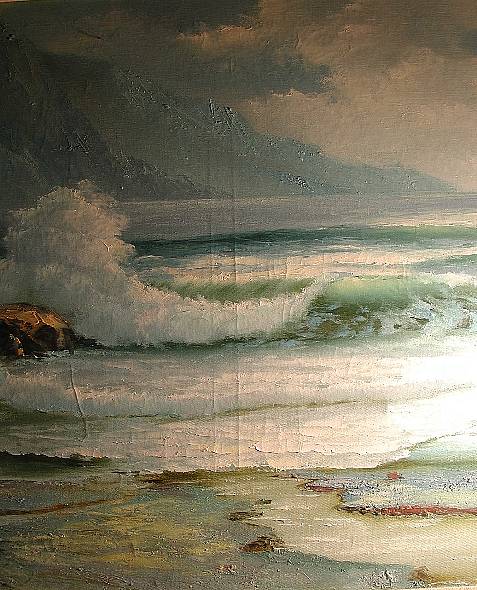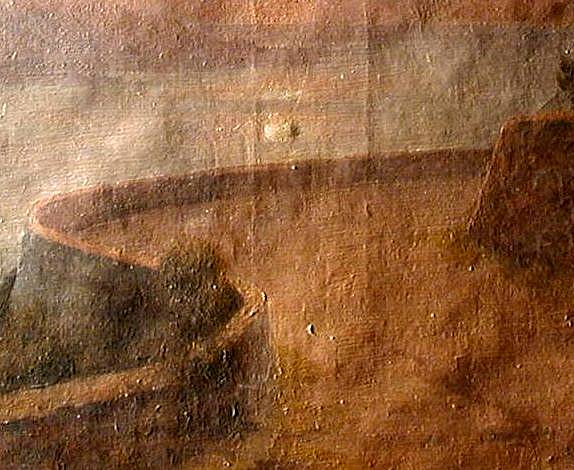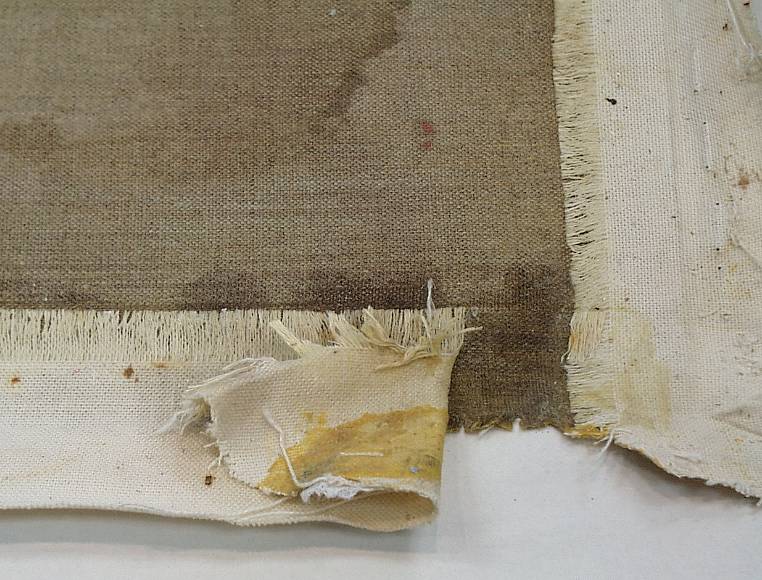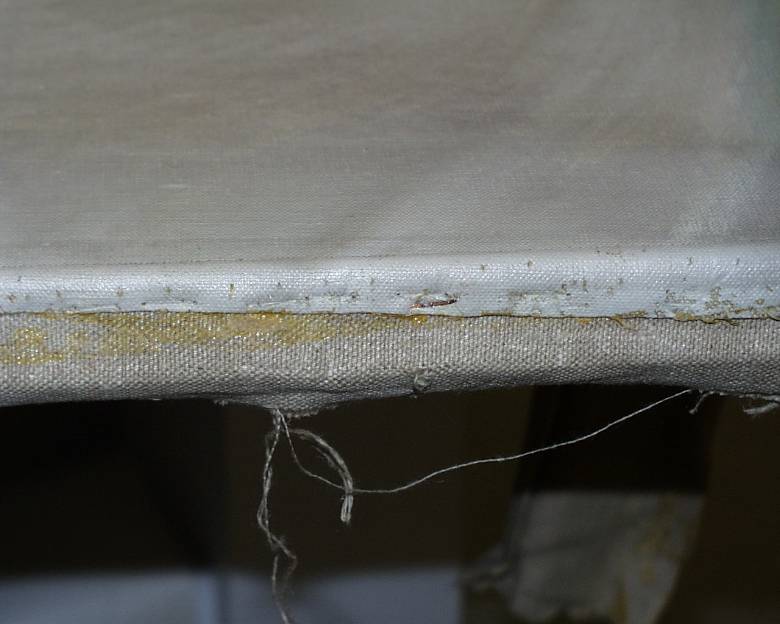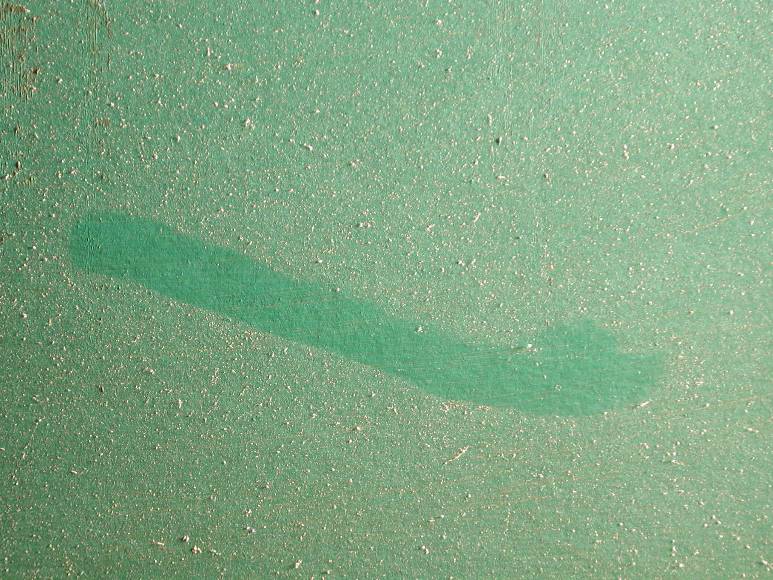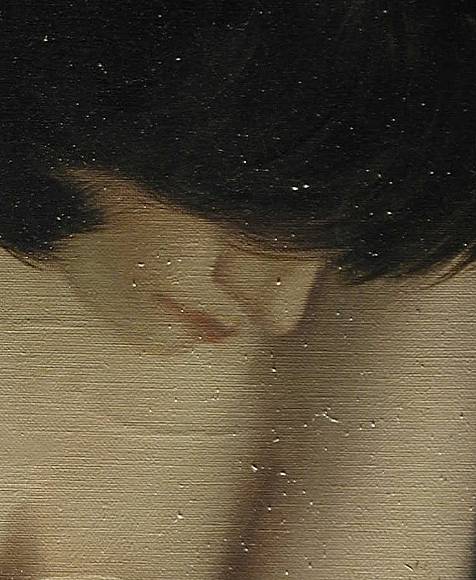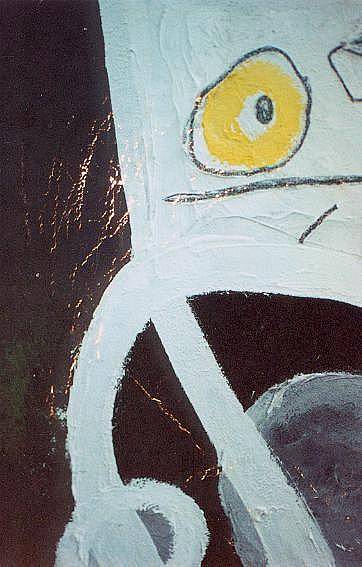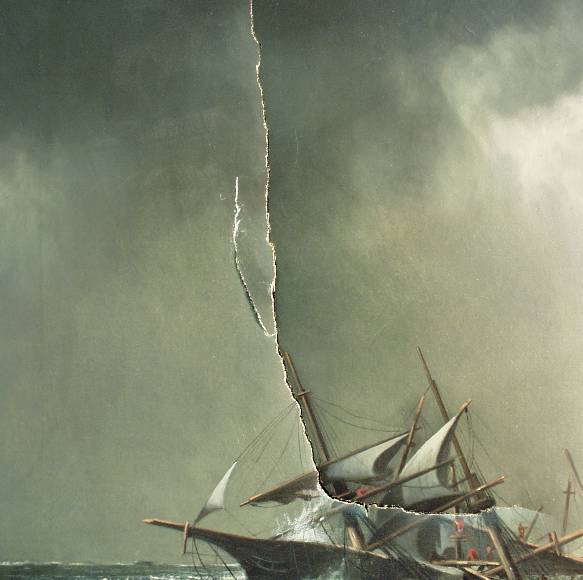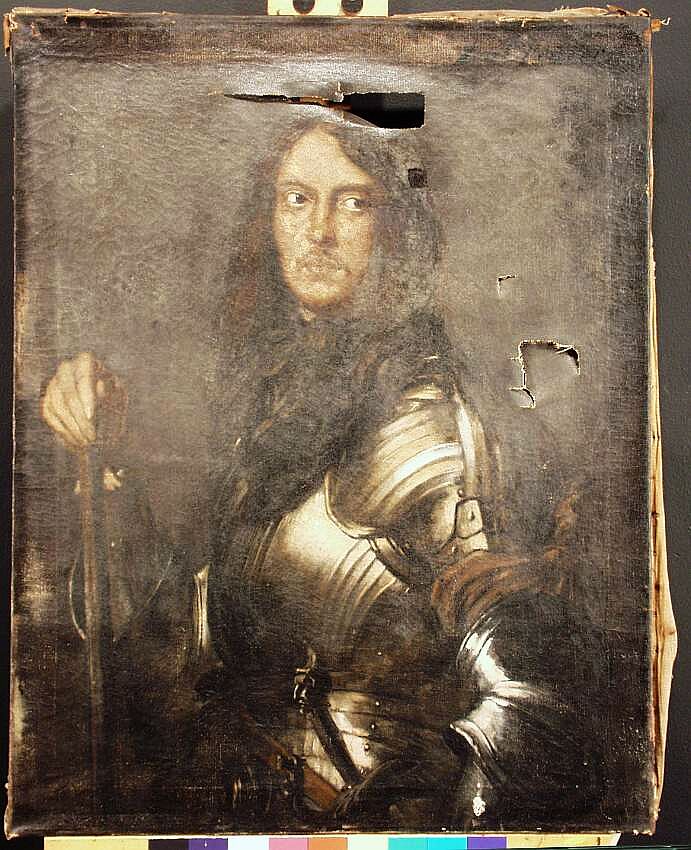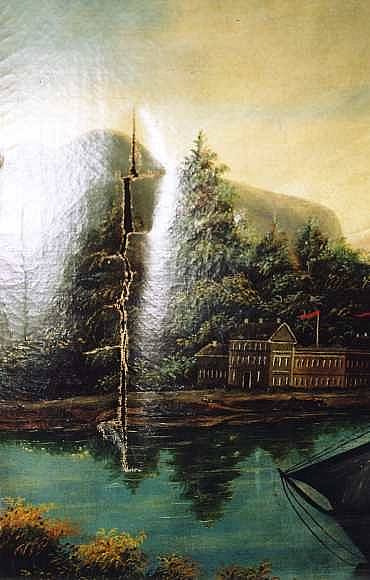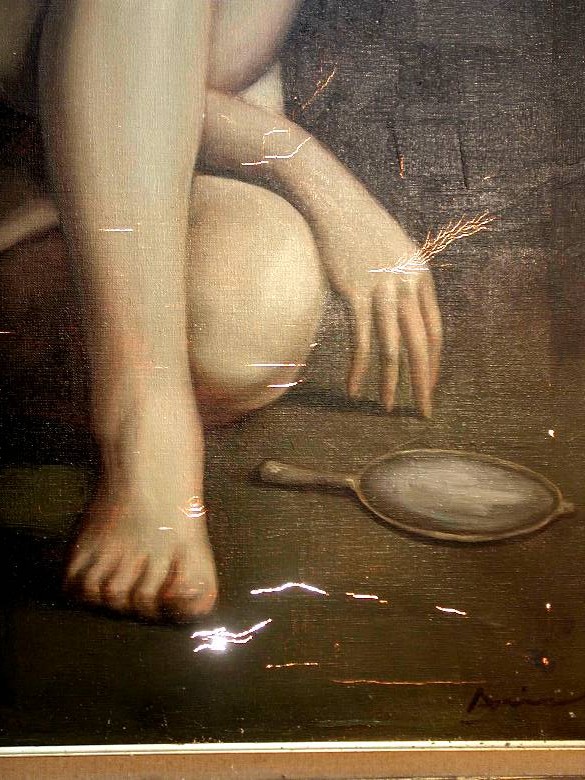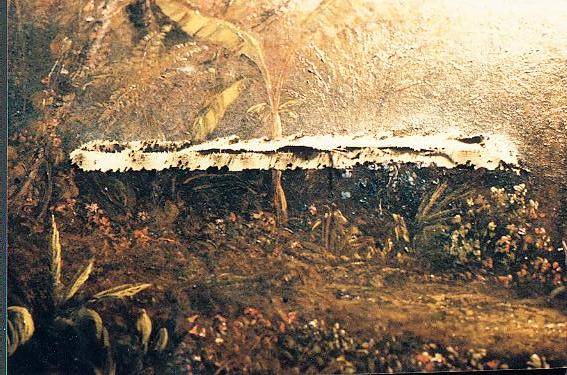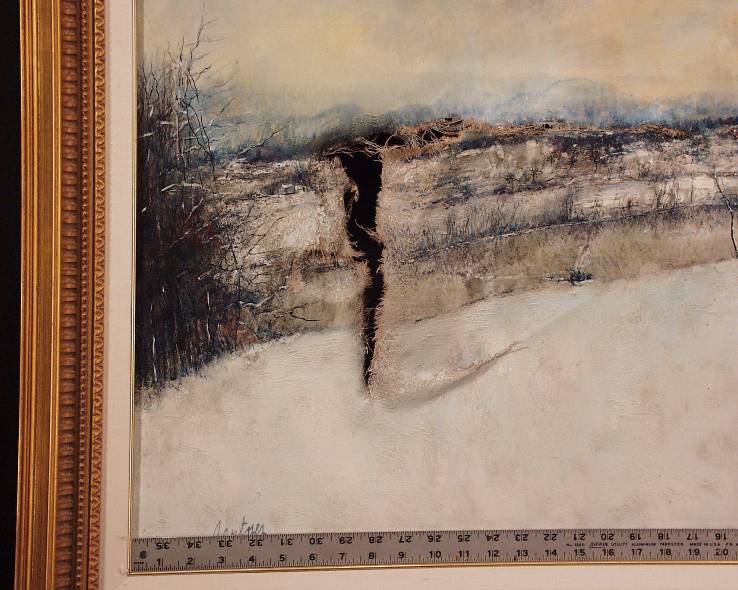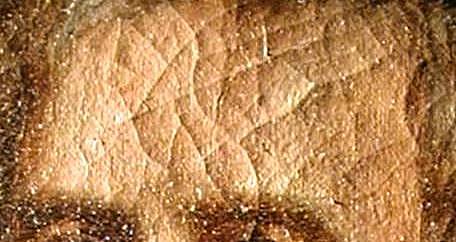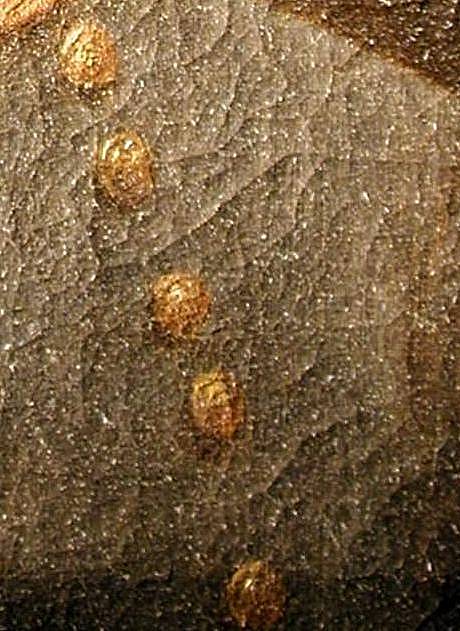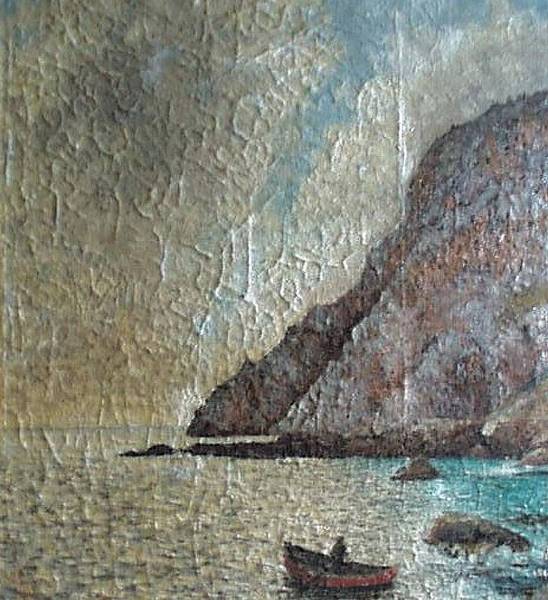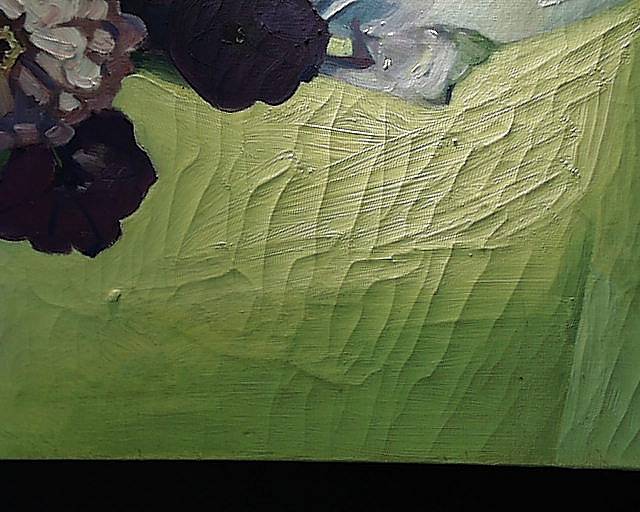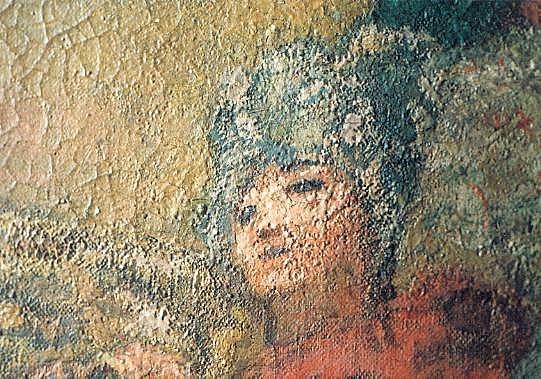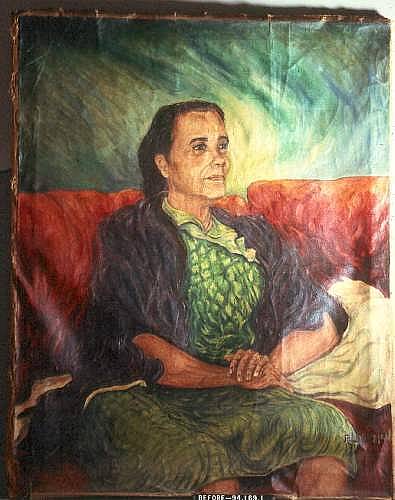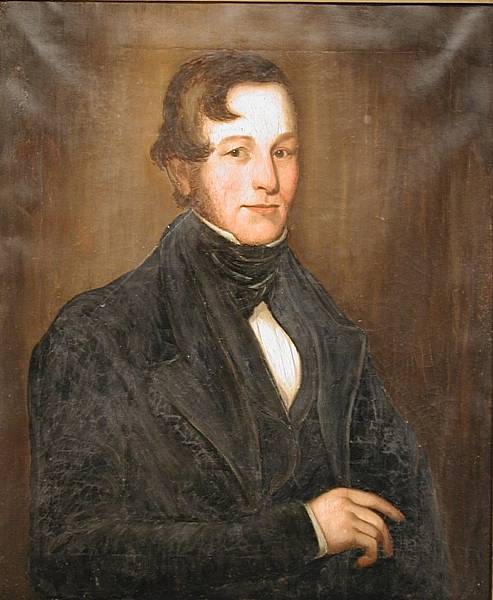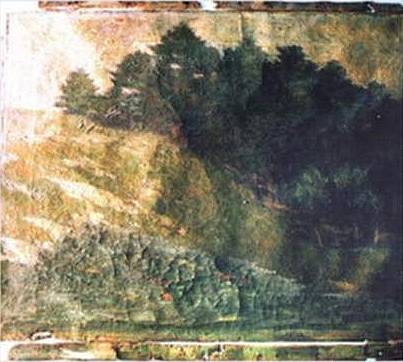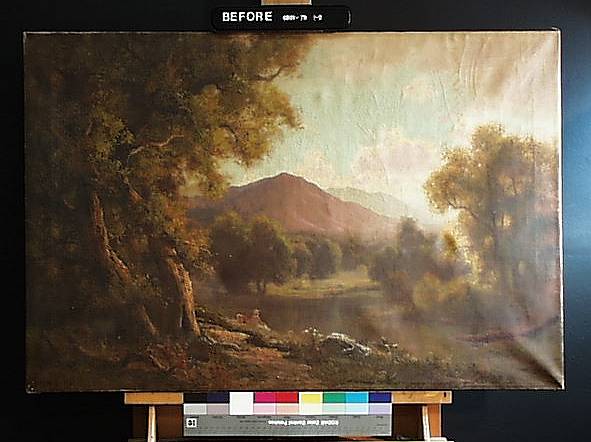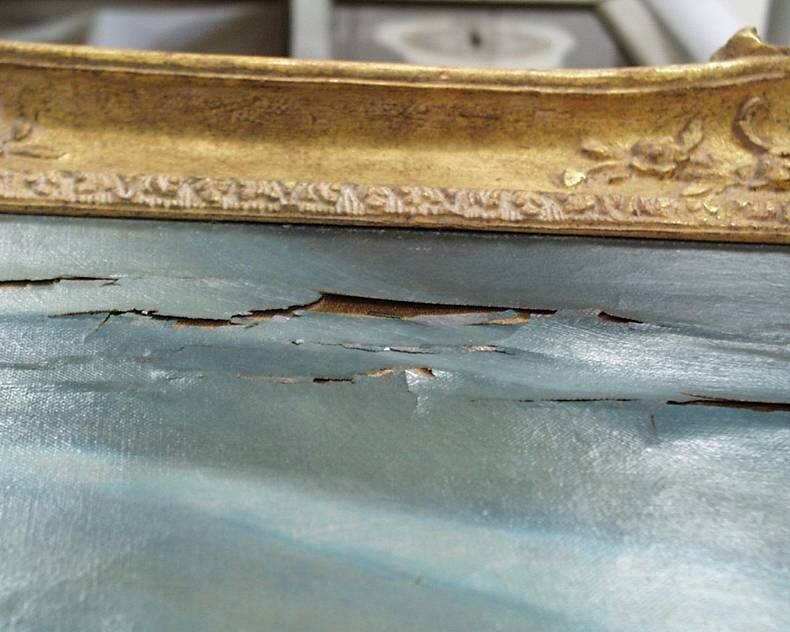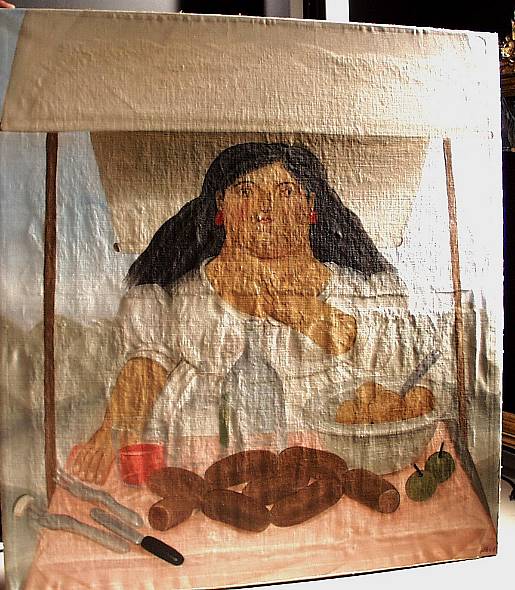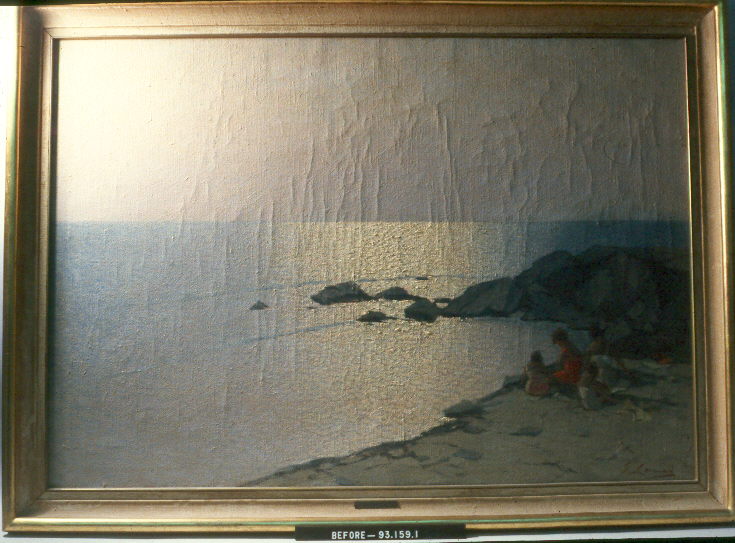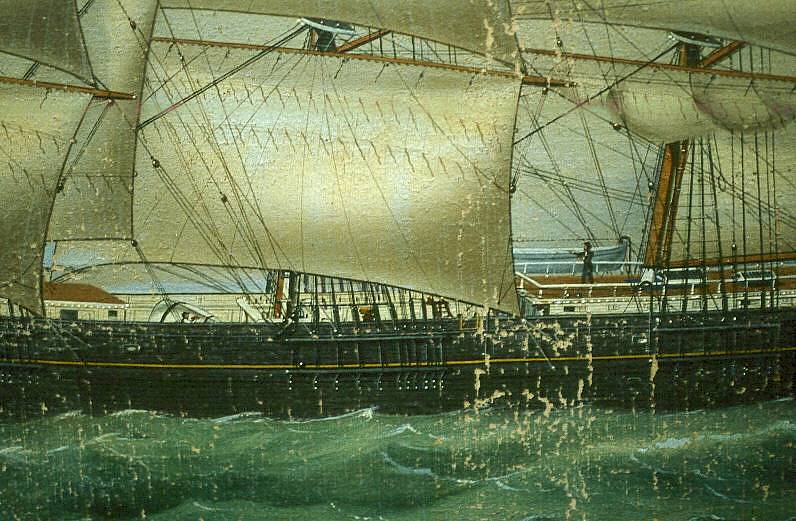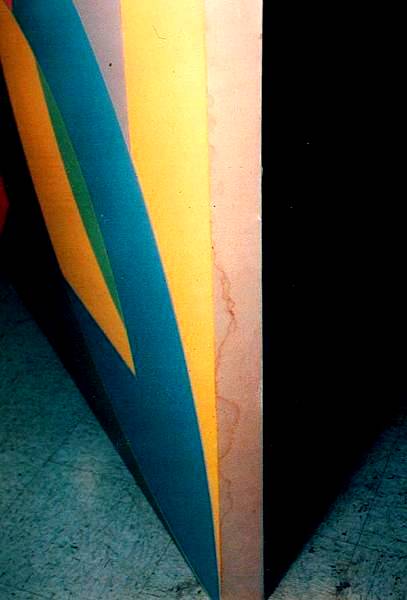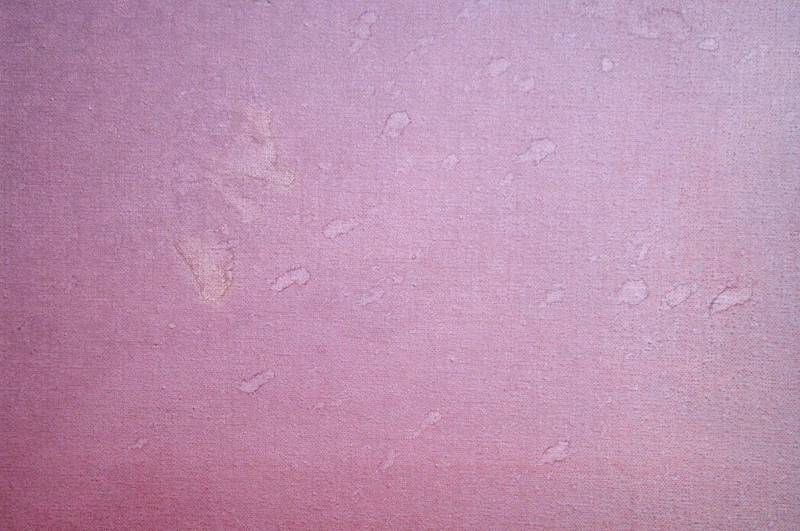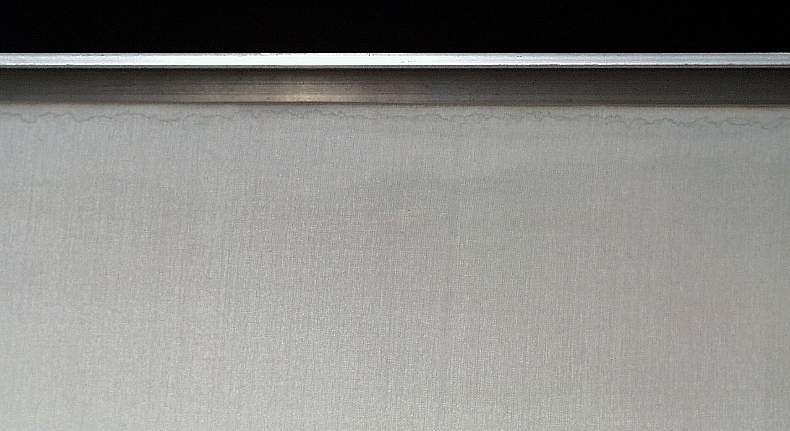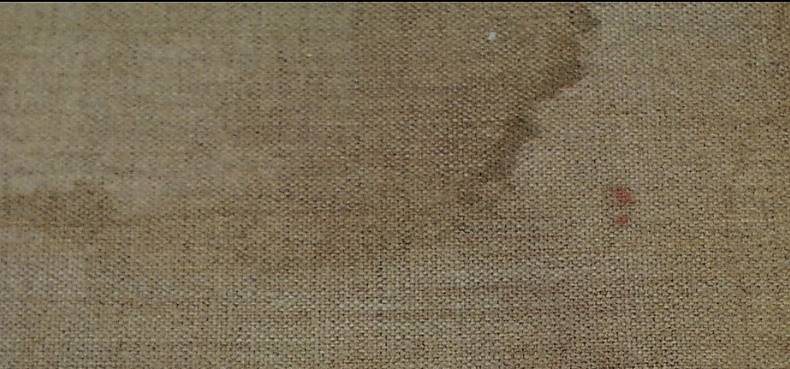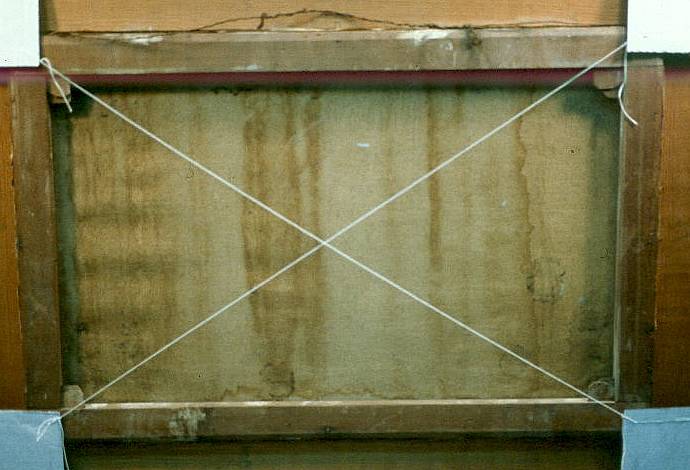| Abrasions: | Loss of media (and often the ground) caused by rubbing or scraping. |
|---|---|
| Accretions: | An accumulation of extraneous matter on the surface of the painting that alters the original design, i.e. dirt, dust, grime, etc. |
| Aging Cracks: | Visible stress as a result of adverse environment conditions, mechanical or other causes that have developed over an extended period of time. The cracks are through all the layers of a painting beginning with the support. The individual cracks or fissures can form a network pattern of straight or barely curved lines. |
| Alligatoring: | The upper paint layers pull away in a pattern similar to the look of an alligator’s hide when the drying process is compromised. The layer below is visible and the upper layer has a raised appearance. Also known as “drying cracks” – see “Drying cracks” for illustrations. |
| Auxiliary Spline: | An attachment contributing stability and/or strength. |
| Backing Removal: | Removal of a previous lining which no longer has structural strength or is creating unintended problems in the painting; there are many ways to remove a backing, ranging from mechanical (scalpel), to heat or to solvents. |
| Bitumen Deformation: | Bitumen paint, a dark paint made from coal tar and frequently used in 19th Century paintings, is subject to deformation resembling burn blisters resulting from an adverse chemical reaction within the paint itself as the paint ages. |
| Blanching: | Milky areas in paint or varnish; a scattering of light from granulation in aged films. |
| Bleeding: | Suffusion of a color into adjacent areas, most often caused by moisture or solvents. |
| Blister: | Disruption causing an area to protrude from the painting’s surface; separation of the paint from the ground, or both layers from the support. |
| Blooming Varnish: | Superficial cloudy area in varnish; most often caused by moisture penetrating the varnish layer. |
| Buckling: | Disruption causing ripples or ridges in canvas. |
| Bulges: | Localized swelling from within or underneath caused by pressure. |
| Burns: | Blistering and/or charring of a paint surface as a result of intense heat, often or associated with a fire or other open heat source. |
| Chalking: | The pigment in a paint layer that has turned to powder. |
| Cleaning: | To remove aged and discolored varnish; to remove dirt, grime or accretions. NOTE: ALTHOUGH CONSIDERED BY MANY TO BE A BENIGN AND ROUTINE PROCEDURE, CLEANING RANKS AMONG THE MOST DANGEROUS OF PAINTING RESTORATION PROCESSES IN UNSKILLED HANDS (SEE “OVERCLEANING”). |
| Cleaning Rear of canvas: | Removing accumulated dirt, dust and grime reduces both damaging weight and tension on the canvas, ground and paint layers while removing acidic materials which physically degenerate the canvas. It must be removed in alternating small squares to avoid damaging excess tension from developing in the canvas, ground or paint. |
| Cleaning Test: | tests performed upon the varnish layer to determine the precise blend of solvents or enzymes, which will successfully remove the varnish (clean the painting) without also removing paint. The results are often dramatic. |
| Cleavage: | Separation and lifting of the paint and ground layers from the canvas; generally associated with cracking of the paint and ground layers. |
| Cockling: | A broad wrinkle or system of wrinkles without creasing. |
| Consolidation: | Procedures to re-adhere flaking or delaminating paint to the canvas. |
| Cracking: | A failure of materials caused by stress. |
| Crackle: | Perpendicular disruption; fine cracks appearing in any of the painting’s layers. |
| Craquelure: | Network of cracks. Caused by the shrinking of the paint or varnish. |
| Crazing: | Microscopic fissures, developed from age, in the varnish layer, distorting light refraction which affects the appearance of haze. In extreme instances the varnish layer becomes opaque. |
| Crushed Impasto: | Impasto (the application of thick layers of paint) leaves distinct patterns of an individual artist’s brushwork often identifying the authenticity of a particular painter’s work – these sharp peaks and well defined valleys are easily crushed through inept restoration where the application of too much heat during lining will soften and partially melt the paint layer itself, crushing it downward, partially or totally flattening it. The distinctive feature of “crushed impasto” is a soft, rolling crest to the top of the impasto. |
| Cupping: | Aged paint, loosened by cracking, with edges curling to create cup-like formations. |
| Crease: | Line or mark made by folding or wrinkling. |
| Cut: | Straight separation in support caused by sharp slicing action. |
| Deformations: | Change or alteration of the overall form of the painting or sections of the painting. |
| Delamination: | Separation of the layer(s) of the ground, paint and/or varnish layer(s). |
| Dent: | A depression made by pressure. |
| Dimple: | Any small, hollow place that has not penetrated through the layers. |
| Dirt /Grime: | Dirt of any kind, which has accumulated on the surface (accretion); may also be embedded into the support (soiling). |
| Dirt Pocket: | When debris accumulates in the gap between the stretcher/strainer and the canvas, it is known as a dirt pocket; these substantially accelerate degradation of a painting and should be regularly cleaned out. |
| Discoloration: | Changes of hues, often uneven and obviously detrimental to the prevailing tones. |
| Draw: | Stretch by tension. |
| Drying Crackle: | A network of cracks from stress to the paint as it dries; sometimes called shrinkage or traction crackle. |
| Drying Cracks: | Curved and wide cracks that occur during the drying stage of the color layers which are a result of the chemical processes and/or physical influences; in the paint layer only. This is one of the major cracks in the paint layer. Also called “Alligatoring” |
| Dust: | Loose fine particles on the surface. |
| Embrittlement: | Canvas has become perceptibly fragile to the point of snapping, crumbling or breaking. |
| Facing: | The adhesion of a protective layer (most often tissue paper upon the face of a fragile painting) to prevent loss of the paint during conservation, or until conservation is performed. |
| Facing Removal: | The procedure for removing a facing. |
| Faded: | Losses of brightness or brilliance of the color(s). |
| Fill: | Material used to replace missing areas of loss, usually in ground layer. |
| Flaking: | Extreme cracking causing paint and/or ground layer to dislodge from the support, often through a combination of cleavage and cracking. |
| Fold: | Bend or double over upon itself. |
| Frame Abrasions: | When the painting is installed in its frame in such a manner that the frame touches the painted surface, the frame will eventually abrade through the paint layer. The danger is that oxidation between the exposed layers will result in the paint peeling from the canvas in ever enlarging areas. |
| Friable: | Insufficient binding media to adhere pigment to the ground layer causing the paint to become powdery, chalky or crumbly. |
| Fumigate: | Arrest insect infestation, mold or other biological growth threatening the work; generally performed by direct application of chemicals or exposure of the work to chemical fumes in a sealed chamber. |
| Ground: | Coating used to prepare canvas or panel for painting. One of the layers of a painting. |
| Hole: | Open or hollow loss in the support, through the varnish. |
| Impact Crackle: | Cracks in radiating circles caused by a blow. |
| Impact Damage: | Multiple losses, abrasions, tears, etc. from a major impact. |
| Inherent Vice: | Existing condition, which causes deterioration of the painting as a result of its original construction. |
| Inpainting: | A restoration process to cosmetically re-establish color and/or detail to losses in the paint layer; generally accomplished with pigment in an appropriate binding medium applied by brush. Also called retouching. |
| Insect Damage: | Numerous species of insects feed upon materials in a painting, inflecting damage, which, if uncontrolled, can be massive. Most occurs on the rear of the canvas, and in extreme cases can leave the paint layer unsupported, causing it to collapse. |
| Insect Detrius: | Droppings and other feeding remains left by insects – generally on the rear of the canvas. |
| Infestation: | An overrun and invasion, generally associated with insects, bacteria, or other micro-organisms such as mold. |
| Insect Resistant Backing: | A fine metal mesh , attached to a metal frame which , in turn encloses the rear and sides of the painting. Both the frame and mesh are of surgical grade stainless steel which is non-reactive with the painting: the mesh itself allows air circulation while preventing entry of insects. This system is excellent for tropical climates, but not recommended for more northern climes. |
| Insecure: | A damaged work, which maybe in the process of deterioration due to weakening of materials or due to weakness in structure or construction; work will probably sustain further damage if moved or handled without immediate attention. |
| Inter-layer Delamination: | With the right internal and external conditions the ground, paint layer and varnish separate from each other. |
| Key: | Piece of wood, which fits into the corners of a stretcher to maintain the tension of the canvas. |
| Lacuna: | Missing paint in a small area. |
| Lifting: | The rising of the paintings surface; layer separation. |
| Lining: | An auxiliary support applied by a conservator to the original support (canvas, etc.) of the painting when the original support no longer has enough strength to carry the weight of the painting. Linings can be constructed from a variety of material, including canvas, fiberglass etc. and may be rigid, semi-rigid or flexible as the need demands. |
| Lining Removal: | When a painting’s lining becomes degraded, it must be removed and replaced (relined). |
| Loose paint: | Areas of the pigmented layer, which have lost adhesion and are no longer firmly fastened to the surface, but are still there. |
| Loss: | Missing area in one or more layers of the painting; most frequently the result of flaking, abrasion, tearing, etc. |
| Medium: | Base, such as oil, varnish, water, etc. containing the pigmentation and used as a vehicle for the pigment. |
| Mold/Mildew: | Any of various fungi growths, which invade many organic surfaces, provided sufficient moisture is present, producing enzymes that dissolve or degrade the host material. |
| Over Cleaned: | See “Skinned”. |
| Overpainting: | Restoration requiring in painting where the restorer does not have skill enough to retouch within the damage area alone without having to extend the restored area substantially beyond the boundaries defined by the damage. |
| Patch: | Small piece of fabric (usually canvas) used to mend a tear or puncture through application (usually adhesion) to the rear of the canvas. |
| Planer Distortion: | See “Warping”. |
| Puncture: | Hole made by impact. |
| Retouching: | See “Inpainting”. |
| Scratches: | Loss on the surface, which may extend to the paint and ground layers caused by marking the surface with something sharp. |
| Skinned: | Where over cleaning has removed original paint Also called “excessive cleaning” |
| Smoke Damage: | Deposition of partially combusted material and it’s accompanying odor: generally resulting from candles, tobacco, fireplace residue or a building fire. |
| Soiling: | Deposition of dirt or other materials upon the face of a painting; this may include fingerprints. |
| Shrinking: | Distortion causing the material to become smaller or more compacted. |
| Split: | A rupture running along the grain of a piece of wood, usually caused by stress. |
| Stain: | A soiled or discolored appearance caused by a foreign substance or uneven aging. |
| Strainer: | Auxiliary support – fabric over wood, fastened tightly at all joints. |
| Stress Cracks: | Various types of external pressure (impacts, etc.) create stress in the ground and paint layers, eventually resulting in cracking of the paint film. |
| Stretcher: | Auxiliary support – fabric over wood, tongued and slotted at its joints to allow tightening. |
| Stretcher Cracks: | Cracks developing in the painting’s corner from over tightening the keys. |
| Stretcher Marks | A crease or line of cracks in the ground or paint layer of a painting, following the inside edges of stretcher members or the edges of cross-members caused by the support touching or resting against the members of the stretcher. |
| Strip Lining: | A partial (or strip of) lining confined to the outer edges of the painting when it is necessary to strengthen the edges but not yet necessary to line the entire canvas. |
| Superficial Grime: | Accumulated dust, grease, smoke and attendant particulate matter, which generally accumulates by precipitation out of the air or by transfer through inappropriate handling. Superficial grime can become imbedded in some instances and can be difficult or impossible to remove. |
| Support: | Material providing the foundation for the painting; most commonly canvas or wood, and occasionally metal, masonite or other materials. |
| Support Failure: | Deteriorated canvas, which no longer has enough strength to support the painting. |
| Tacking Edge: | Edge of fabric on painting used as a means of attachment, turning it over the sides of its auxiliary support. |
| Tear: | A break in fabric as a result of tension. |
| Tenting: | Delaminating of the paint and /or ground along cracks where the delaminated layers lift upward into a pattern resembling the peaked tops of tents. |
| Varnish: | Resins in oil or solvent, used primarily for protecting the surface of the painting. |
| Varnish Aging: | Natural resin varnishes turn first golden in hue and then progressively darker with age, causing a serious distortion of the artist’s original colors. |
| Warping: | A structural distortion of the support whereby the support has become twisted, turned or bent out of shape; no longer flat or in plane. |
| Water Damage: | Lifting, delamination and loss of paint resulting from water coming into contact with the painting and drying. Damage follows the course of the water over the painting. |
| Water Staining: | Staining on the rear of the canvas caused by water coming into contact with the canvas and subsequently drying. Generally accompanies water damage (lifting and delamination) on the front of the painting. Water staining can also occur on the front of contemporary unvarnished paintings. See “Water damage”. |
Degree:
The comparative extent of damage described by the following adjectives:
Negligible:
Insignificant damage that may not need immediate attention but needs to be monitored.
Slight:
Damage slightly more noticeable than “negligible”; should be monitored by a conservator.
Minor:
Existing condition, which is relatively unimportant; generally does not involve risk of loss; should be monitored by a conservator.
Moderate:
Damage is noticeable and may be of middle or increasing severity of size; not serious but should be monitored or corrected by a conservator.
Marked:
Readily identified damage, often with distinctive features and requires remediation by a conservator.
Major:
Damages or existing condition are noticeable, if not conspicuous in extent; stability of the work is in question, often great risk is a factor. Requires immediate attention by a conservator to prevent further damage or loss.
Extreme:
Most severe damage or existing condition has become very advanced. The work is insecure, no longer stable and at great risk.
It is important to understand that damage to a work of art is rarely static and the work will continue to deteriorate. It is best to have a conservator monitor works annually.


